New Arctic
An Associated Press reporting team sailed through the Arctic Circle’s fabled Northwest Passage on an icebreaker to document the changes global warming has wrought in one of the world’s most fragile environments. During their trip, which turned out to be the earliest crossing of the passage, the team used text, fresh and archival photos, 360 and standard video, animations and data visualizations to give readers an up-close look and understanding of the leading edge of climate change.
Dispatches
Text and Photos David Goldman
It’s a special privilege for a photographer to get the chance to work in the soft light of a sun that never sets.
Photos David Goldman | Text Frank Jordans | Video David Keyton
For much of the year, the Arctic appears as a crumpled white sheet of ice and snow before great chunks break off around the edges in spring, forming a sea of floes that gently dance across the frigid waters.
Photos by David Goldman
While it may be frigid and wet on deck, the crew of a modern icebreaker can expect creature comforts inside the ship.
Photos David Goldman | Text Frank Jordans
The MSV Nordica is as robust a ship as you can find, but striking out to sea —especially in the remote and icy Arctic— always carries a risk.
Photos David Goldman | Text Frank Jordans
They packed a full line-up of wide angle, fixed focal length, zoom and telephoto lenses to go with their Canon DSLR camera bodies; a Panasonic P2 video camera; and several GoPro action cams with external microphones.
Photos David Goldman | Text Frank Jordans
The ship hadn’t yet left Vancouver for the Arctic Circle’s Northwest Passage when the icebreaking began — with a round of “introduce yourself to the others.”
Photos David Goldman | Text Frank Jordans
Learning to drive an icebreaker like the MSV Nordica is a bit like taking dance lessons.
Photos David Goldman | Text Frank Jordans
When ice floes stretch to the horizon in the Arctic Circle, threatening to strand normal ships, icebreakers are in their element.
Photos David Goldman | Text Frank Jordans
European explorers had long speculated about the existence of an Arctic route that connected the Atlantic and Pacific Oceans and would avoid the long journey around South America’s Cape Horn.
Photos David Goldman | Text Frank Jordans
The international date line is an imaginary border that runs through the middle of the Pacific Ocean and marks the boundary between calendar dates, effectively making it the zero-line for the planet’s time zones.
Photos David Goldman | Text Frank Jordans | Video David Keyton
More than a century has passed since the first successful transit of the treacherous, ice-bound Northwest Passage by Norwegian explorer Roald Amundsen in 1906.
Photos
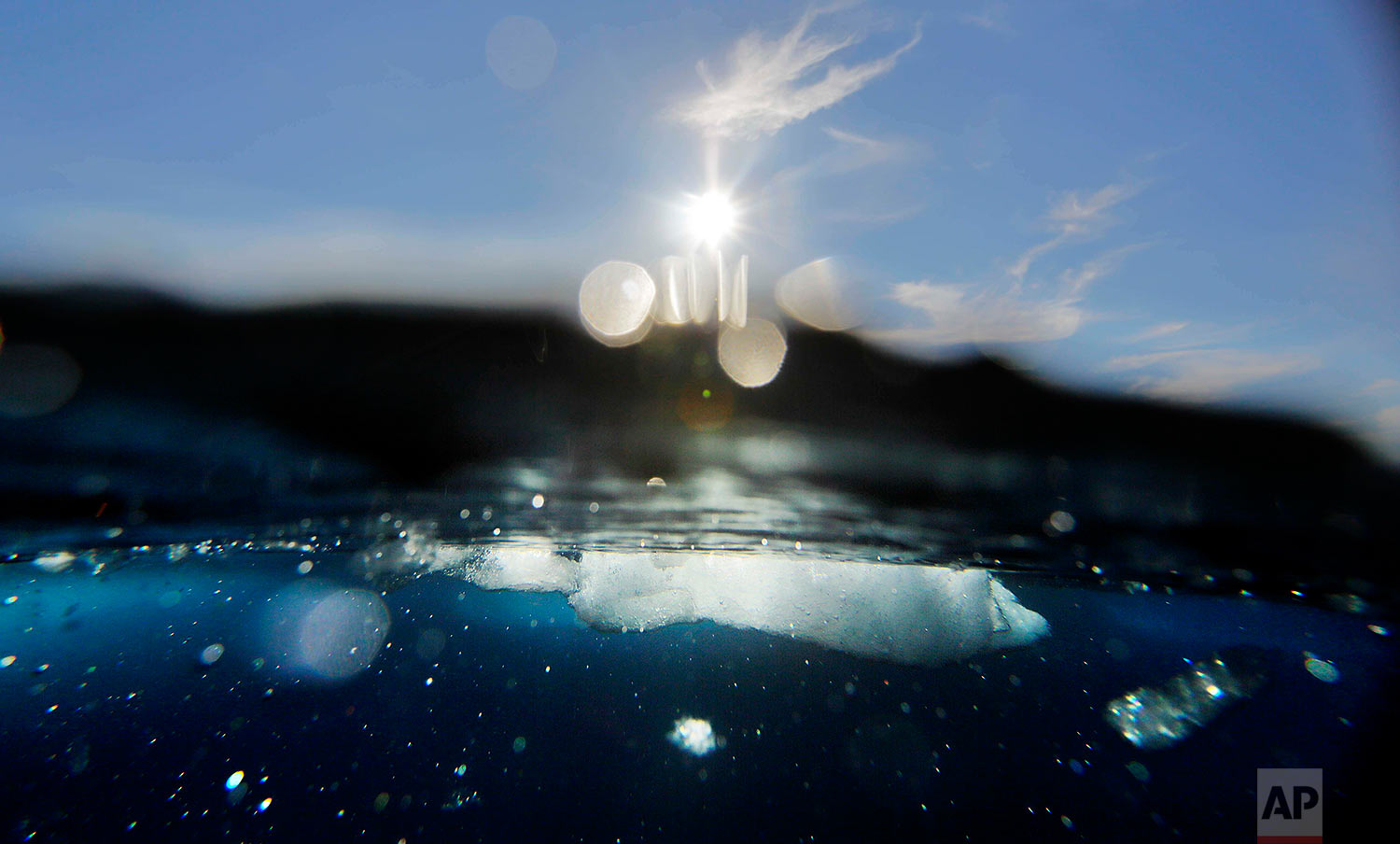
A block of sea ice floats in the Victoria Strait in the wake of the Finnish icebreaker MSV Nordica as it sails the Arctic's Northwest Passage, Friday, July 21, 2017. Sea ice forms when the top layer of water reaches freezing point, usually around the start of October. As temperatures continue to fall this first-year ice grows downward until it is several feet thick. If the ice survives the following summer melt it becomes second-year ice. Another cycle and it becomes multi-year ice, which is the toughest kind. (AP Photo/David Goldman)
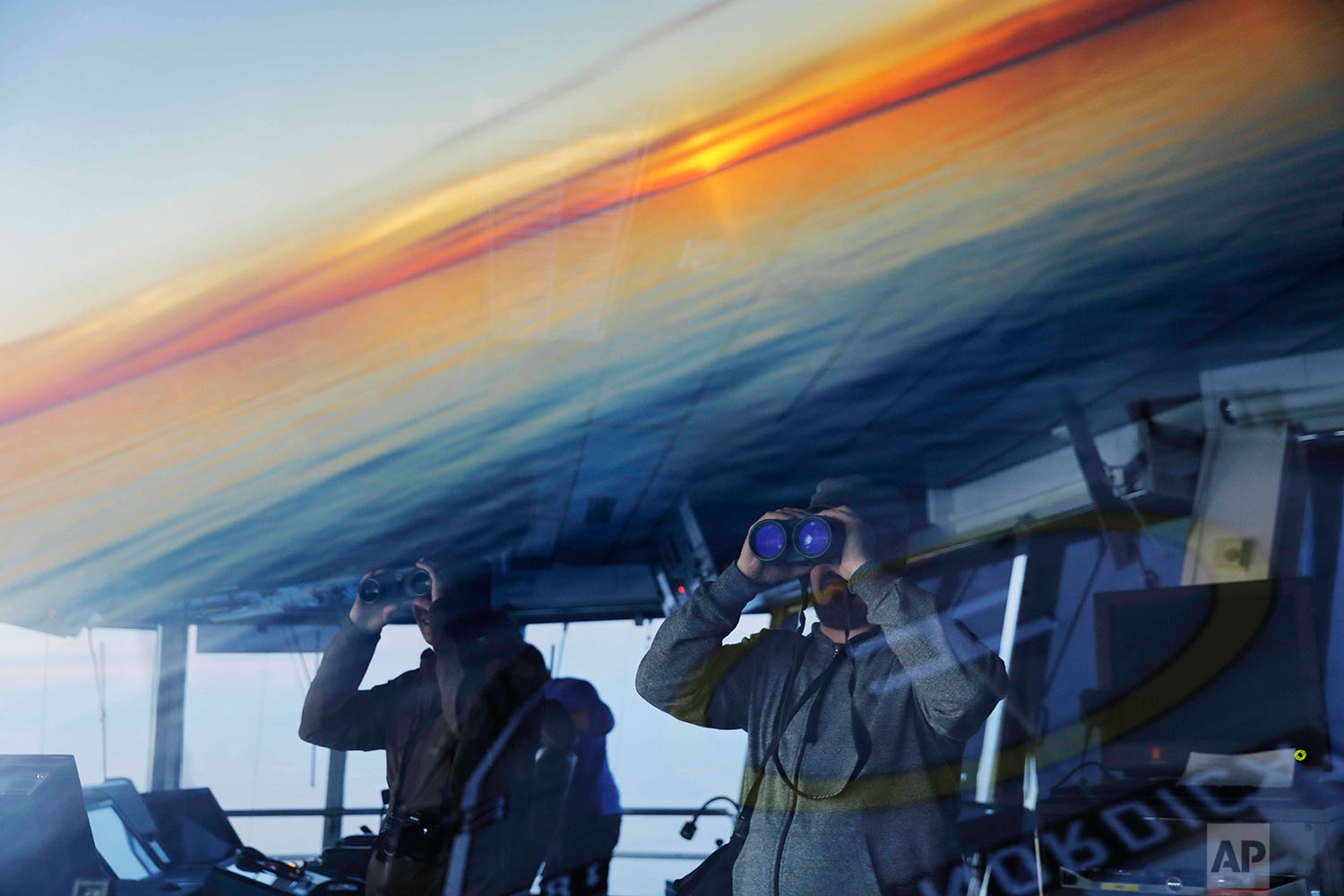
Researchers look toward the midnight sun while approaching the American island of Little Diomede, Alaska, and the Russian island of Big Diomede, as the Finnish icebreaker MSV Nordica sails along the international date line through the Bering Strait, Friday, July 14, 2017. The international date line is an imaginary border that runs through the middle of the Pacific Ocean and marks the boundary between calendar dates, effectively making it the zero-line for the planet’s time zones. (AP Photo/David Goldman)

Researcher Daria Gritsenko, 30, of the University of Helsinki, sits for a portrait in her cabin aboard the Finnish icebreaker MSV Nordica as the ship sails north in the Bering Sea toward the Arctic, Thursday, July 13, 2017. She is hoping to learn more about the Northwest Passage to aid her work in energy development in the Arctic. Although this will be her first transit through the passage, she has been to Svalbard, a Norwegian archipelago in the Arctic. "I love the Arctic. It's such a powerful nature that I felt so little in comparison," she said. "It makes you realize how much of dust you are on this planet. It's very intimidating but I felt very calm inside." (AP Photo/David Goldman)
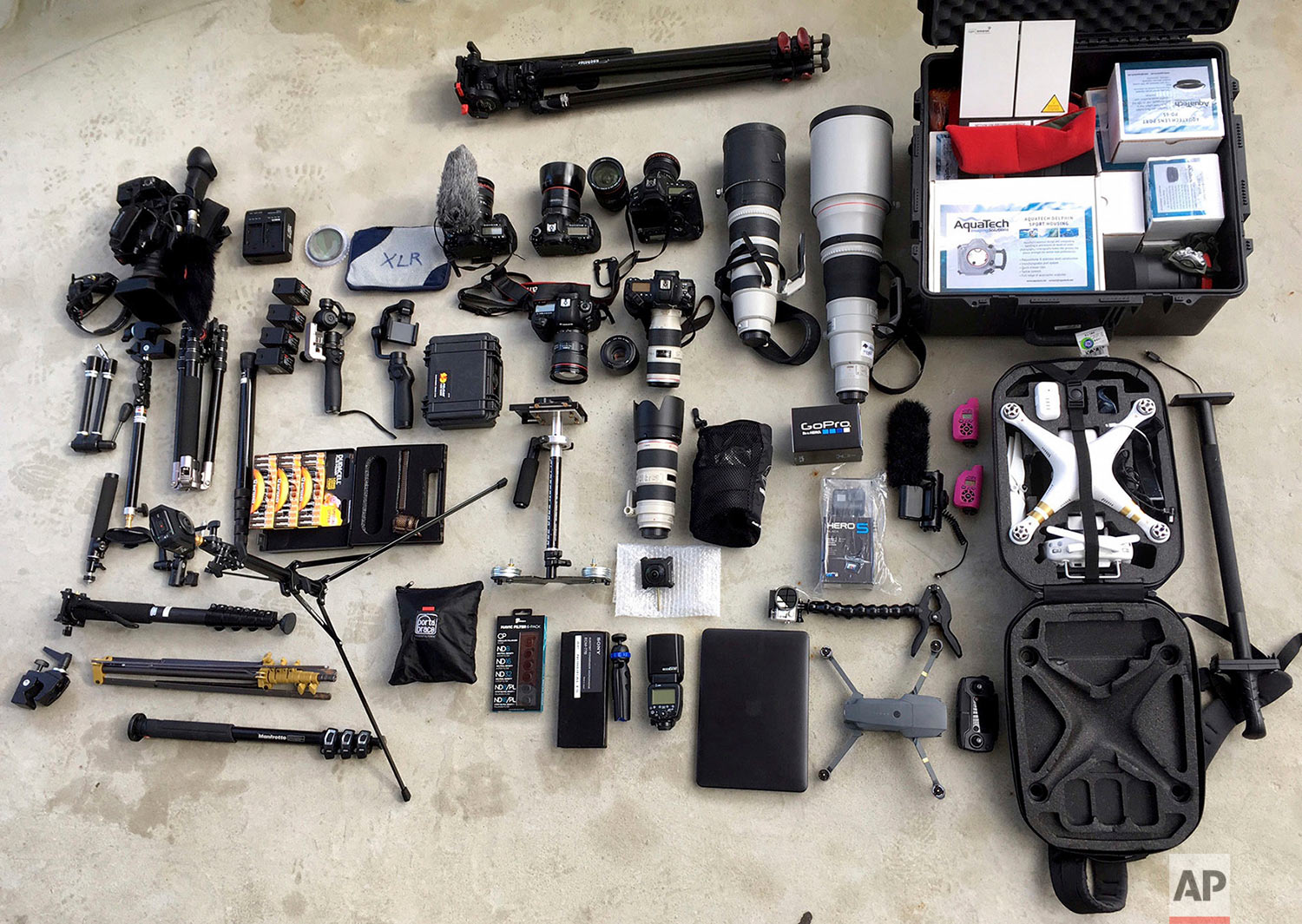
Photography and video equipment brought along by an Associated Press team on assignment aboard the Finnish icebreaker MSV Nordica is laid out on the ship's deck Saturday July 8, 2017, while sailing toward the Bering Strait in the North Pacific Ocean. The AP is accompanying a group of international researchers is sailing into the Arctic Sea aboard the Finnish icebreaker to traverse the Northwest Passage and record the environmental and social changes that are taking place in one of the most forbidding corners of the world. (AP Photo/David Goldman)
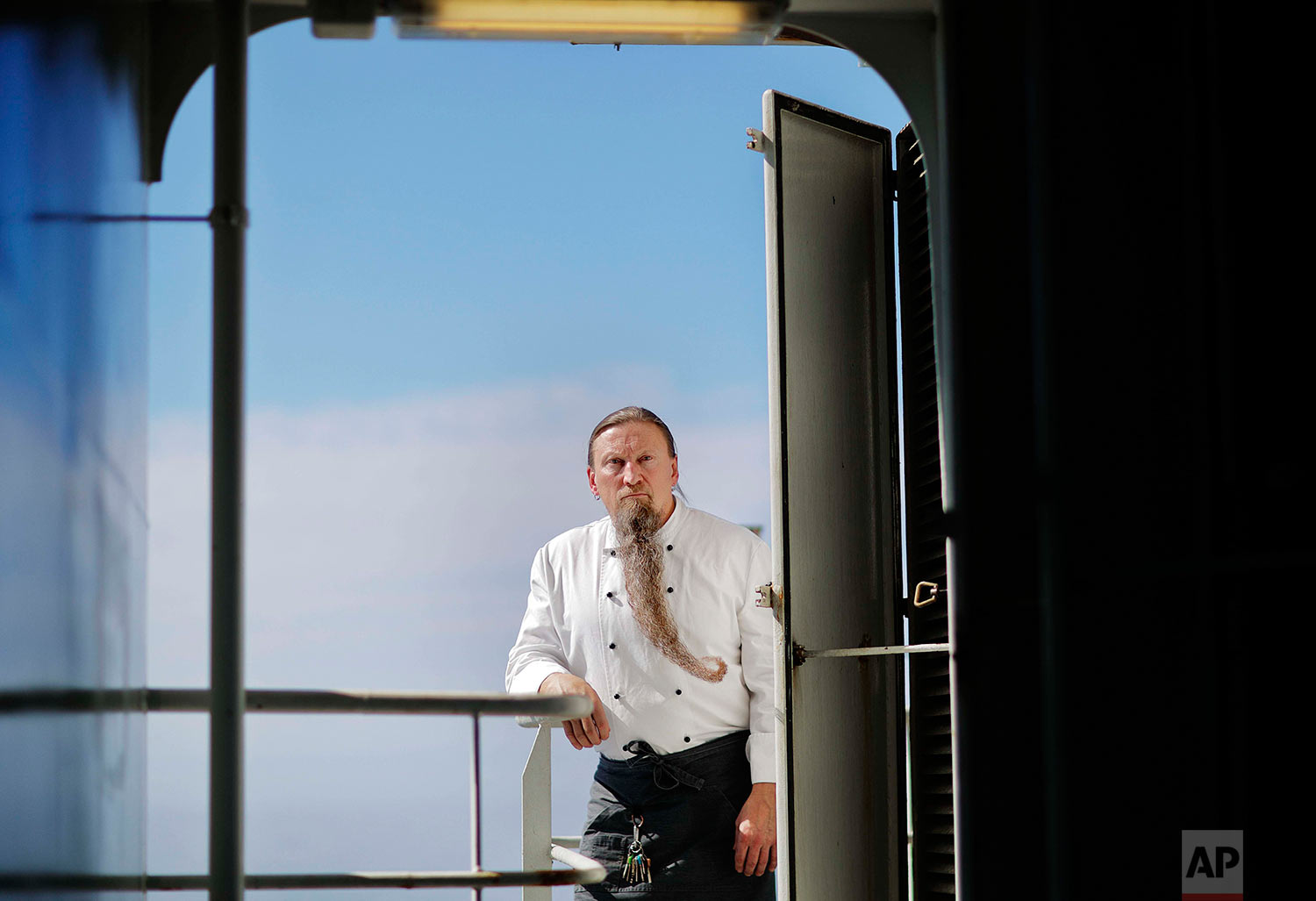
Chief steward Mika Tiilikka, 54, stands for a portrait aboard the Finnish icebreaker MSV Nordica as the ship sails north in the Chukchi Sea in the Arctic, Friday, July 14, 2017. Tiilikka, who has been growing his beard for 17 years, has worked aboard icebreakers since 2002 and spends about half the year at sea. He told his mother at the age of four that he wanted to be a chef and a sailor and grew up learning her recipes like sauerkraut and pork soup. "She's my inspiration," Tiilikka said. (AP Photo/David Goldman)
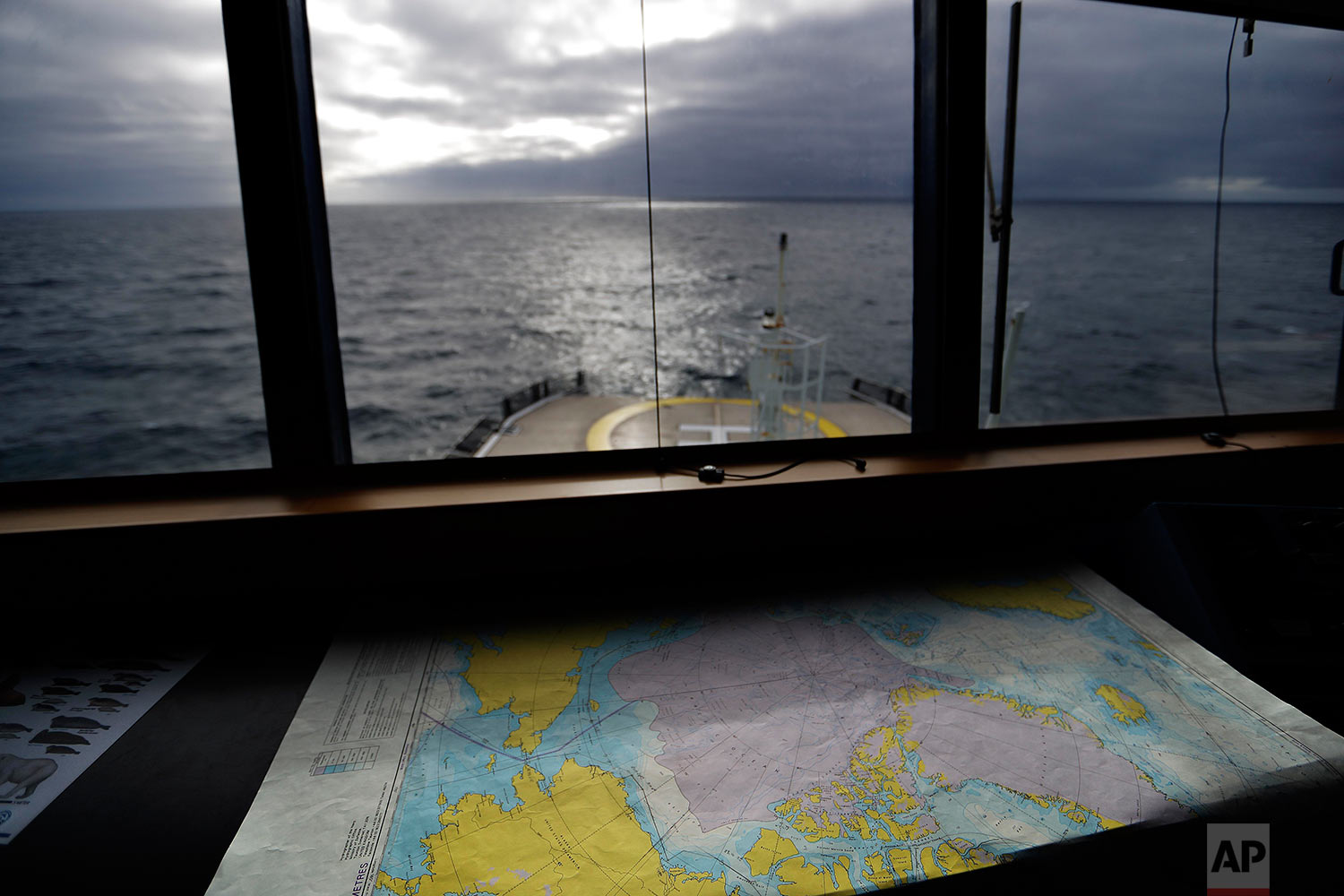
A map of the Arctic Ocean overlooks the bow of the Finnish icebreaker MSV Nordica as it sails in the North Pacific Ocean toward the Bering Sea on Sunday, July 9, 2017. While icebreakers are equipped with sensitive radar systems, ultimately it's up to the ability and experience of the person at the helm to ensure the ship only breaks ice when it’s unavoidable. (AP Photo/David Goldman)
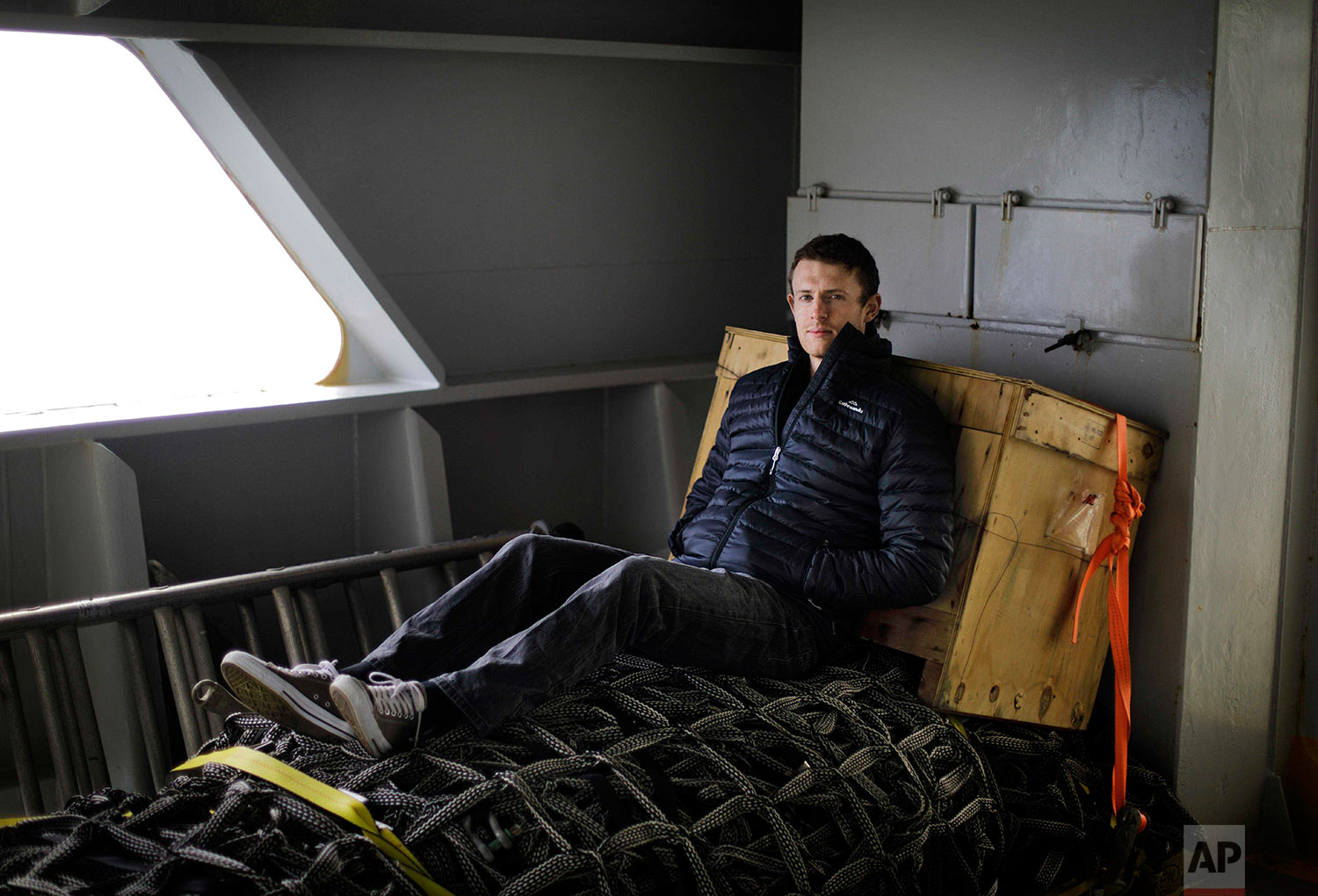
Polar maritime lawyer Scott Joblin, 30, sits for a portrait aboard the Finnish icebreaker MSV Nordica as it sails north in the Bering Sea toward the Arctic, Wednesday, July 12, 2017. "It's a chance to ground my research in real world context," said Joblin who is pursuing his doctorate in international law at Australian National University. "I don't think the size or the scale [of the Arctic] is anything you can comprehend. The trip so far contextualizes how hard it is to get there," said Joblin of the roughly nine days the ship will take to reach the Arctic Circle from its departure in Vancouver. "It's really the frontier as it exists." (AP Photo/David Goldman)
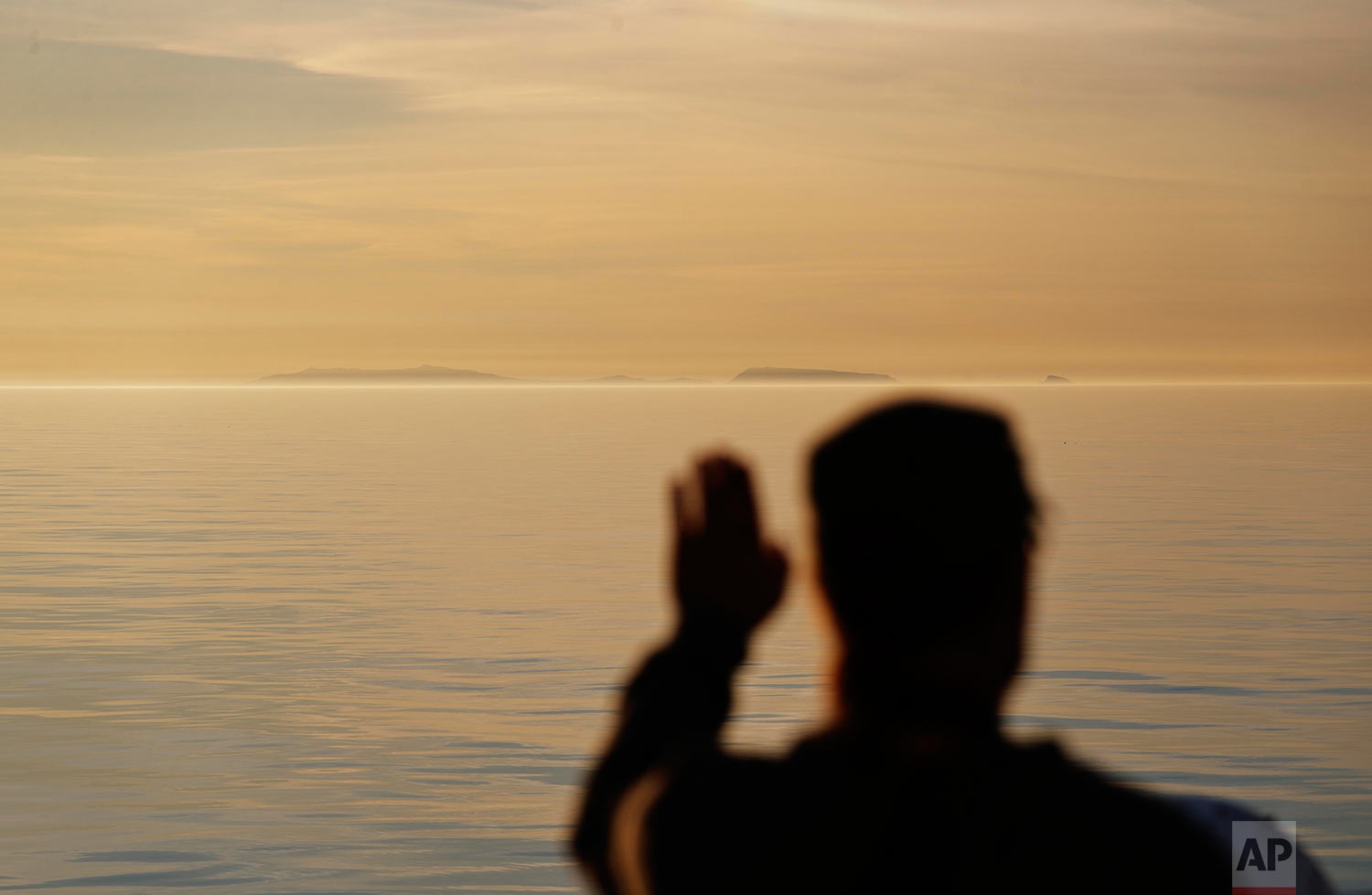
Researcher Ari Laakso shields his eyes from the midnight sun while approaching the American island of Little Diomede, Alaska, right, and the Russian island of Big Diomede, left, as the Finnish icebreaker MSV Nordica sails along the international date line through the Bering Strait, Friday, July 14, 2017. The international date line divides the two islands, putting them currently 20 hours apart despite roughly 2.4 miles (3.8 kilometers) between them. Due to this time difference, Little Diomede is sometimes referred to as Yesterday Isle and Big Diomede as Tomorrow Island. (AP Photo/David Goldman)
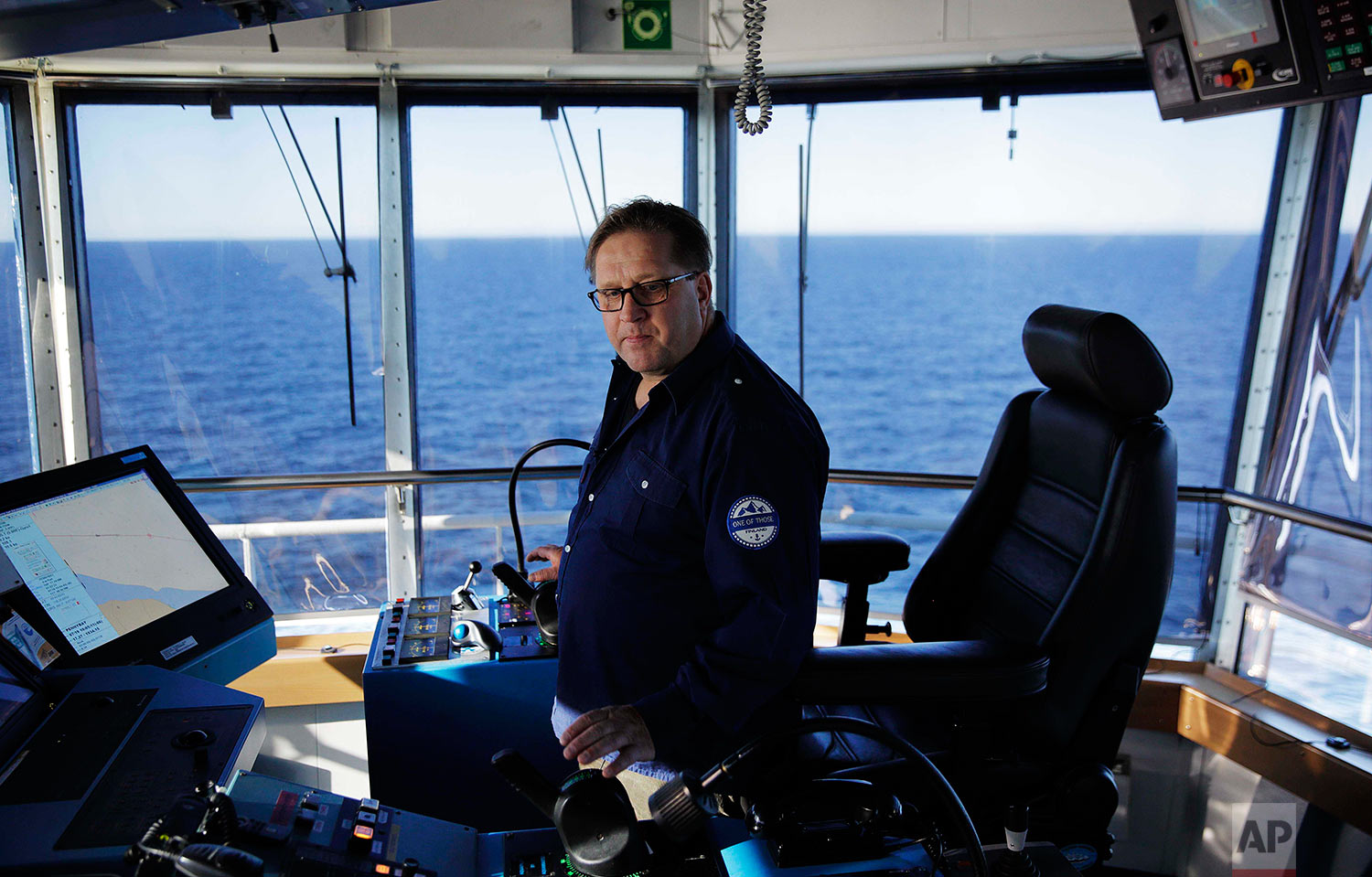
Master Mariner Jyri Viljanen, captain of the Finnish icebreaker MSV Nordica demonstrates the ship's maneuverability while sailing the Dolphin and Union Strait off the coast of Canada through the Arctic's Northwest Passage, Wednesday, July 19, 2017. According to Viljanen, only lots of supervised practice can adequately prepare a person for the challenges of steering the 13,000 ton ship. (AP Photo/David Goldman)

Ice is broken up by the passing of the Finnish icebreaker MSV Nordica as it sails through the Beaufort Sea off the coast of Alaska while traversing the Arctic's Northwest Passage, Sunday, July 16, 2017. The region has become a magnet for nations wanting to exploit the Arctic’s rich oil reserves and other natural resources and for scientists seeking to understand global warming and its impacts on the sea and wildlife. (AP Photo/David Goldman)

Trainee Maatiusi Manning, 33, of Cape Dorset, Nunavut, in Canada's northern territories, sits for a portrait on his bunk while resting from sea sickness aboard the Finnish icebreaker MSV Nordica as sails in the North Pacific Ocean toward the Bering Strait, Monday, July 10, 2017. "I knew I was going to get sea sick at some point," said the father of two who is trying his hand at ship work after working a series of labor jobs back home. "I'm trying to figure out if it's for me but it's a trip of a lifetime. It's very special. You have to be a little crazy to be on a trip like this." (AP Photo/David Goldman)
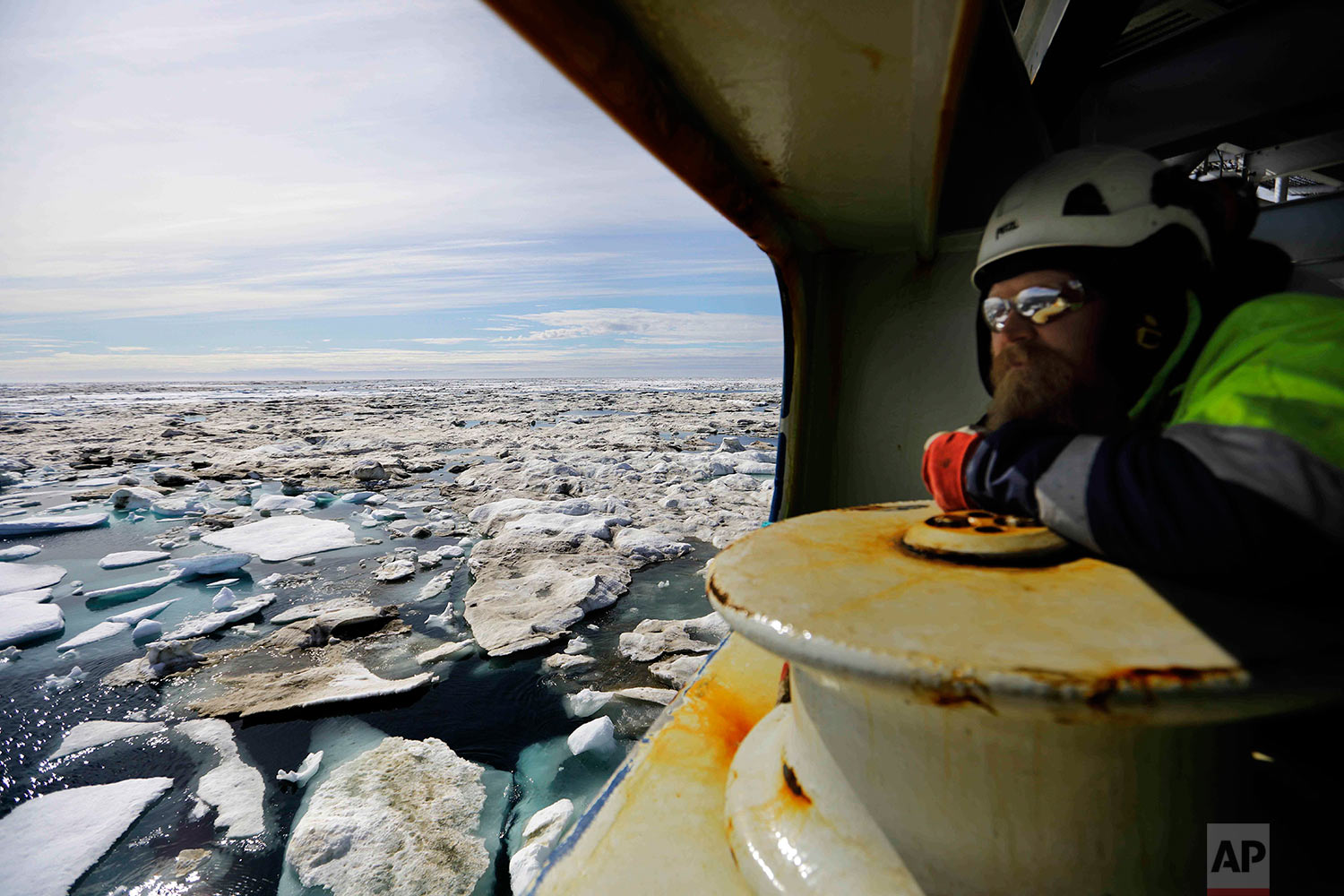
Trainee Jussi Mikkotervo looks out from the bow of the Finnish icebreaker MSV Nordica as it sails through ice floating on the Beaufort Sea off the coast of Alaska while traversing the Arctic's Northwest Passage, Sunday, July 16, 2017. Although the passage presents an attractive shortcut for maritime traffic between the Pacific and Atlantic oceans, only a dozen or two vessels attempt to navigate the poorly charted Canadian Arctic Archipelago during the brief summer window each year. (AP Photo/David Goldman)
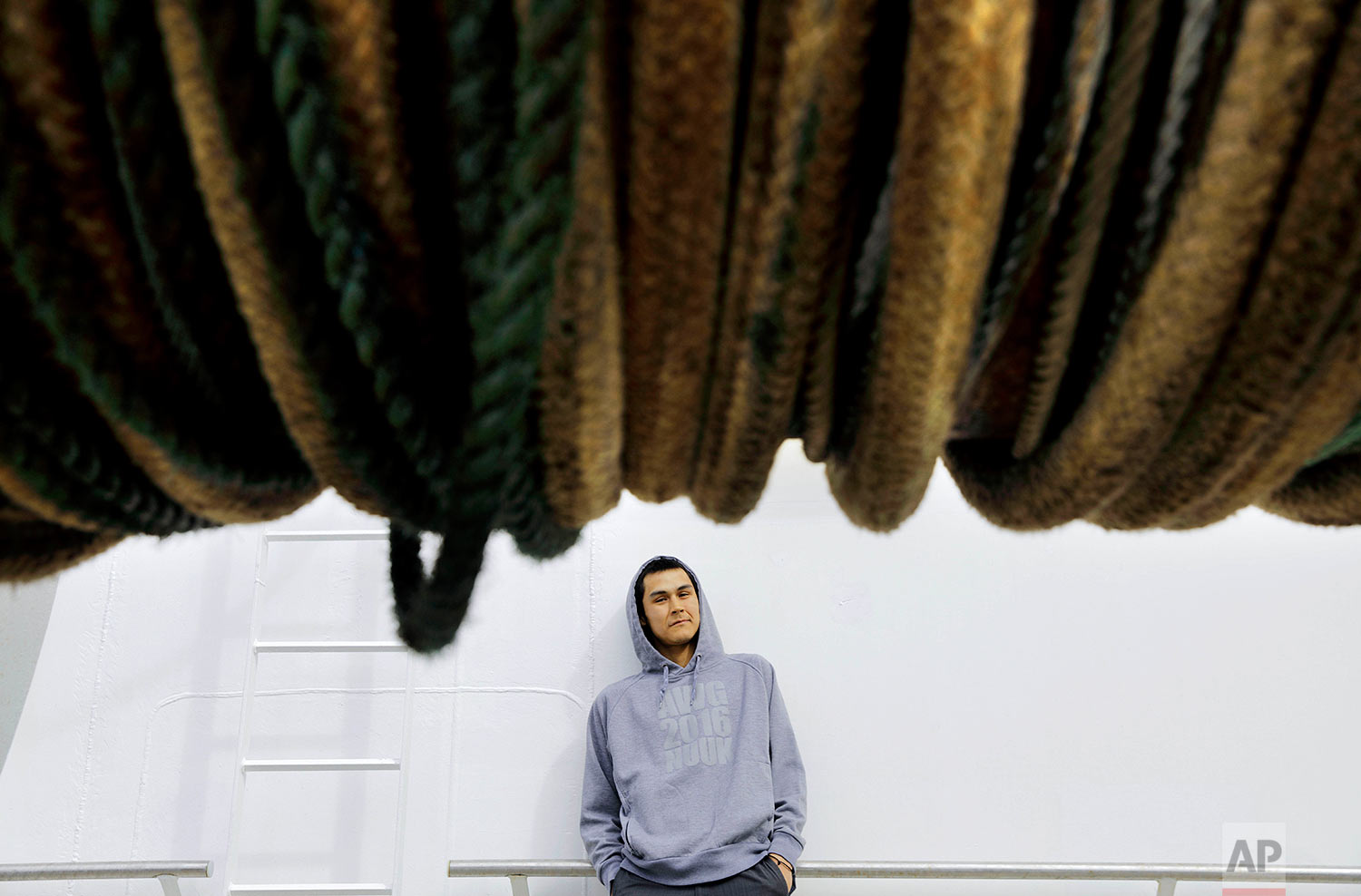
Trainee David Kullualik, 24, of Iqaluit, Nunavut, in Canada's northern territories, stands for a portrait on a deck aboard the Finnish icebreaker MSV Nordica as the ship sails north in the Bering Sea toward the Arctic, Wednesday, July 12, 2017. Kullualik is earning sea days toward his training and hopes of being a captain some day. "Our instructor said it was a trip of a lifetime. I said I don't know about that, I grew up around them [polar bears] and the ice is around us nine months of the year," said Kullualik. "I have three kids and I'm just trying to put food on the table. I think of them all the time." (AP Photo/David Goldman)
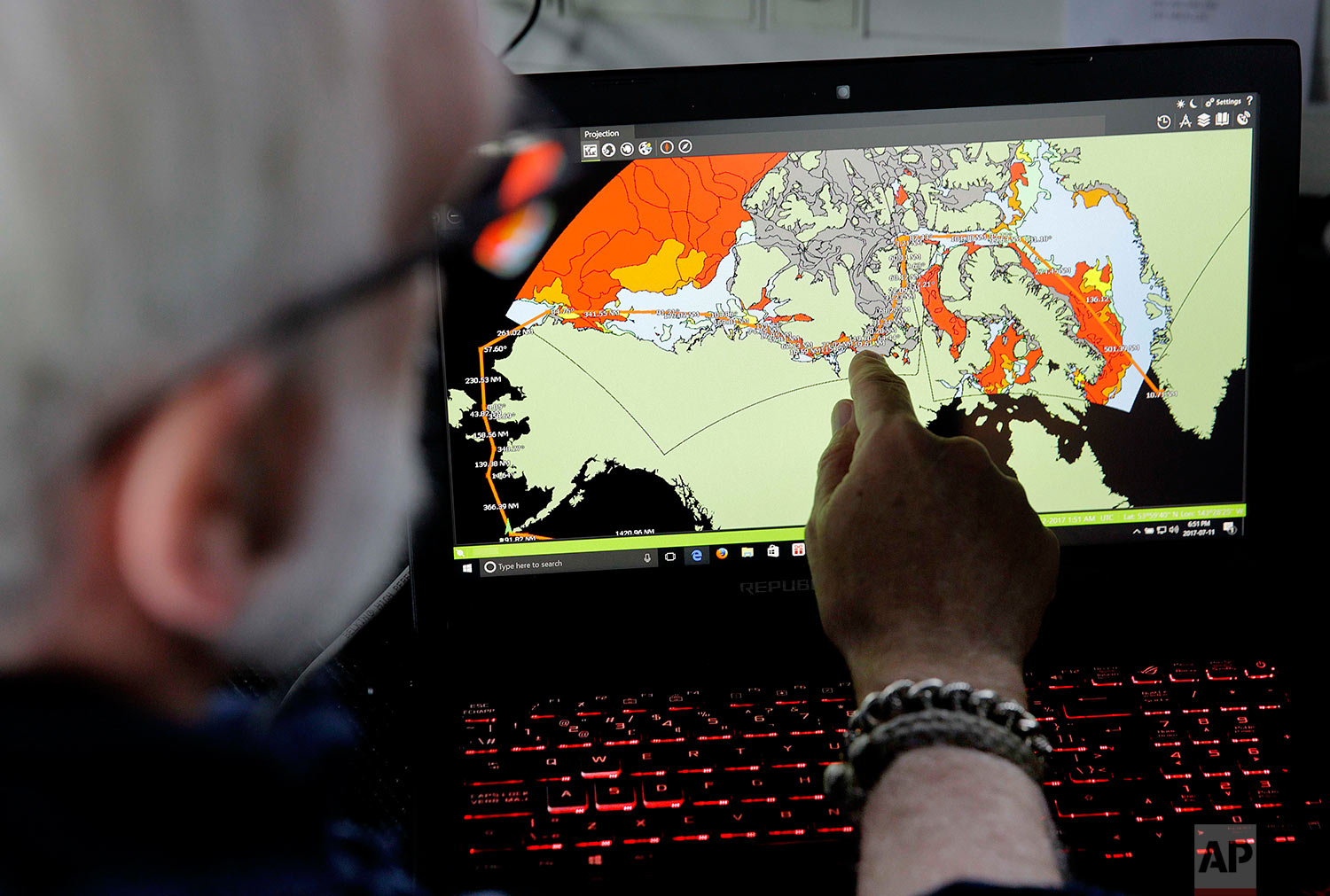
Canadian ice navigator, David "Duke" Snider shows the route the Finnish icebreaker MSV Nordica will navigate on a map of current sea ice conditions as the ship sails north in the Bering Sea Tuesday, July 11, 2017. A group of international researchers is sailing into the Arctic Sea aboard the Finnish icebreaker to traverse the Northwest Passage and record the environmental and social changes that are taking place in one of the most forbidding corners of the world. (AP Photo/David Goldman)
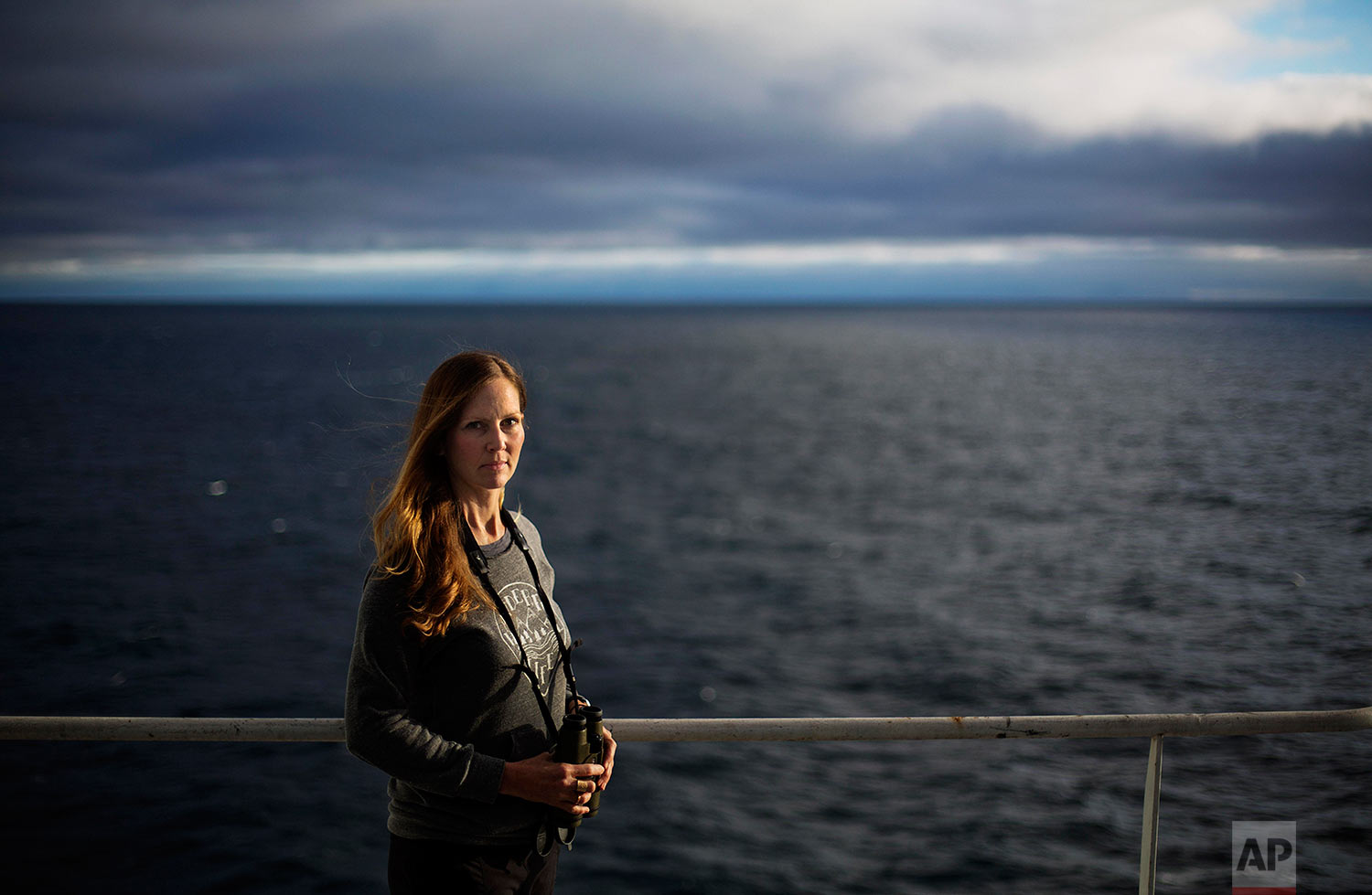
Field biologist Paula von Weller, 45, of Portland, Ore., stands for a portrait aboard the Finnish icebreaker MSV Nordica as it sails in the North Pacific Ocean toward the Bering Strait, Tuesday, July 11, 2017. "Few people in the world get to sail the Northwest Passage," said von Weller, who will be marking her second passage after traveling through with another Finnish icebreaker in 2015. She is observing wildlife in the Arctic and hopes this time to see the elusive narwhal, the unicorn of the sea. "I've been fascinated with the Arctic. It is very special to me. I think it's just this mythical place." (AP Photo/David Goldman)
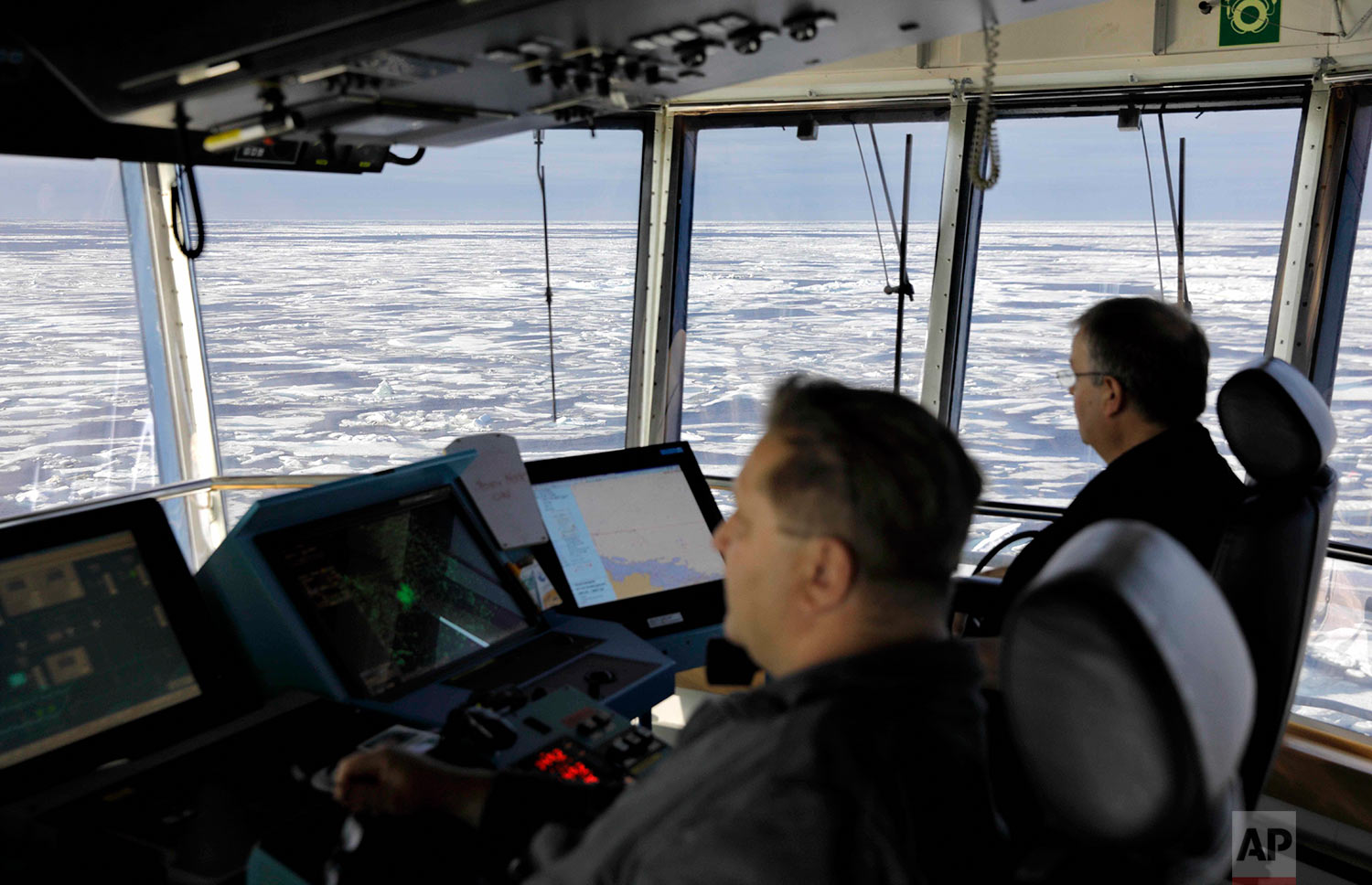
Master Mariner Jyri Viljanen, left, captain of the Finnish icebreaker MSV Nordica and Chief Officer Harri Venalainen, navigate from the bridge through ice floating on the Chukchi Sea off the coast of Alaska while traversing the Arctic's Northwest Passage, Sunday, July 16, 2017. More than a century has passed since the first successful transit of the treacherous, ice-bound Northwest Passage by Norwegian explorer Roald Amundsen in 1906. (AP Photo/David Goldman)
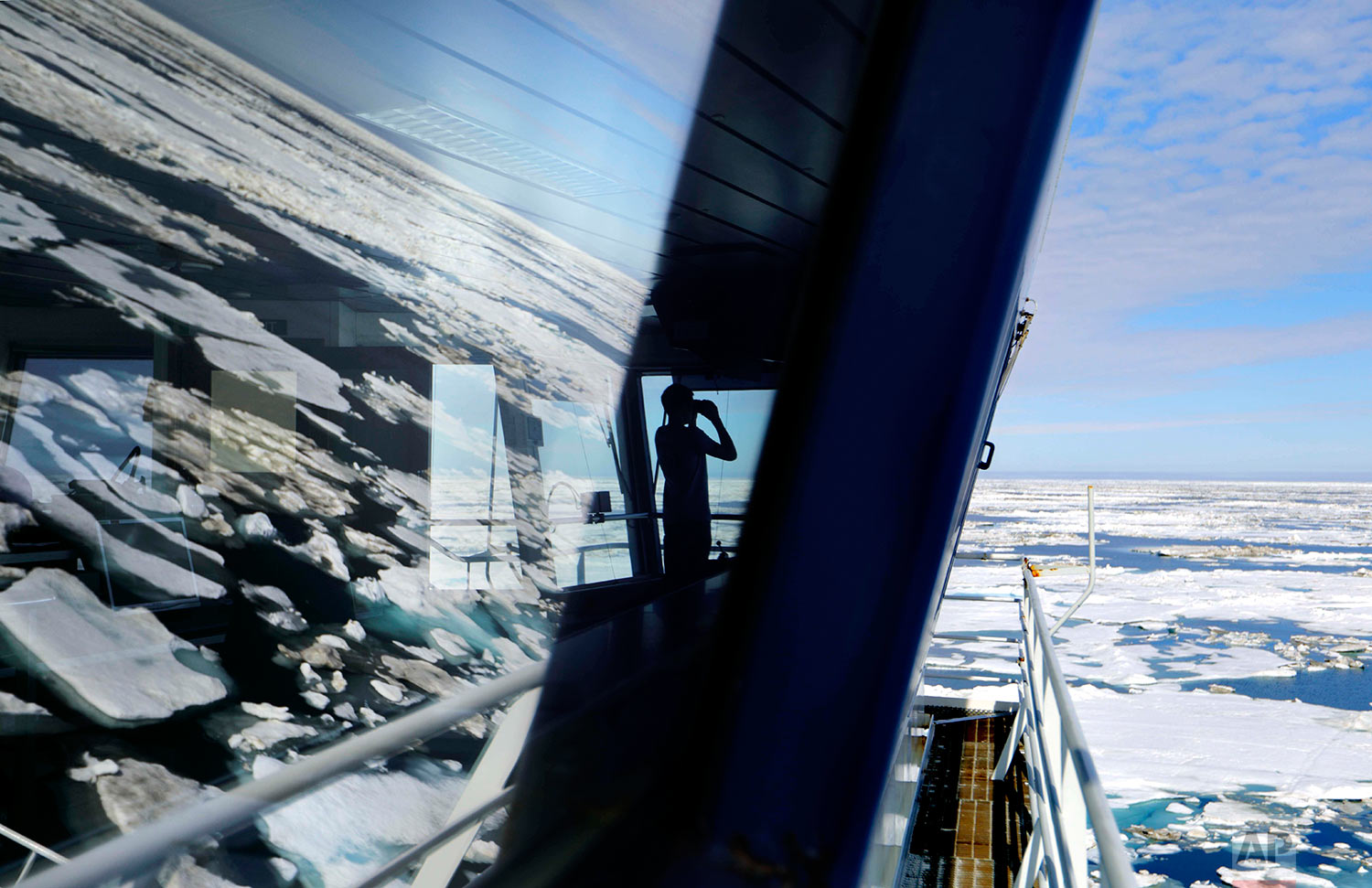
Trainee David Kullualik, of Iqaluit, Nunavut, of Canada's northern territories, looks through binoculars from the bridge of the Finnish icebreaker MSV Nordica as it sails through ice floating on the Chukchi Sea off the coast of Alaska while traversing the Arctic's Northwest Passage, Sunday, July 16, 2017. (AP Photo/David Goldman)
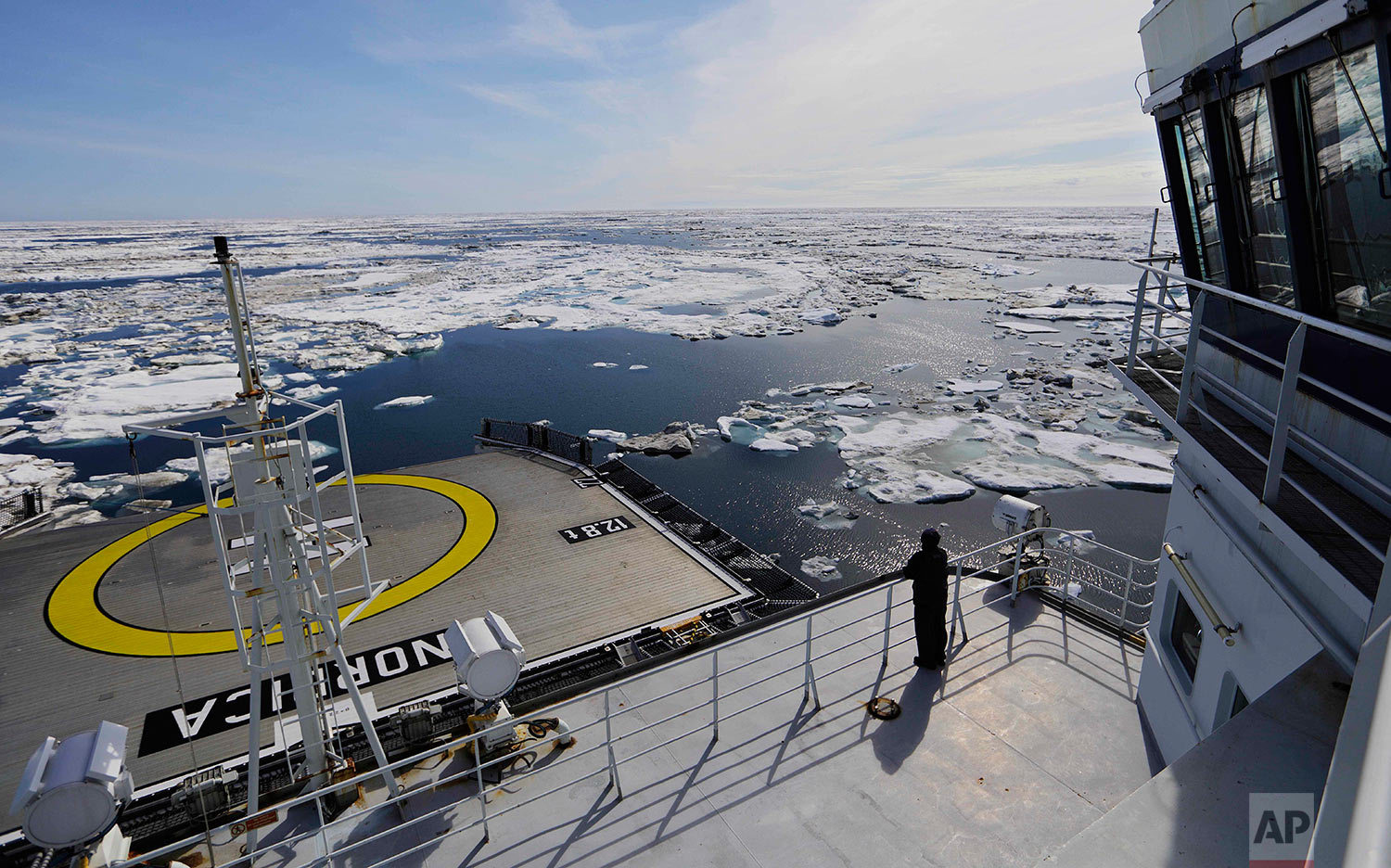
The Finnish icebreaker MSV Nordica sails through ice floating on the Beaufort Sea off the coast of Alaska, Sunday, July 16, 2017, while traversing the Arctic's Northwest Passage, where global warming is melting sea ice and glaciers at an historic rate, altering and opening up the Arctic as never before. (AP Photo/David Goldman)
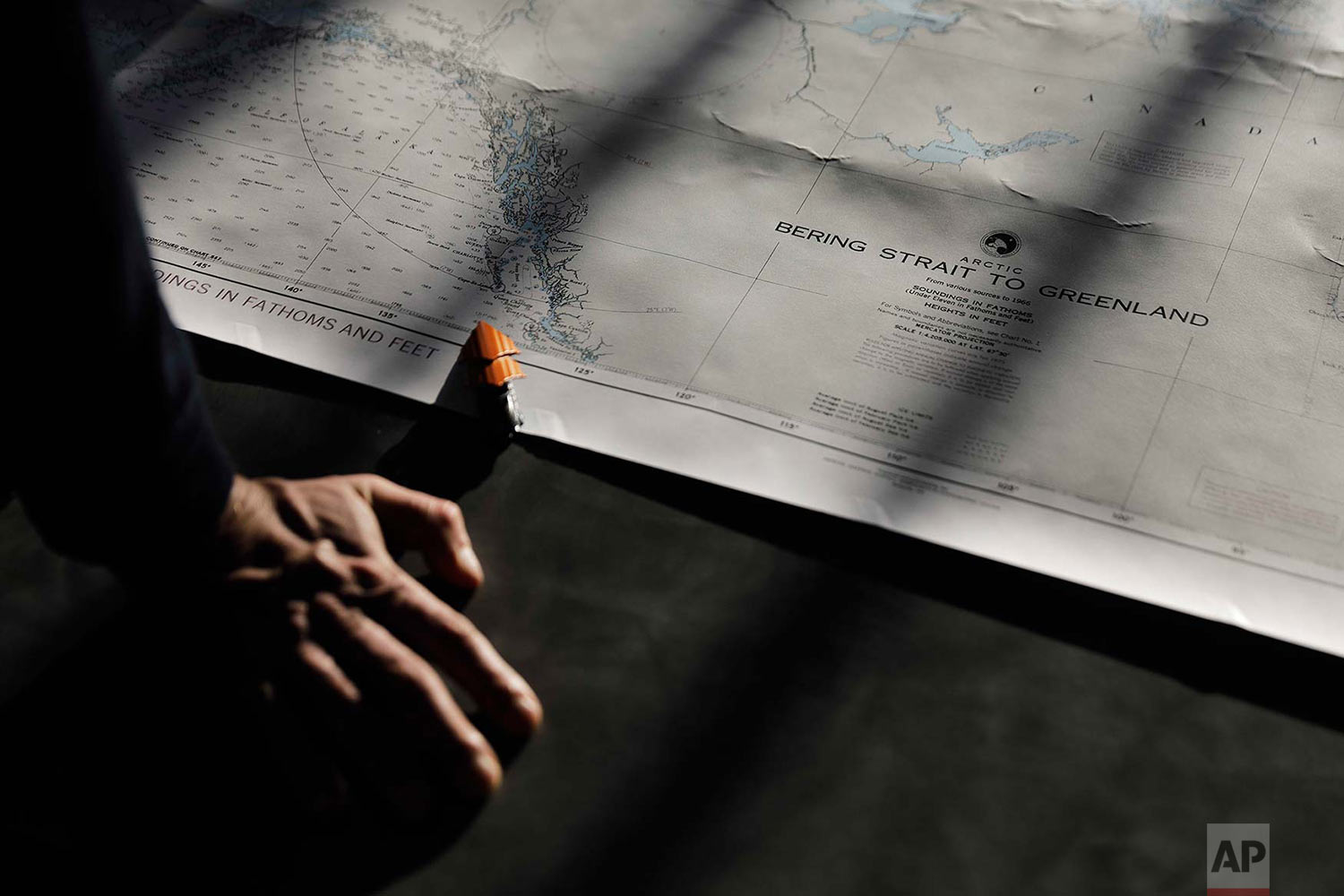
CORRECTS NAME OF CITY TO CANBERRA, NOT CAMBRIA - Polar maritime lawyer Scott Joblin, from the Australian National University in Canberra, looks over a map aboard the Finnish icebreaker MSV Nordica as it sets sail in the North Pacific Ocean toward the Bering Strait, Thursday, July 6, 2017. A group of international researchers is sailing into the Arctic Sea aboard the Finnish icebreaker to traverse the Northwest Passage and record the environmental and social changes that are taking place in one of the most forbidding corners of the world. (AP Photo/David Goldman)
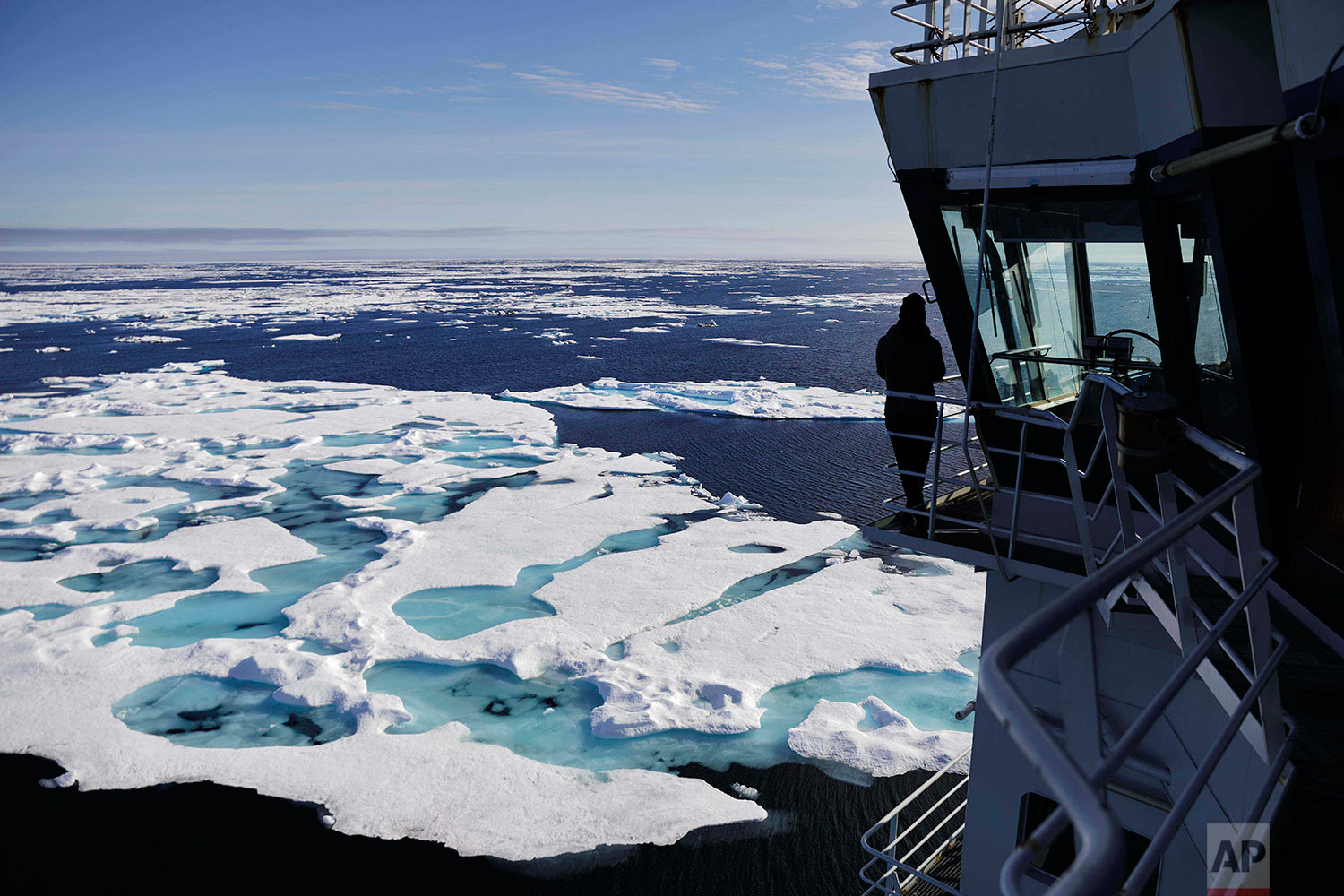
The Finnish icebreaker MSV Nordica sails through ice floating on the Chukchi Sea off the coast of Alaska, Sunday, July 16, 2017, while traversing the Arctic's Northwest Passage, the treacherous, ice-bound route where Norwegian explorer Roald Amundsen made the first successful transit in 1906. (AP Photo/David Goldman)
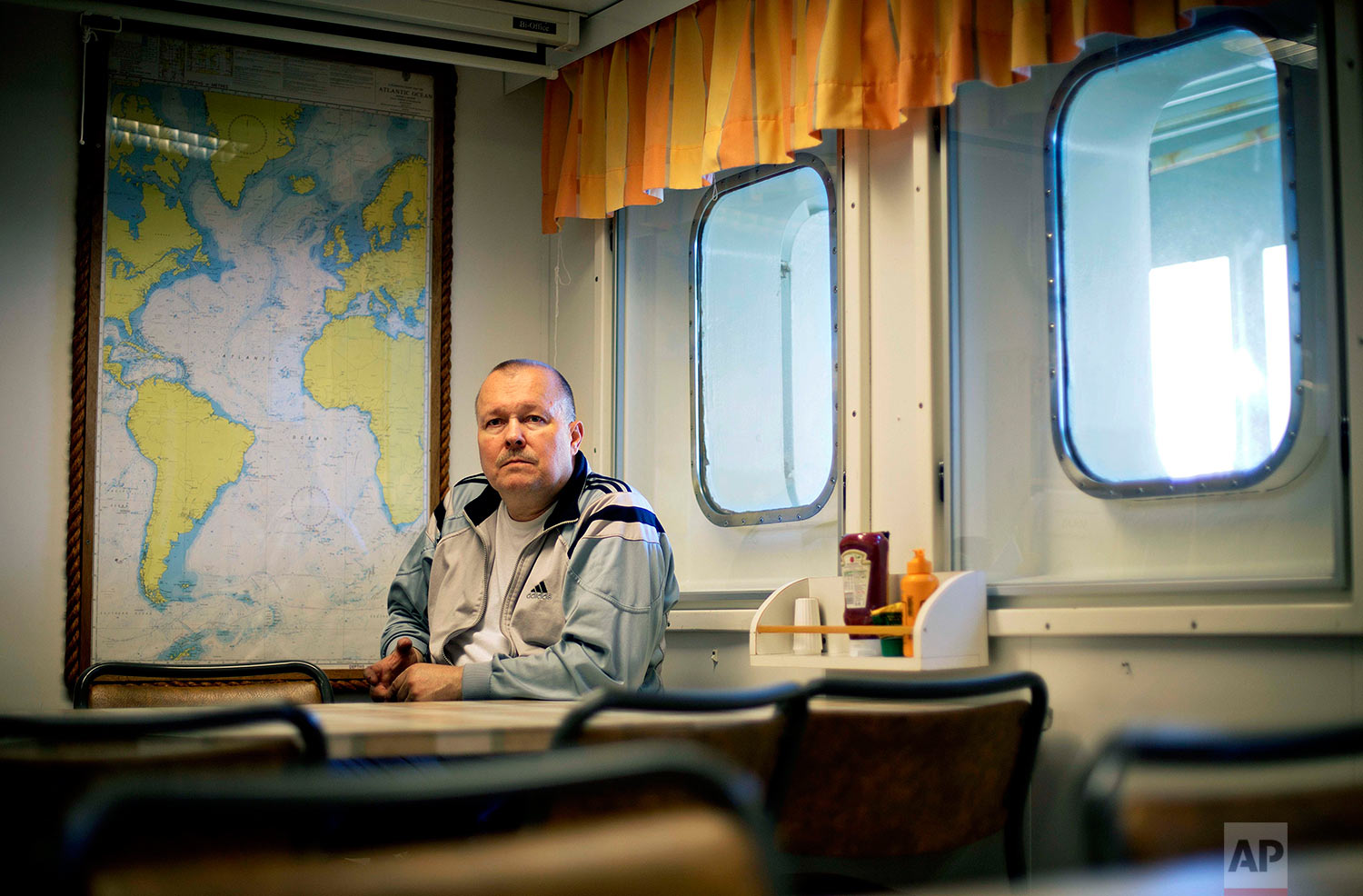
Engine repairman Jari Jarvinen, 58, sits for a portrait in the mess hall after finishing a night shift aboard the Finnish icebreaker MSV Nordica as it sails in the North Pacific Ocean toward the Bering Strait, Tuesday, July 11, 2017. Jarvinen started working on boats over 30 years ago. "I've been there before. For me it's normal work," said Jarvinen of the Northwest Passage. "I like it though. Not everyday is the same. You look outside the window and it's always a different place." (AP Photo/David Goldman)
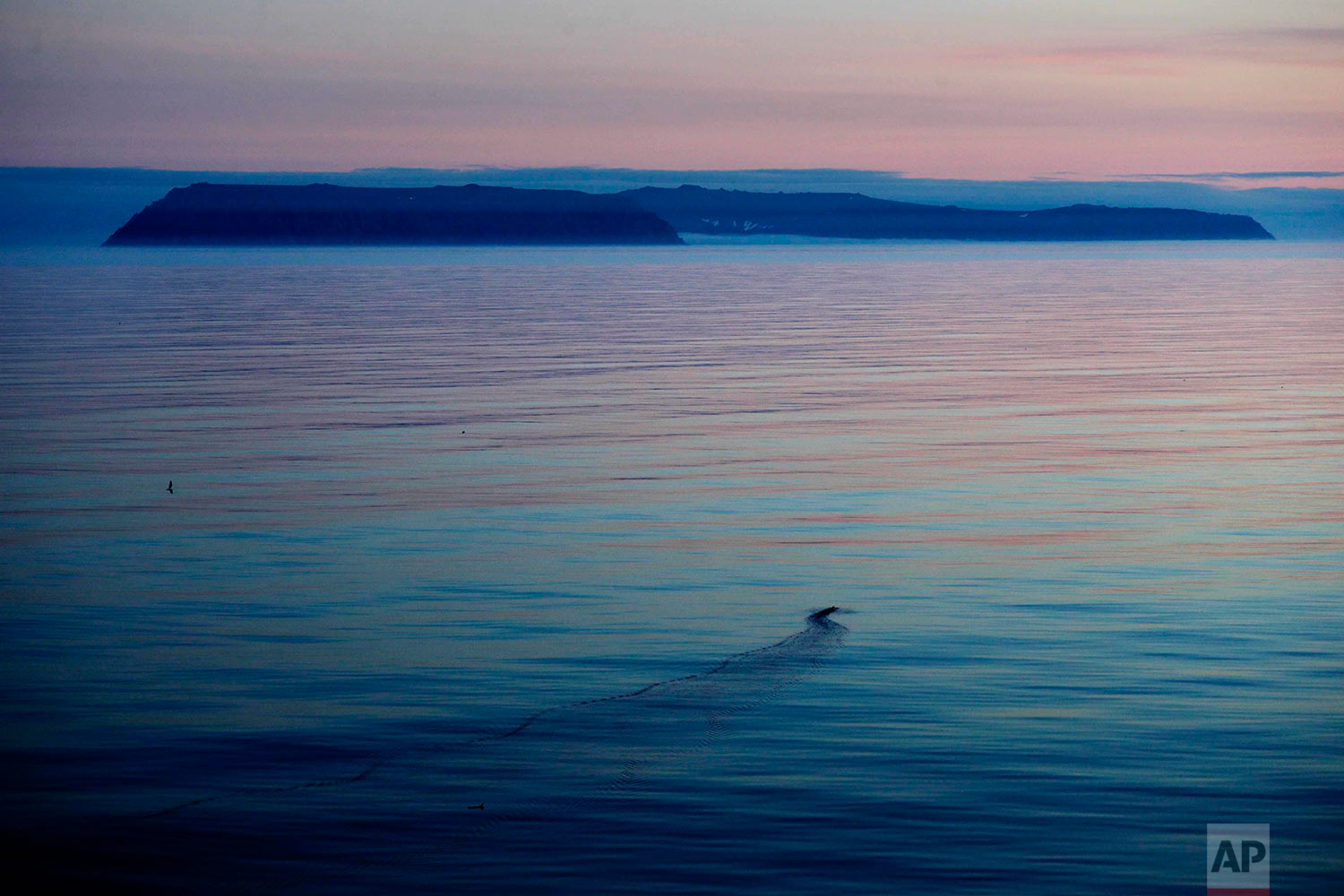
A bird's wake is cast on the water as the American island of Little Diomede, Alaska, left, and behind it on the right, the Russian island of Big Diomede, are seen from the Finnish icebreaker MSV Nordica in the Bering Strait, Friday, July 14, 2017. The international date line divides the two islands, putting them currently 20 hours apart despite roughly 2.4 miles (3.8 kilometers) between them. Due to this time difference, Little Diomede is sometimes referred to as Yesterday Isle and Big Diomede as Tomorrow Island. (AP Photo/David Goldman)
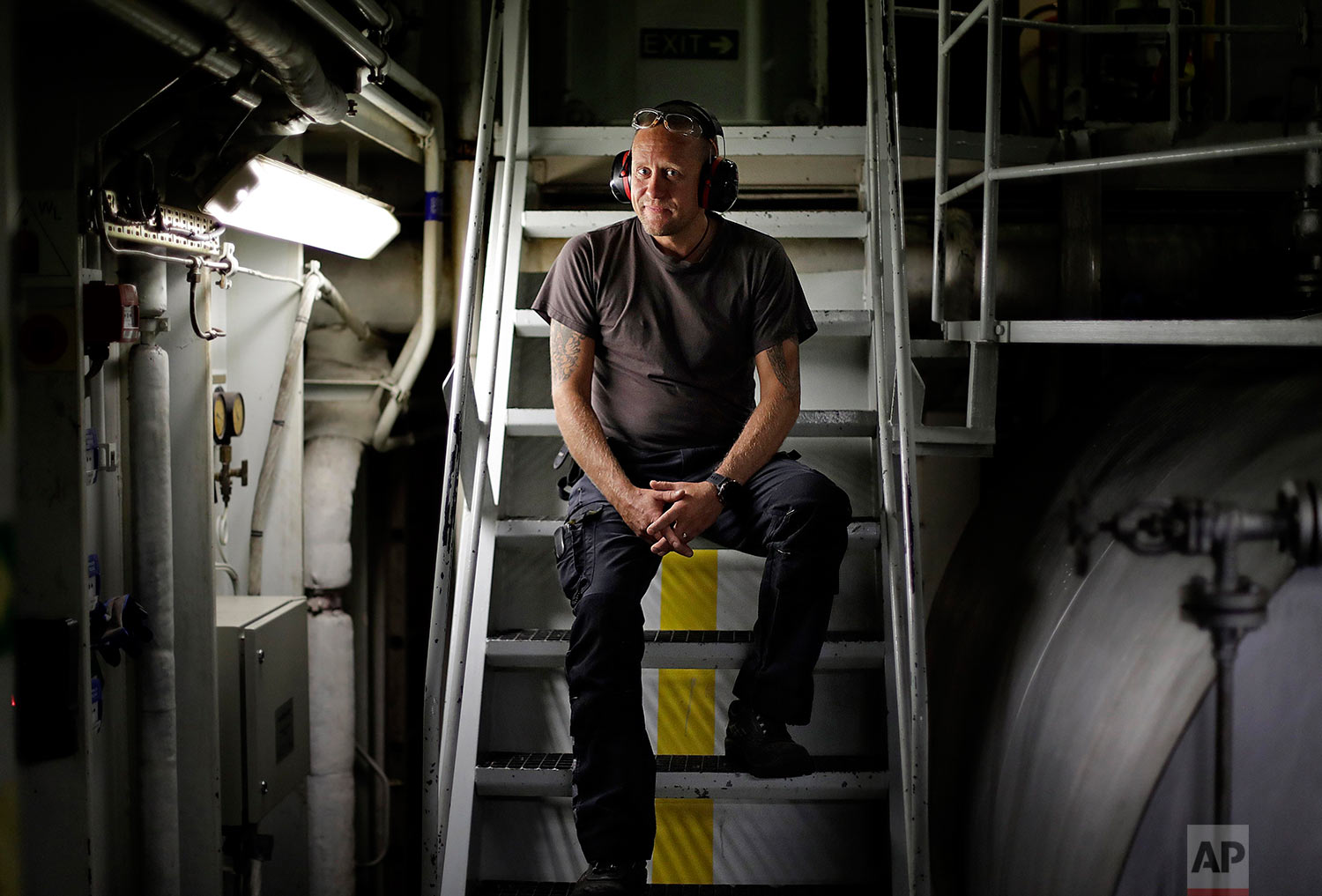
First engineer Kristian Autio, 44, sits for a portrait in the engine room of the Finnish icebreaker MSV Nordica as it sails in the North Pacific Ocean toward the Bering Strait, Sunday, July 9, 2017. Autio has worked aboard Finnish icebreakers since 2002 and this will be his first time crossing the Arctic's Northwest Passage. Finland has a long history of building icebreakers and has built 60 percent of the world's fleet. "We take care of the ship as if it's our own," said Autio. "We [Finns] are very proud of our icebreakers." (AP Photo/David Goldman)
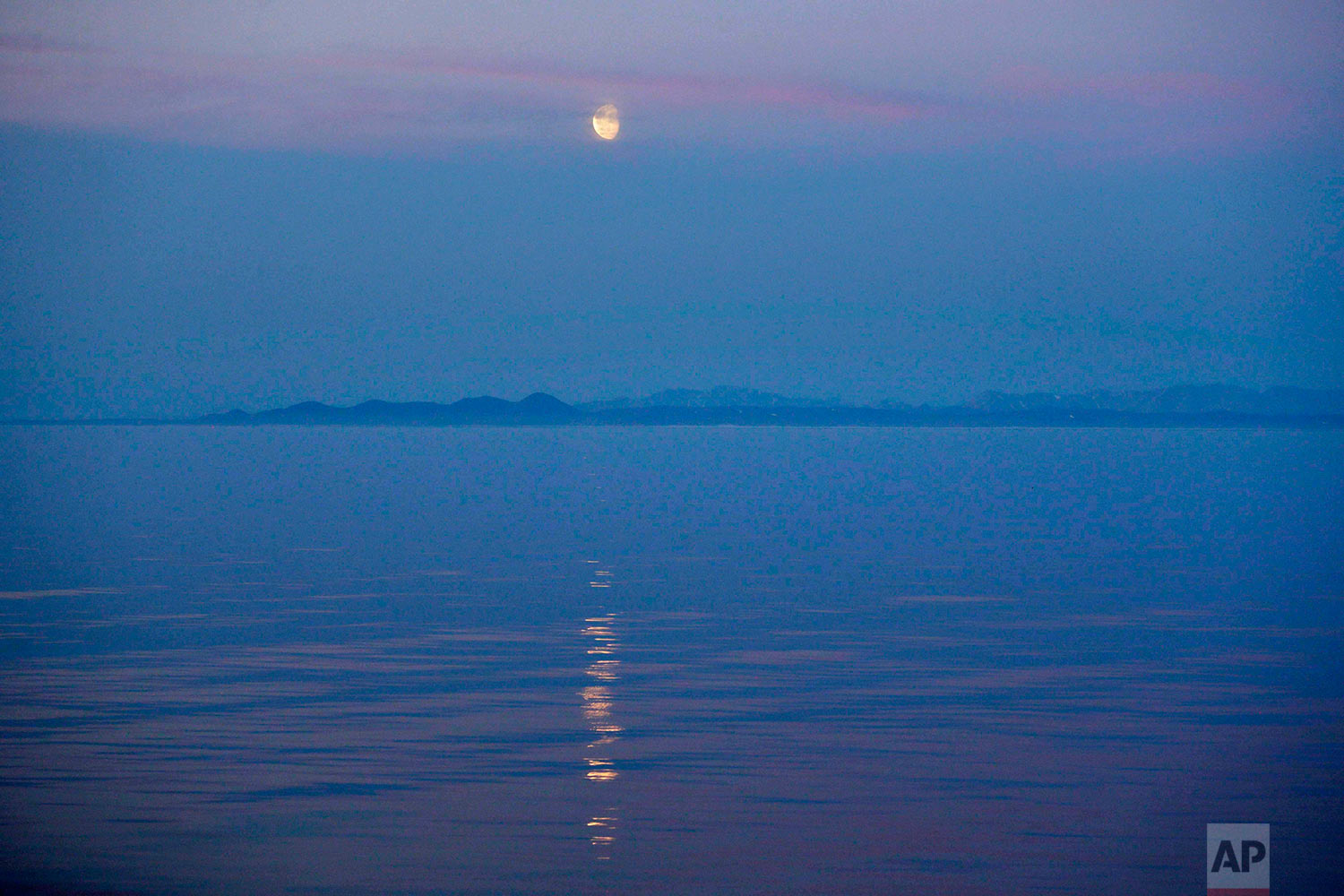
The moon rises over the coast of Alaska as the Finnish icebreaker MSV Nordica sails along the international date line through the Bering Strait, Friday, July 14, 2017. The international date line is an imaginary border that runs through the middle of the Pacific Ocean and marks the boundary between calendar dates. Crossing the line from east to west, people would need to set their clocks forward by a day. Crossing from west to east, they would need to set it back by a day. (AP Photo/David Goldman)
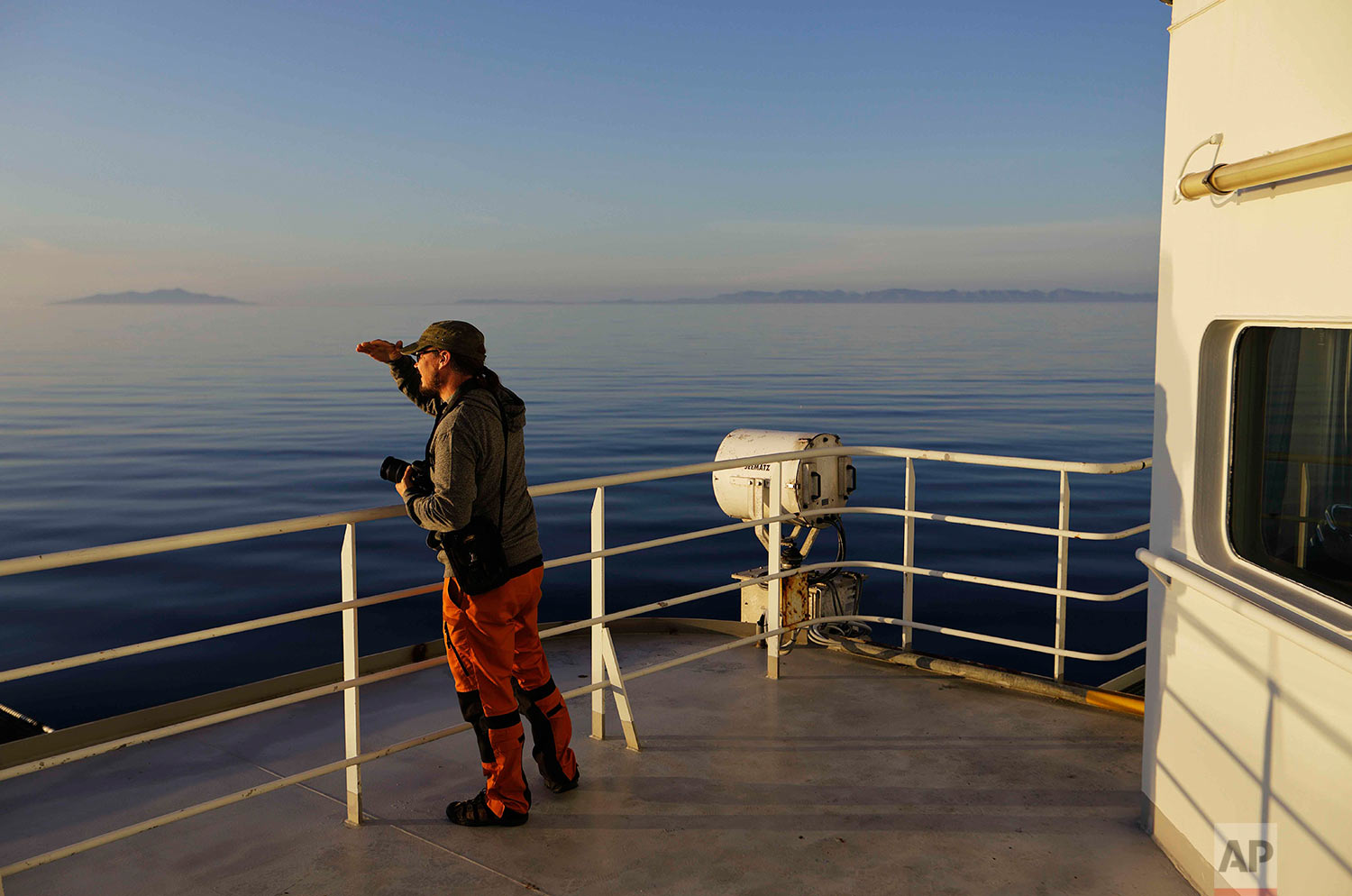
Researcher Ari Laakso shields his eyes from the midnight sun while approaching the American island of Little Diomede, Alaska, and the Russian island of Big Diomede, as the Finnish icebreaker MSV Nordica sails along the international date line through the Bering Strait, Friday, July 14, 2017. The international date line divides the two islands, putting them currently 20 hours apart despite roughly 2.4 miles (3.8 kilometers) between them. (AP Photo/David Goldman)
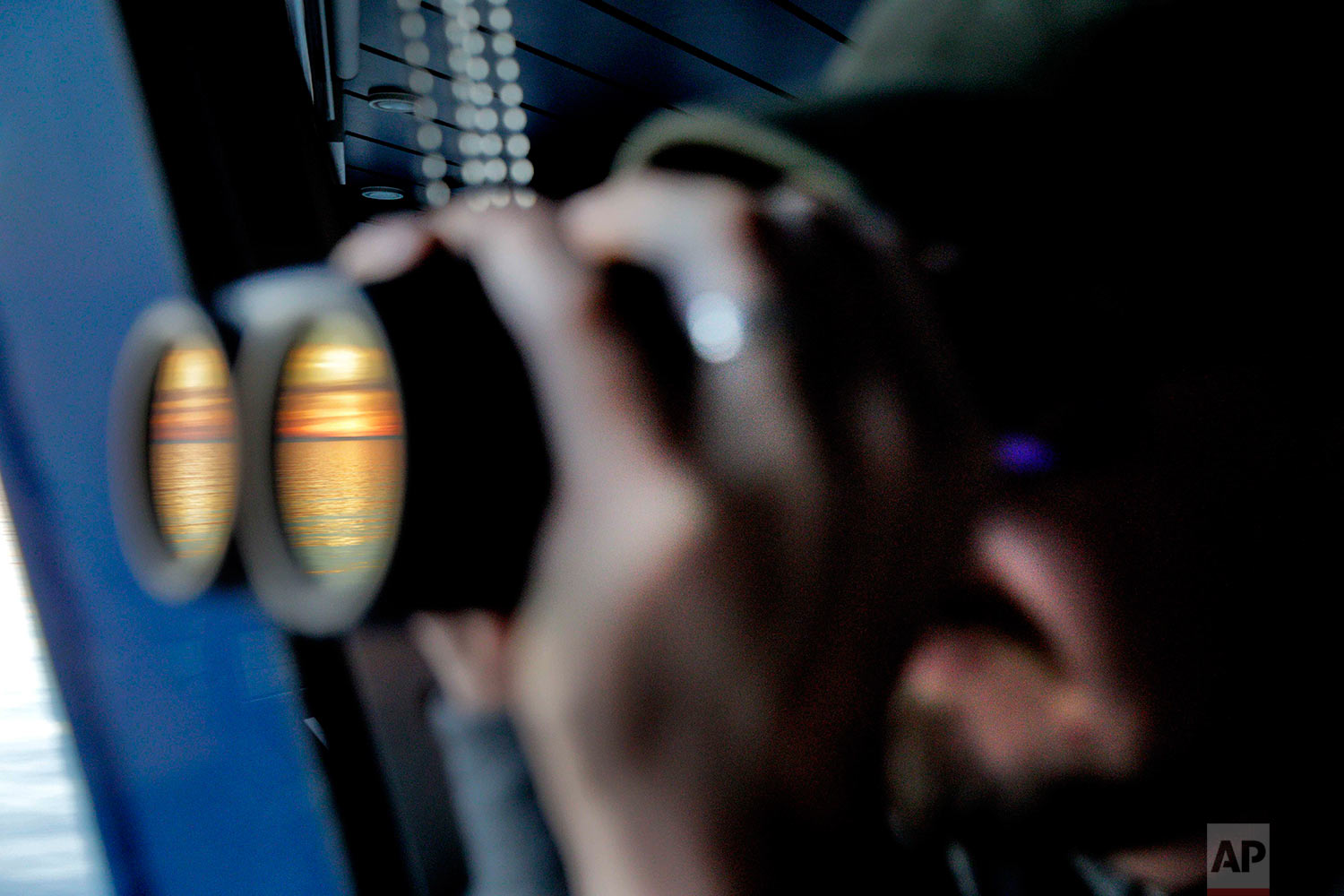
Researcher Ari Laakso looks to the horizon through binoculars under the midnight sun while approaching the Bering Strait, which divides the United States and Russia, as the Finnish icebreaker MSV Nordica sails along the international date line, Friday, July 14, 2017. The international date line is an imaginary border that runs through the middle of the Pacific Ocean and marks the boundary between calendar dates, effectively making it the zero-line for the planet’s time zones. (AP Photo/David Goldman)
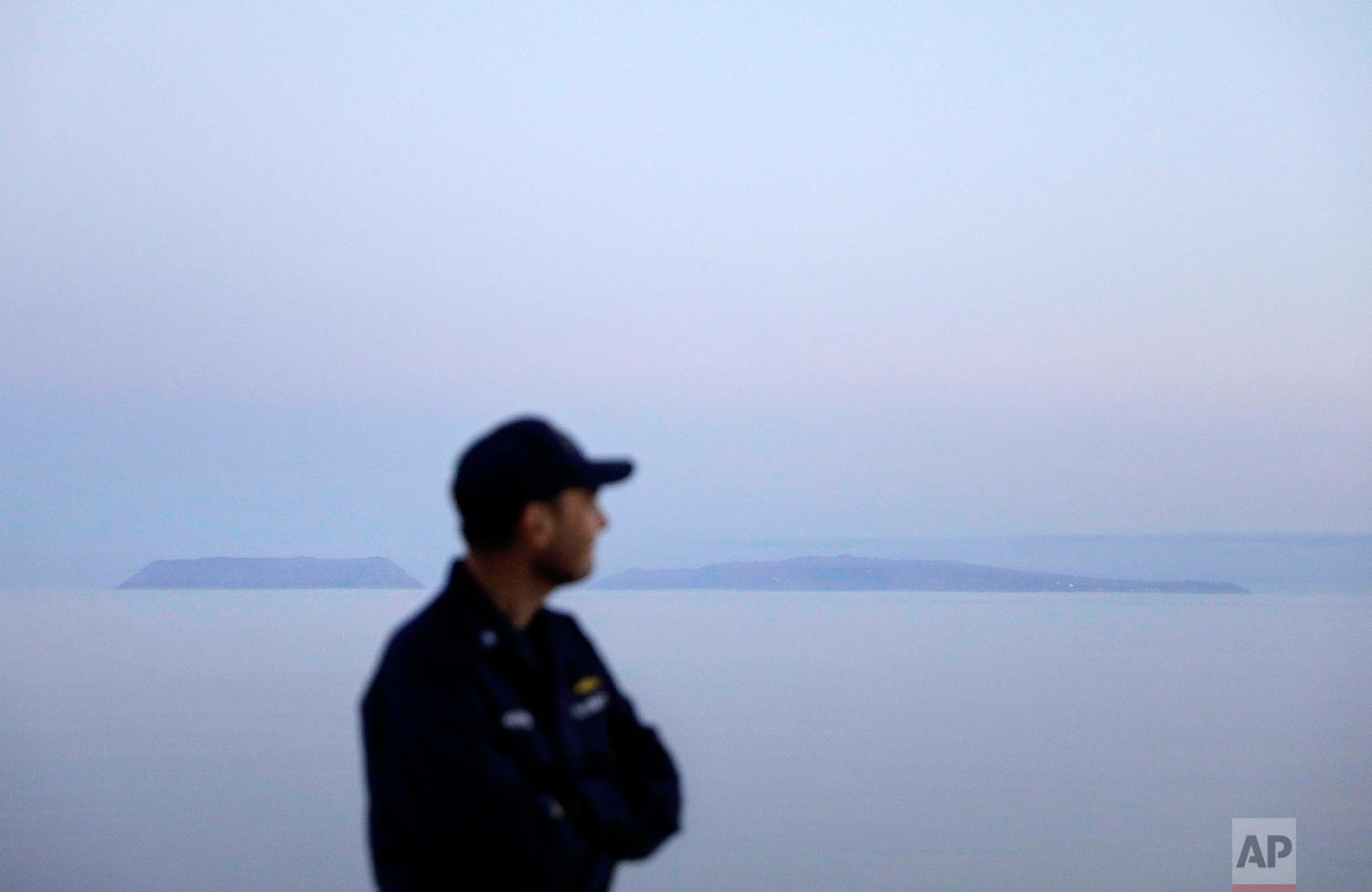
Cmdr. Bill Woityra, manager for domestic and polar icebreaking for the U.S. Coast Guard, looks out to sea while passing the American island of Little Diomede, Alaska, left, and the Russian island of Big Diomede, right, as the Finnish icebreaker MSV Nordica sails along the international date line through the Bering Strait, Friday, July 14, 2017. The international date line divides the two islands, so Little Diomede is sometimes referred to as Yesterday Isle and Big Diomede as Tomorrow Island. (AP Photo/David Goldman)

First officer Jukka Vuosalmi sits at the controls of the Finnish icebreaker MSV Nordica as it sets sail in the North Pacific Ocean toward the Bering Strait, Friday, July 7, 2017. A group of international researchers is sailing into the Arctic Sea aboard the Finnish icebreaker to traverse the Northwest Passage and record the environmental and social changes that are taking place in one of the most forbidding corners of the world. (AP Photo/David Goldman)
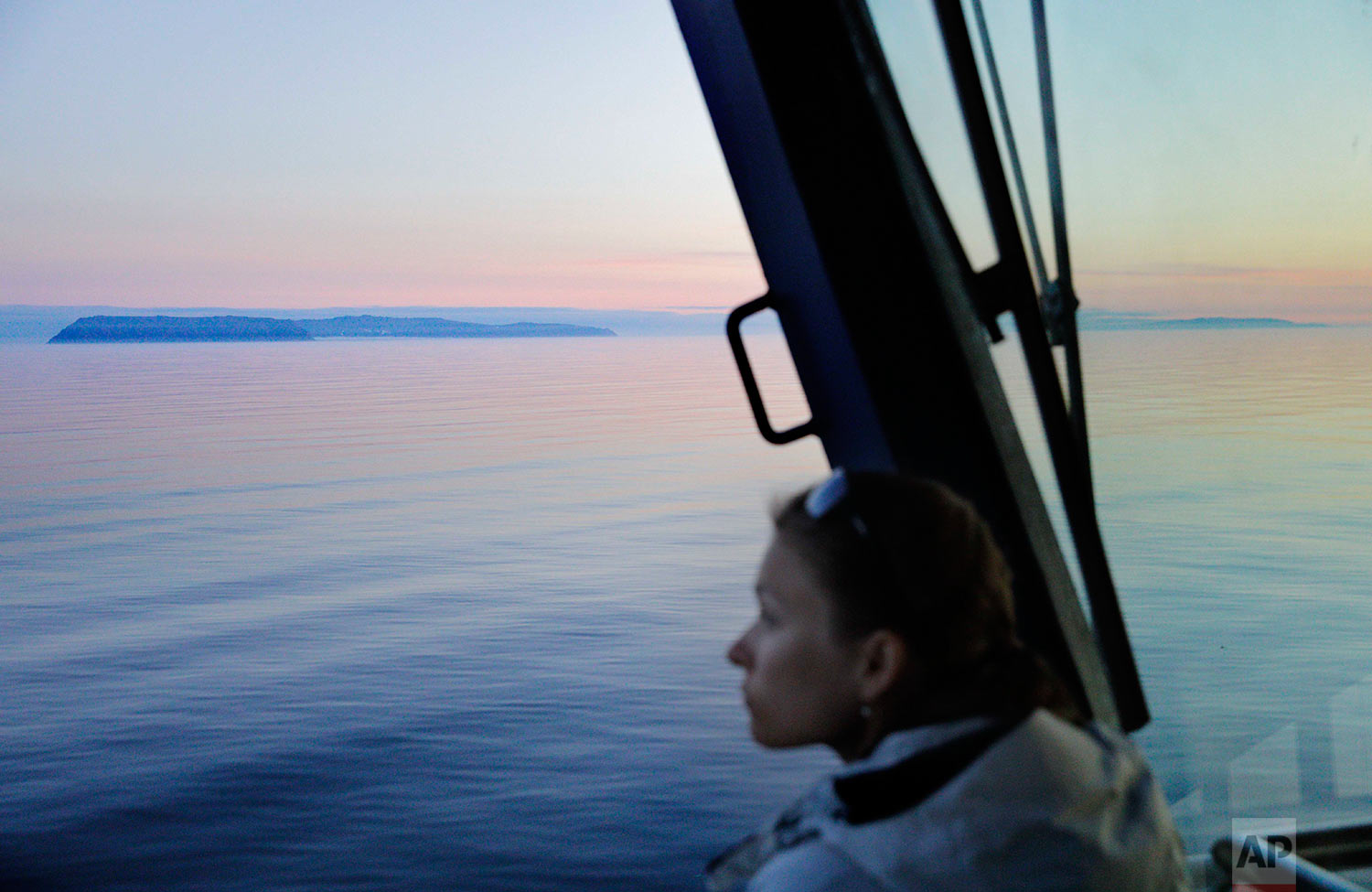
Researcher Daria Gritsenko looks out toward the American island of Little Diomede, Alaska, near left, and behind it on the right, the Russian island of Big Diomede, as the Finnish icebreaker MSV Nordica sails along the international date line through the Bering Strait, Friday, July 14, 2017. The international date line divides the two islands, with Little Diomede sometimes referred to as Yesterday Isle and Big Diomede as Tomorrow Island. (AP Photo/David Goldman)
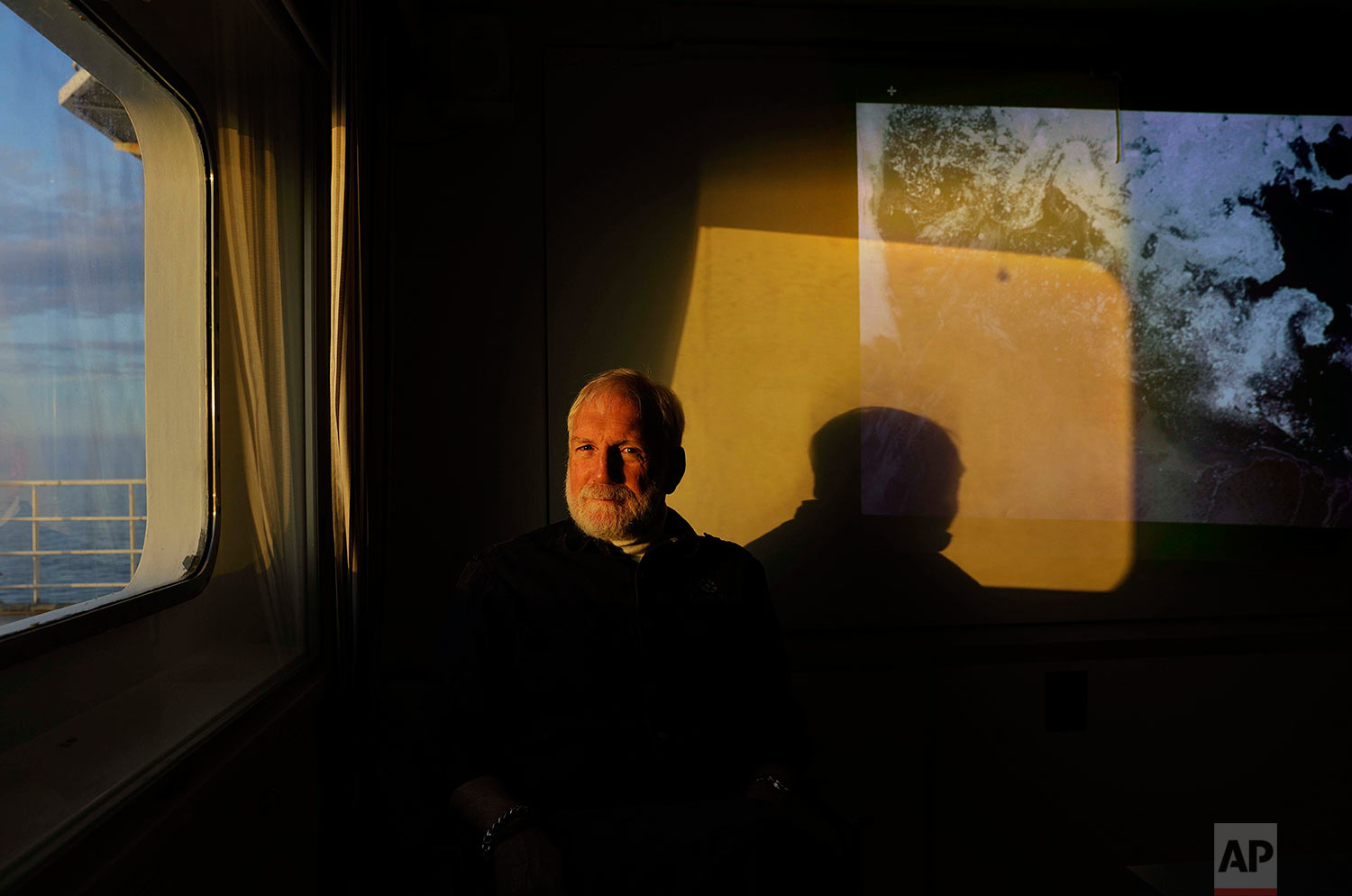
Ice navigator, Capt. David "Duke" Snider, 60, a Canadian Coast Guard veteran with 35 years at sea, sits for a portrait aboard the Finnish icebreaker MSV Nordica next to a satellite image of ice conditions along the Northwest Passage as the ship sails the Chukchi Sea into the Arctic, Saturday, July 15, 2017. Snider, who is aboard to help guide the ship safely through the ice, has sailed into the Arctic hundreds of times and completed the entire passage twice. "Maneuvering a ship in ice takes an entirely different set of skills. You have to understand how ice moves and grows," said Snider. "It's a dance, a slow dance. That's what it's all about, getting the ship through without stepping on her toes." (AP Photo/David Goldman)
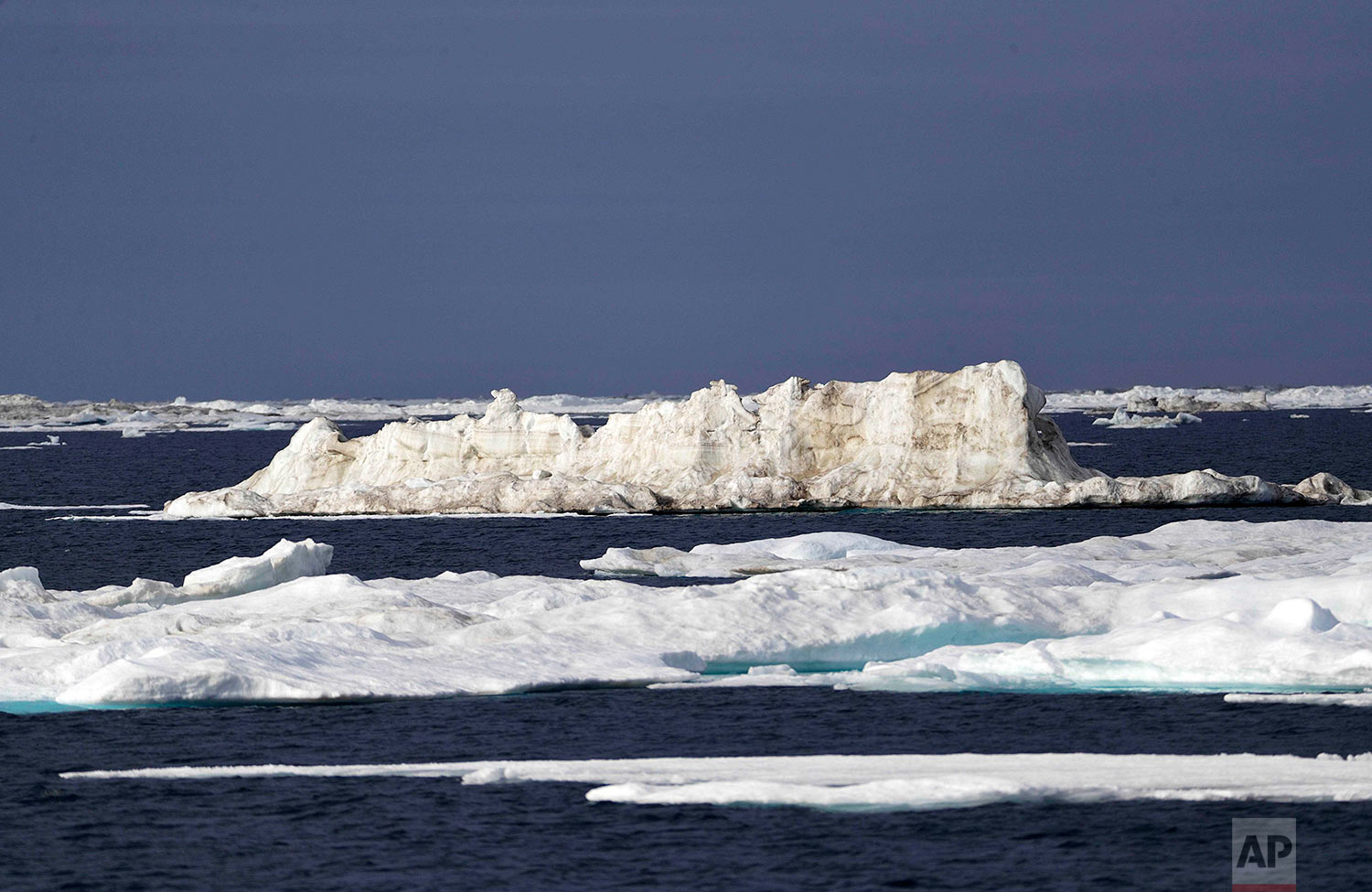
Sea ice floats past the Finnish icebreaker MSV Nordica as the ship sails through the Chukchi Sea off the coast of Alaska, Sunday, July 16, 2017, while traversing the Arctic's Northwest Passage, where global warming is melting sea ice and glaciers at an historic rate, altering and opening up the Arctic as never before. (AP Photo/David Goldman)

Cmdr. Bill Woityra, manager for domestic and polar icebreaking for the U.S. Coast Guard, right, gives a presentation on the history of U.S. ice breaking aboard the Finnish icebreaker MSV Nordica as it sails in the North Pacific Ocean toward the Bering Sea, Sunday, July 9, 2017. (AP Photo/David Goldman)
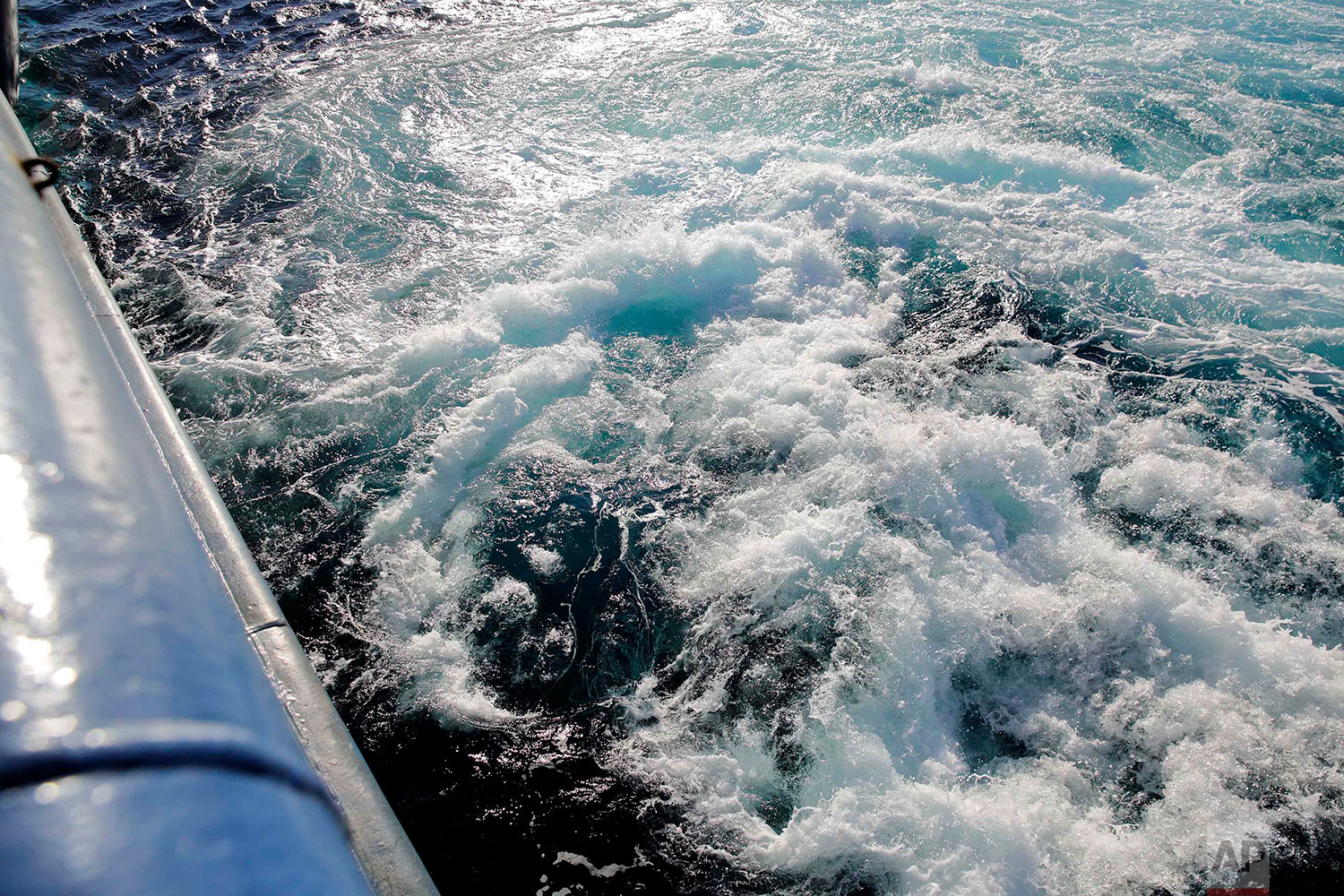
The thruster current of the Finnish icebreaker MSV Nordica churns water as the ship turns to demonstrate its maneuverability while sailing the Dolphin and Union Strait off the coast of Canada through the Arctic's Northwest Passage, Wednesday, July 19, 2017. The thrusters can break ice up to one one meter thick by churning the water underneath. (AP Photo/David Goldman)
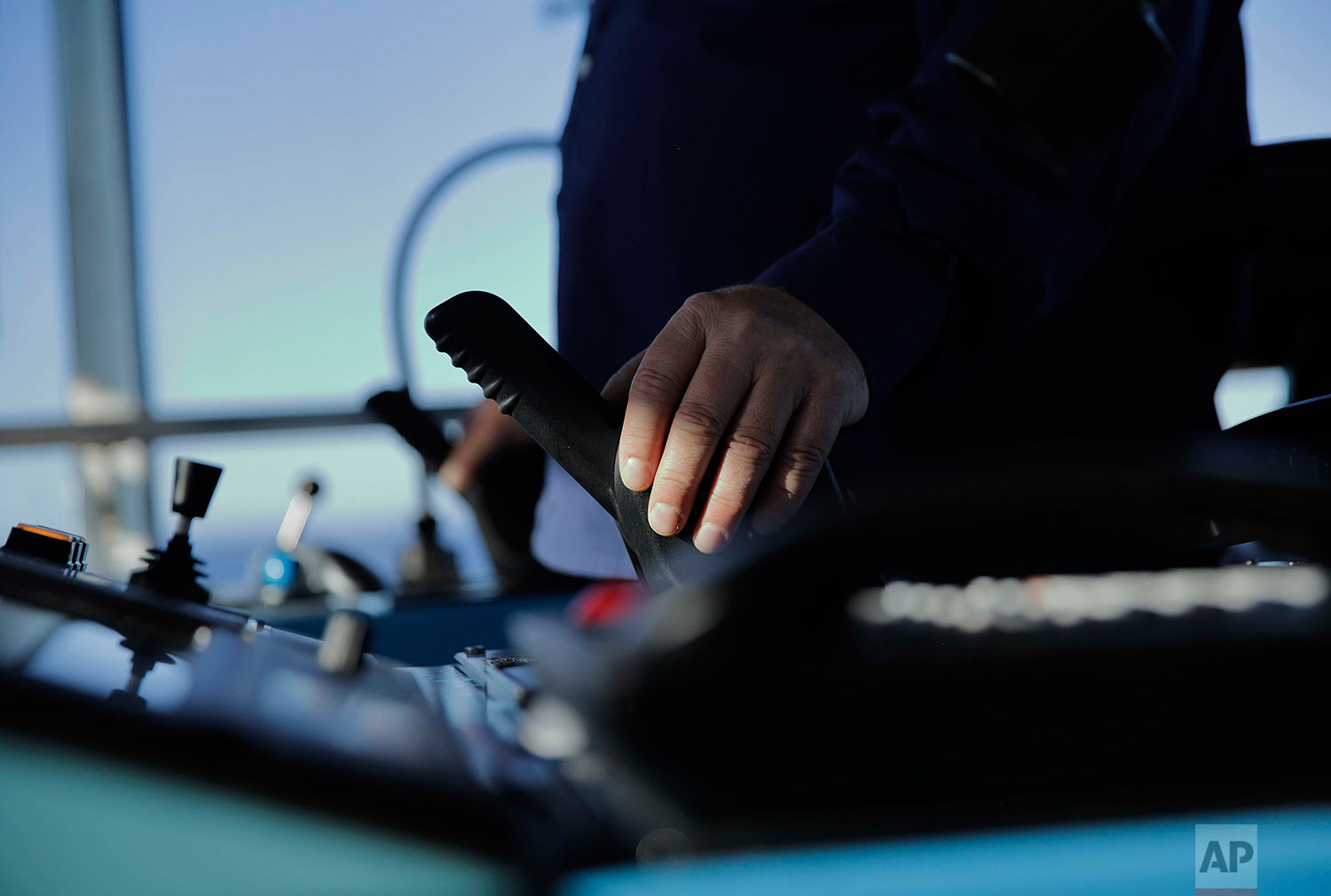
Master Mariner Jyri Viljanen, captain of the Finnish icebreaker MSV Nordica. pushes the thruster while demonstrating the ship's maneuverability while sailing the Dolphin and Union Strait off the coast of Canada through the Arctic's Northwest Passage, Wednesday, July 19, 2017. Icebreakers with azimuth thrusters, such as the Nordica, are extremely maneuverable and can change direction very quickly, allowing the ship to avoid many unnecessary encounters with ice that would otherwise slow it down. (AP Photo/David Goldman)
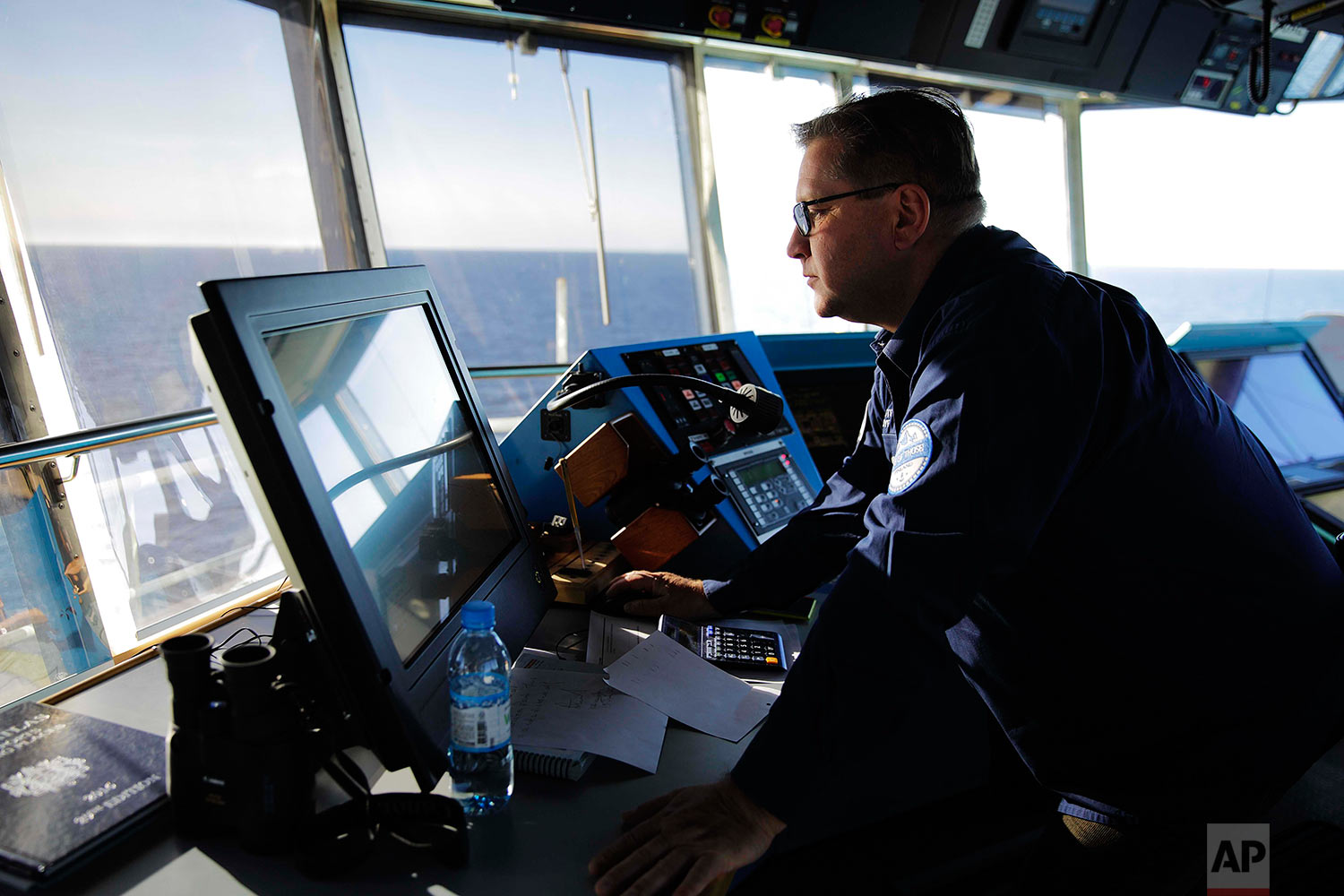
Master Mariner Jyri Viljanen, captain of the Finnish icebreaker MSV Nordica looks at a navigation screen on the ship's bridge while sailing the Dolphin and Union Strait off the coast of Canada through the Arctic's Northwest Passage, Wednesday, July 19, 2017. Despite the name, icebreakers will avoid hitting ice unless they have to. In a sea filled with floating chunks of frozen water, each weighing several tons, the ice navigator will look for the path of least resistance and relay it to the person at the helm, who ultimately decides which course to take. (AP Photo/David Goldman)
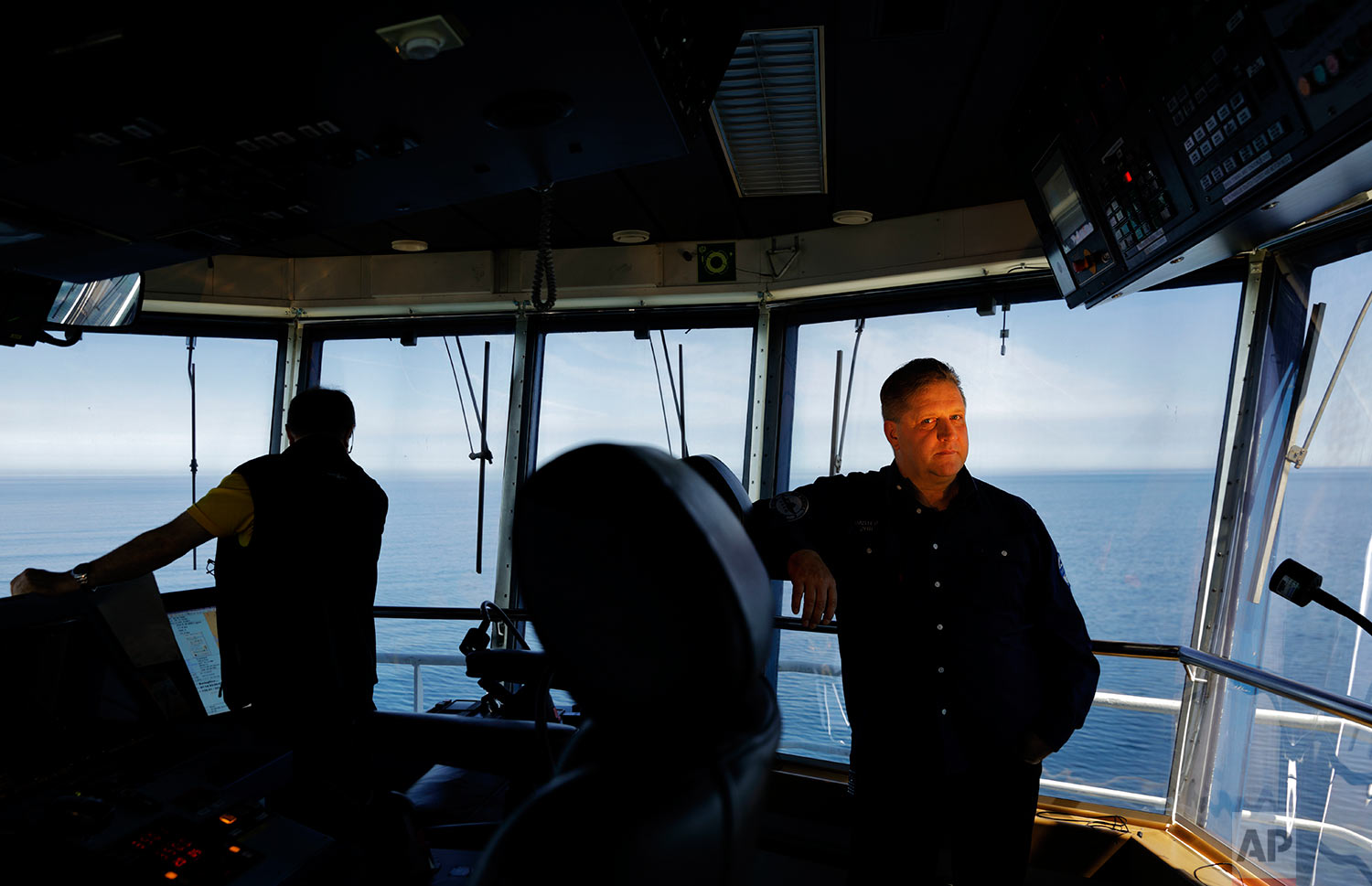
Master Mariner Jyri Viljanen, 56, captain of the Finnish icebreaker MSV Nordica stands for a portrait in the ship's bridge as it sails north in the Bering Sea toward the Arctic, Thursday, July 13, 2017. Viljanen has been going to sea for 39 years and this will be his first transit through the Arctic's Northwest Passage. "It's once a lifetime," said Viljanen. "The biggest risk is these are very remote areas so if anything happens it's very difficult to get any help or rescue or anything." (AP Photo/David Goldman)
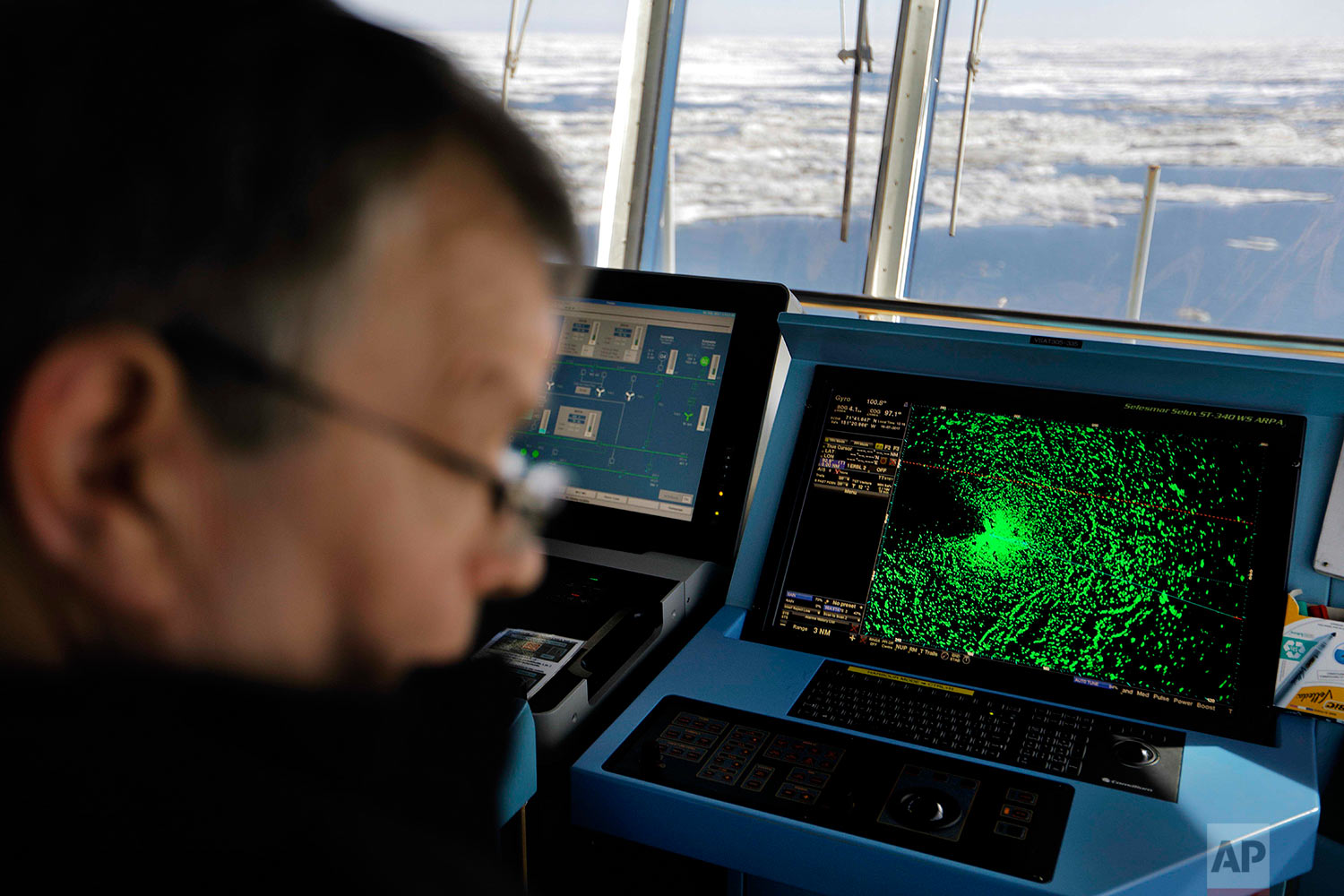
A radar shows sea ice ahead of the Finnish icebreaker MSV Nordica as chief officer Harri Venalainen navigates the ship through the Beaufort Sea while traversing the Arctic's Northwest Passage, Sunday, July 16, 2017. While icebreakers are equipped with sensitive radar systems, ultimately it's up to the ability and experience of the person at the helm to ensure the ship only breaks ice when it’s unavoidable. (AP Photo/David Goldman)

First officer Jukka Alhoke sits at the controls of the Finnish icebreaker MSV Nordica as it sets sail off the coast of Canada toward the Bering Strait, Thursday, July 6, 2017. The MSV Nordica is setting course to traverse the Northwest Passage, a route once considered impassible, from the Pacific ocean to the Atlantic via the Arctic. The icebreaker, which is returning to its home port of Helsinki, is carrying researchers studying the impact of the Arctic's melting sea ice on the fragile social and ecological balance in the region, and observers from the U.S. and Canadian Coast Guards. (AP Photo/David Goldman)

Deck repairman Mika Koponen, 41, sits for a portrait aboard the Finnish icebreaker MSV Nordica as the ship sails the Amundsen Gulf in the Arctic, Wednesday, July 19, 2017. Koponen, who is making his first traverse through the Northwest Passage, started sailing at the age of 15 after following in his brother's footsteps. "He was my idol. He sent me postcards from everywhere in the world," said Koponen of his brother who passed away five years ago. "After he became sick, I became his idol because he couldn't sail anymore. Now I'm taking these amazing adventures and I keep the tradition of the postcards. I think he'd be proud." (AP Photo/David Goldman)

Electrician Kaija Peuhkuri, 42, stands for a portrait in the machine shop of the Finnish icebreaker MSV Nordica as the ship sails north in the Bering Sea toward the Arctic, Wednesday, July 12, 2017. Peuhkuri started as a cook on ships over 20 years ago before going back to school and becoming an electrician on icebreakers in 2009. Growing up on a farm working on machines, she prefers working away at sea as opposed to commuting to a job at home. "I don't want to do this every morning," she said of having to drive to work. "Here, I come downstairs every morning, have a cup of coffee and I'm at work." (AP Photo/David Goldman)

A view of the shore of Lake Bracciano, about 35 kilometers northwest of Rome, Thursday, July 27, 2017. Rome area’s governor last week ordered no more water drawn from Lake Bracciano, which supplies much of the Italian capital, raising risk for staggered water supply shutdowns as long as eight hours daily in alternating neighborhoods. Scarce rain and chronically leaky aqueducts have combined this summer to hurt farmers in much of Italy and put Romans at risk for drastic water rationing starting later this week. (AP Photo/Andrew Medichini)

CORRECTS TO BEAUFORT SEA NOT CHUKCHI SEA Trainee Jussi Mikkotervo looks out from the bow of the Finnish icebreaker MSV Nordica as it sails through ice floating on the Beaufort Sea off the coast of Alaska while traversing the Arctic's Northwest Passage, Sunday, July 16, 2017. Although the passage presents an attractive shortcut for maritime traffic between the Pacific and Atlantic oceans, only a dozen or two vessels attempt to navigate the poorly charted Canadian Arctic Archipelago during the brief summer window each year. (AP Photo/David Goldman)
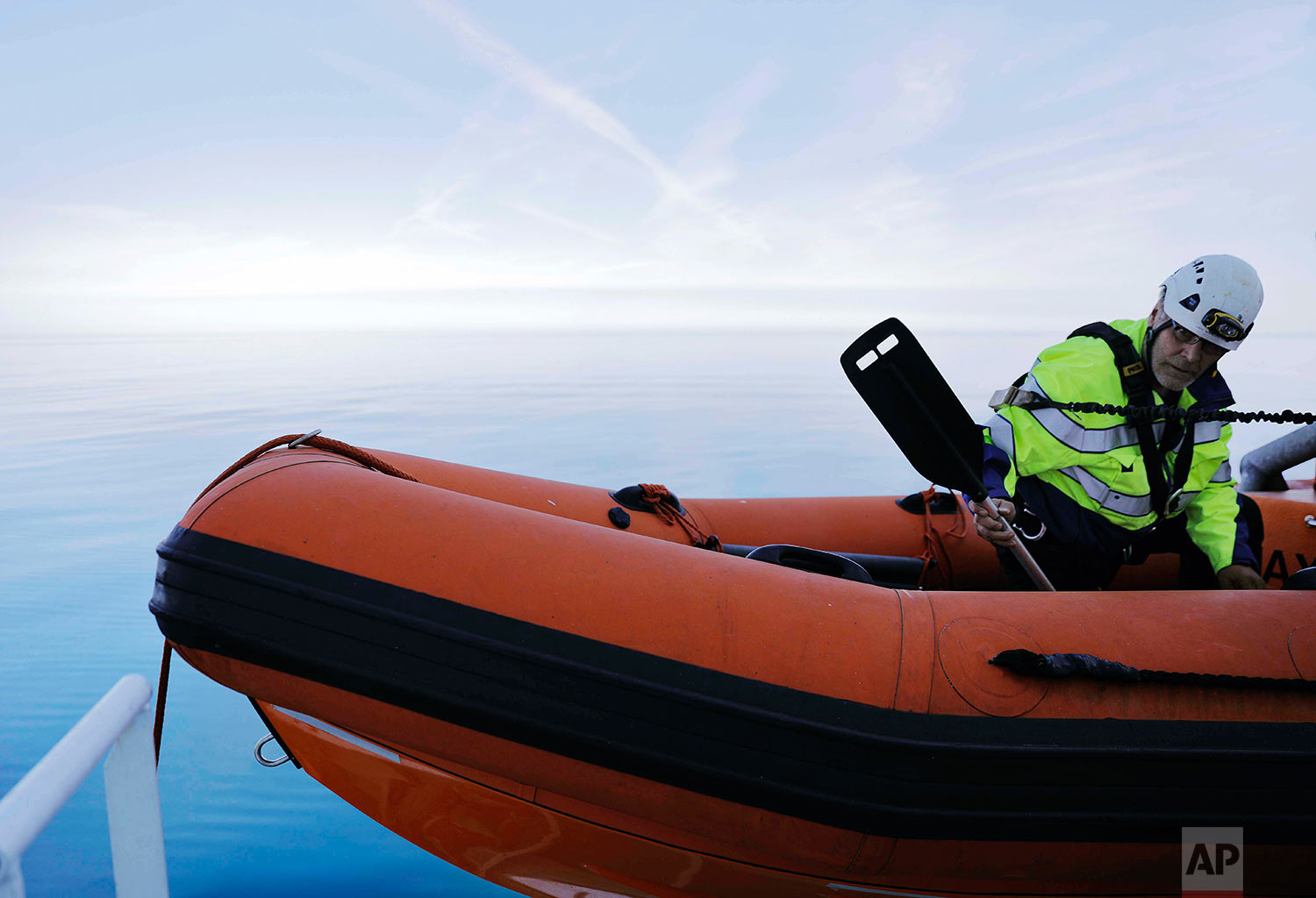
In this Thursday, July 13, 2017 photo, able seaman Auvo Sinkkonen checks a rescue boat during a maintenance inspection aboard the Finnish icebreaker MSV Nordica as it sails the Bering Sea to traverse the Arctic's Northwest Passage. The bright orange lifeboats are made of fiberglass, measure 31 by 11 feet and have provisions for more than a week at sea. (AP Photo/David Goldman)
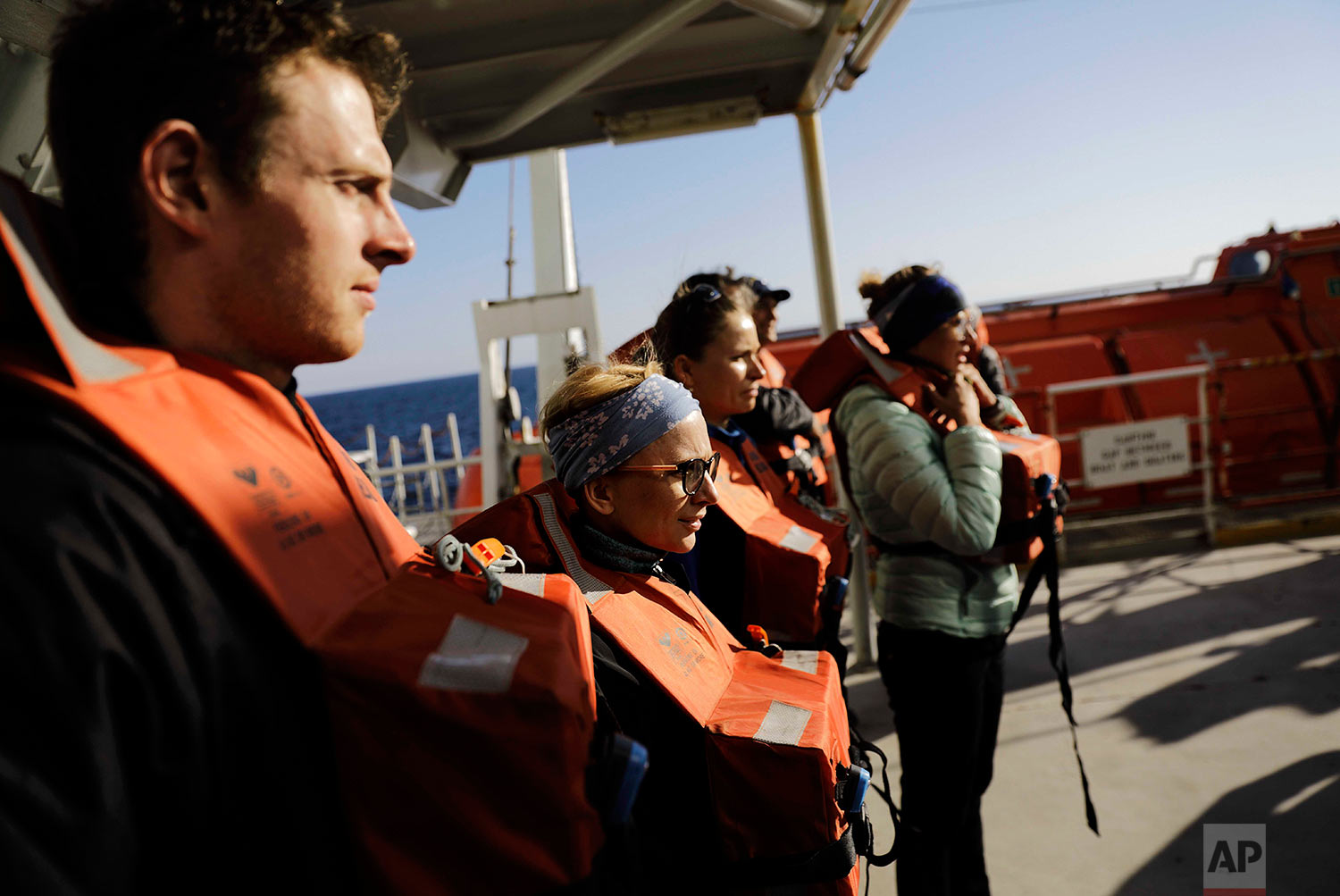
In this Thursday, July 6, 2017 photo, researchers Scott Joblin, from left, and Ilona Mettiainen, wear life vests during a safety drill with fellow personnel aboard the Finnish icebreaker MSV Nordica as it sails the North Pacific Ocean to traverse the Arctic's Northwest Passage. The MSV Nordica icebreaker has all the safety equipment of a modern oceangoing vessel, plus some more because it works in hostile and remote Arctic waters. In a general emergency, such as a hole in the hull, those aboard would grab a survival suit stowed beneath each bunk and head for one of two muster stations on deck to don a life vest. (AP Photo/David Goldman)
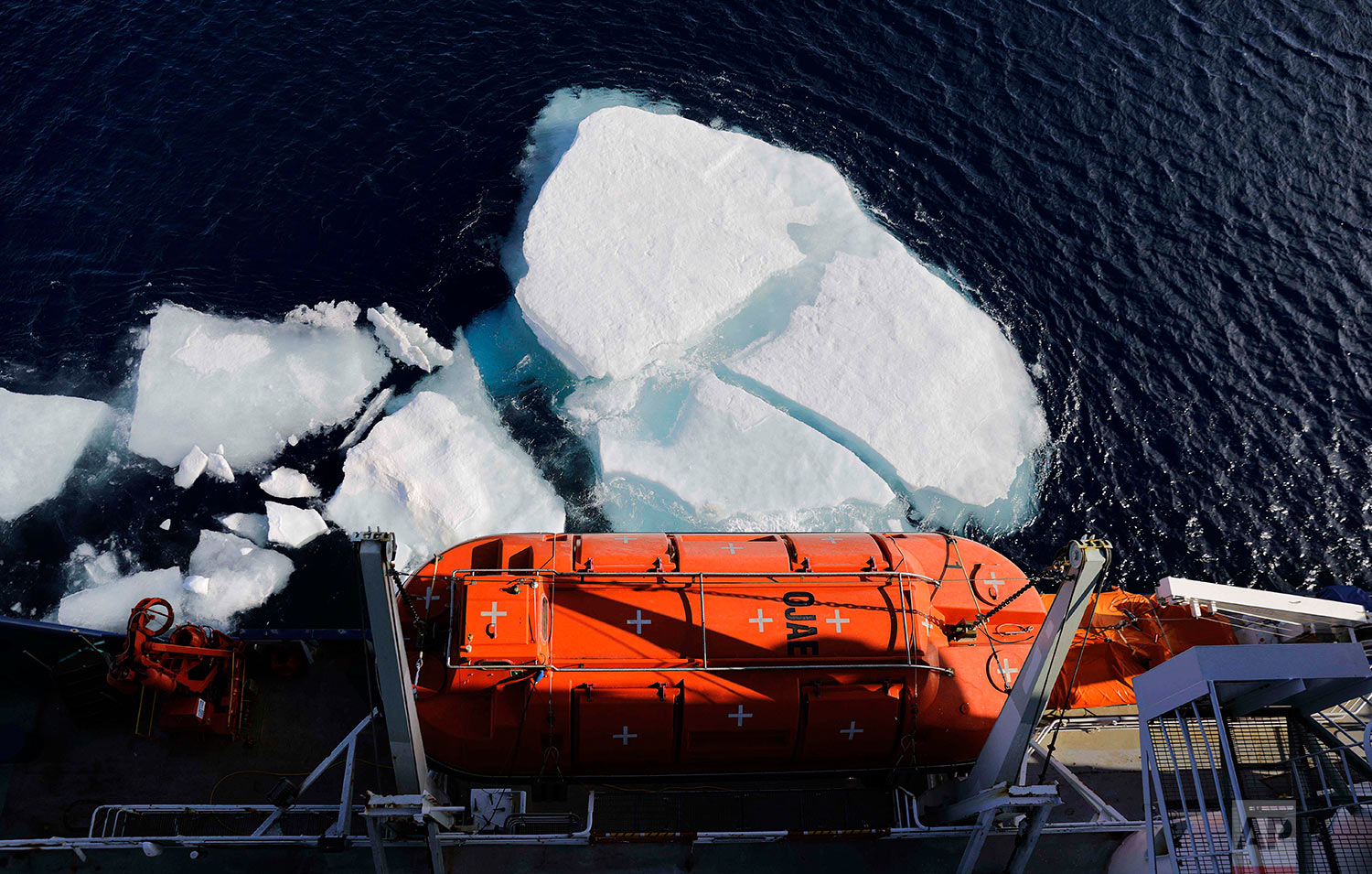
In this Sunday, July 16, 2017, sea ice breaks apart as the Finnish icebreaker MSV Nordica equipped with enclosed life boats sails the Chukchi Sea to traverse the Arctic's Northwest Passage. The MSV Nordica icebreaker has all the safety equipment of a modern oceangoing vessel, plus some more because it works in hostile and remote Arctic waters. In a general emergency, such as a hole in the hull, those aboard would grab a survival suit stowed beneath each bunk and head for one of two muster stations on deck to don a life vest. (AP Photo/David Goldman)
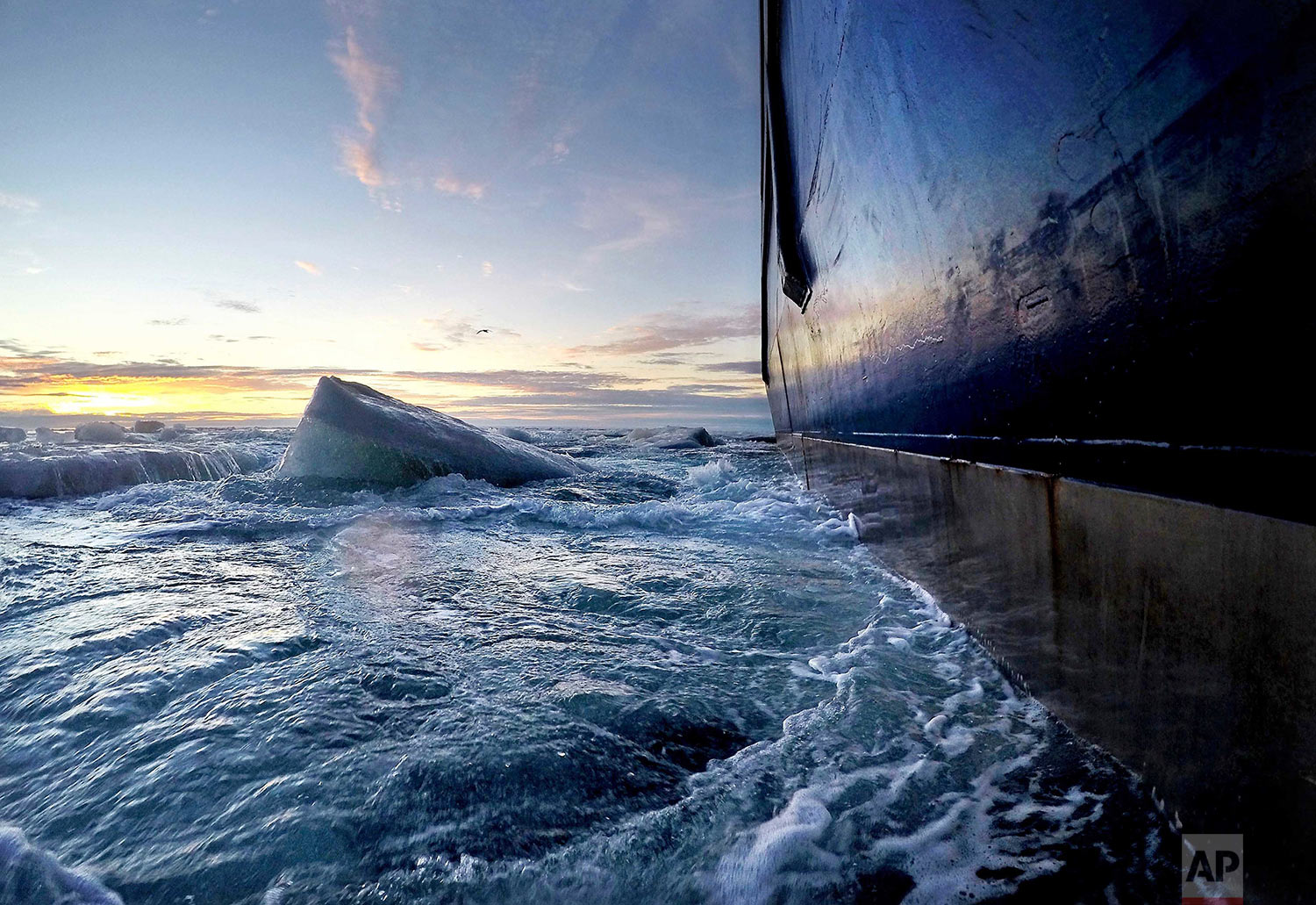
Broken sea ice emerges from under the hull of the Finnish icebreaker MSV Nordica as it sails through the Victoria Strait while traversing the Arctic's Northwest Passage, Friday, July 21, 2017. Sea ice forms when the top layer of water reaches freezing point, usually around the start of October. As temperatures continue to fall this first-year ice grows downward until it is several feet thick. If the ice survives the following summer melt it becomes second-year ice. Another cycle and it becomes multi-year ice, which is the toughest kind. (AP Photo/David Goldman)
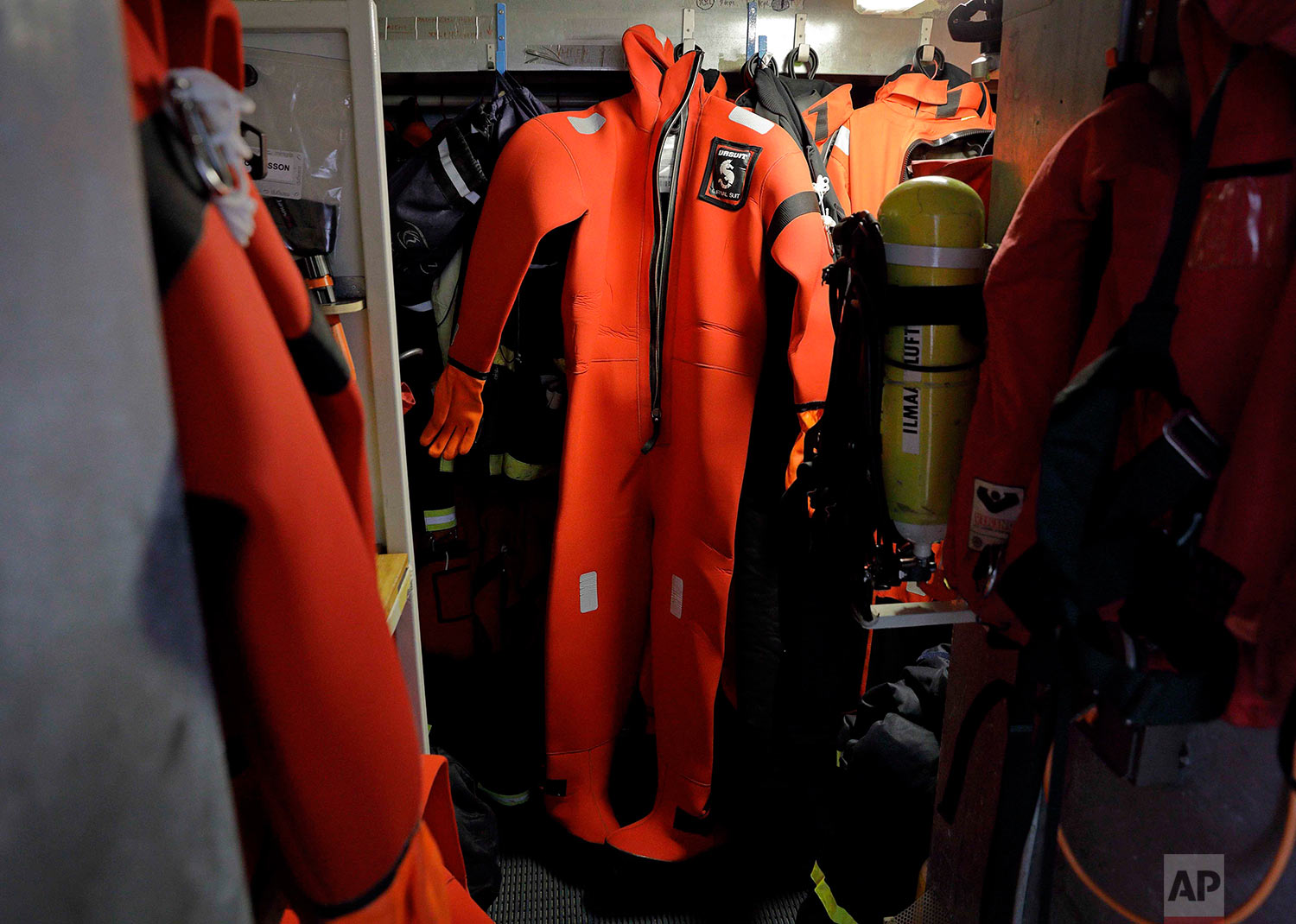
A survival suit is displayed aboard the Finnish icebreaker MSV Nordica as it sails through Lancaster Sound while traversing the Northwest Passage through the Canadian Arctic Archipelago, Monday, July 24, 2017. The MSV Nordica icebreaker has all the safety equipment of a modern oceangoing vessel, plus some more because it works in hostile and remote Arctic waters. In a general emergency, such as a hole in the hull, those aboard would grab a survival suit stowed beneath each bunk and head for one of two muster stations on deck to don a life vest. (AP Photo/David Goldman)
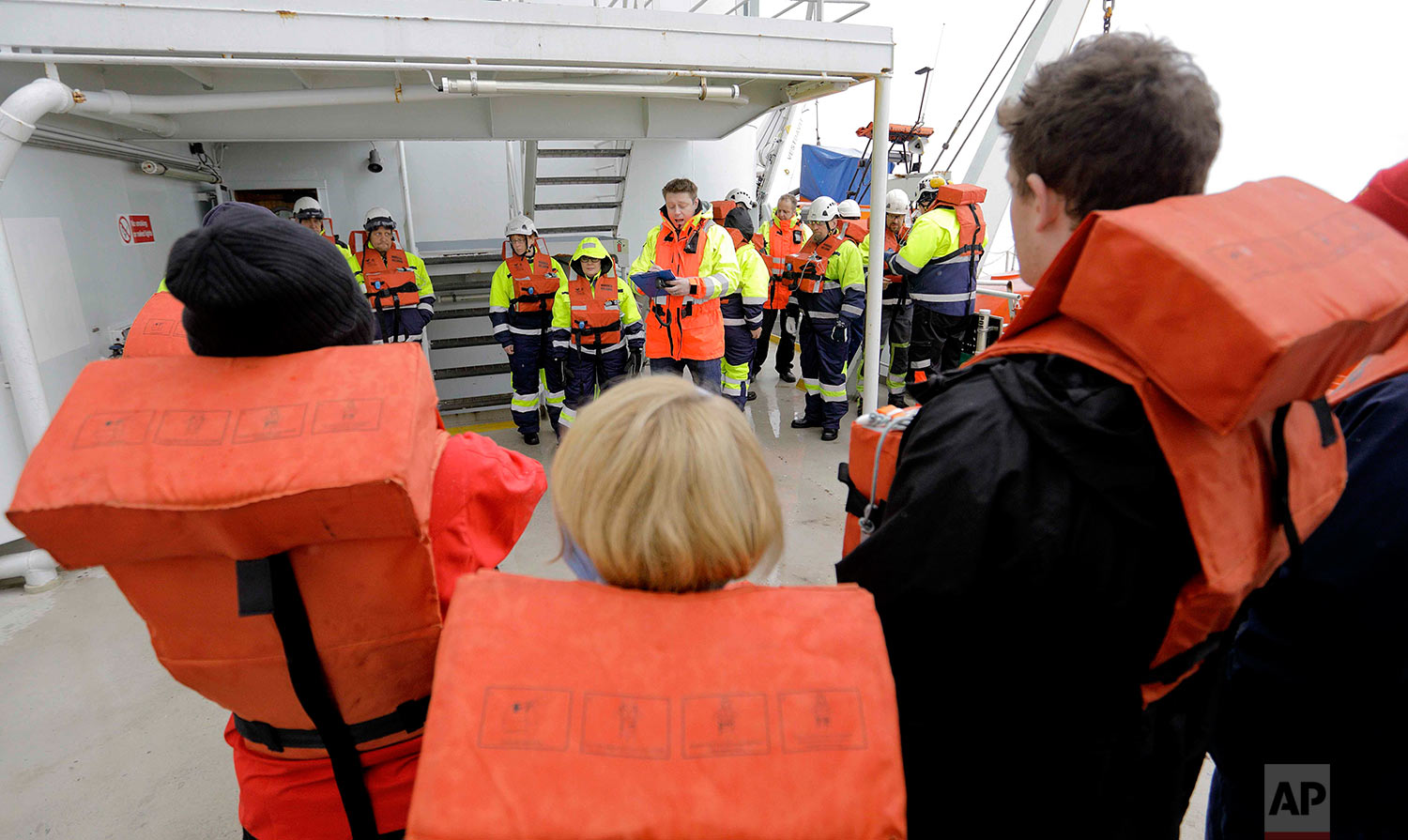
In this Sunday, July 23, 2017, photo, second officer Ilkka Alhoke, center, conducts a safety drill aboard the Finnish icebreaker MSV Nordica as it sails through Barrow Strait while traversing the Northwest Passage through the Canadian Arctic Archipelago. The MSV Nordica icebreaker has all the safety equipment of a modern oceangoing vessel, plus some more because it works in hostile and remote Arctic waters. In a general emergency, such as a hole in the hull, those aboard would grab a survival suit stowed beneath each bunk and head for one of two muster stations on deck to don a life vest. (AP Photo/David Goldman)
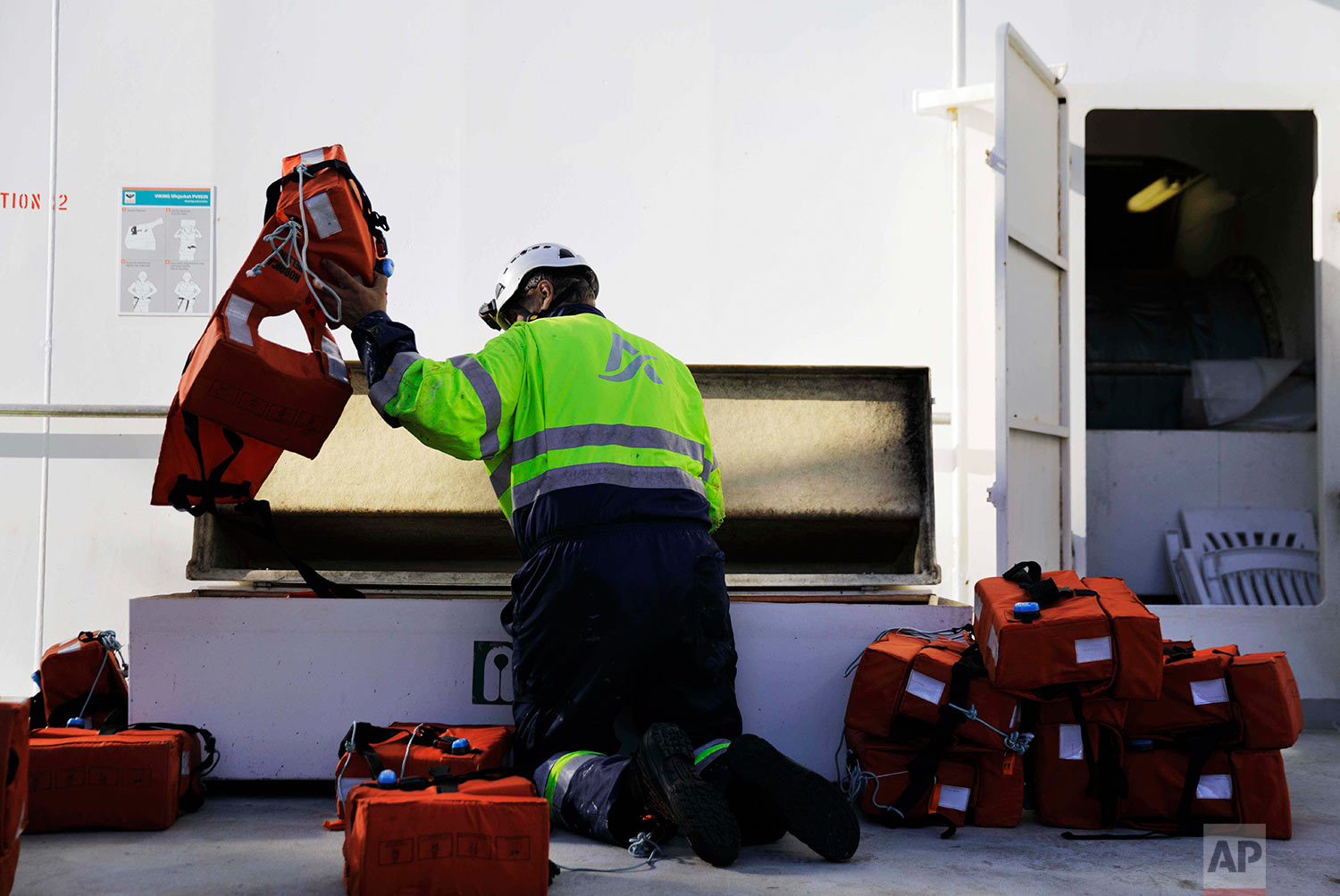
In this July 6, 2017, photo, able seaman Auvo Sinkkonen puts away life vests after a safety drill aboard the Finnish icebreaker MSV Nordica as it sails the Northwest Passage through the Canadian Arctic Archipelago. The MSV Nordica icebreaker has all the safety equipment of a modern oceangoing vessel, plus some more because it works in hostile and remote Arctic waters. In a general emergency, such as a hole in the hull, those aboard would grab a survival suit stowed beneath each bunk and head for one of two muster stations on deck to don a life vest. (AP Photo/David Goldman)
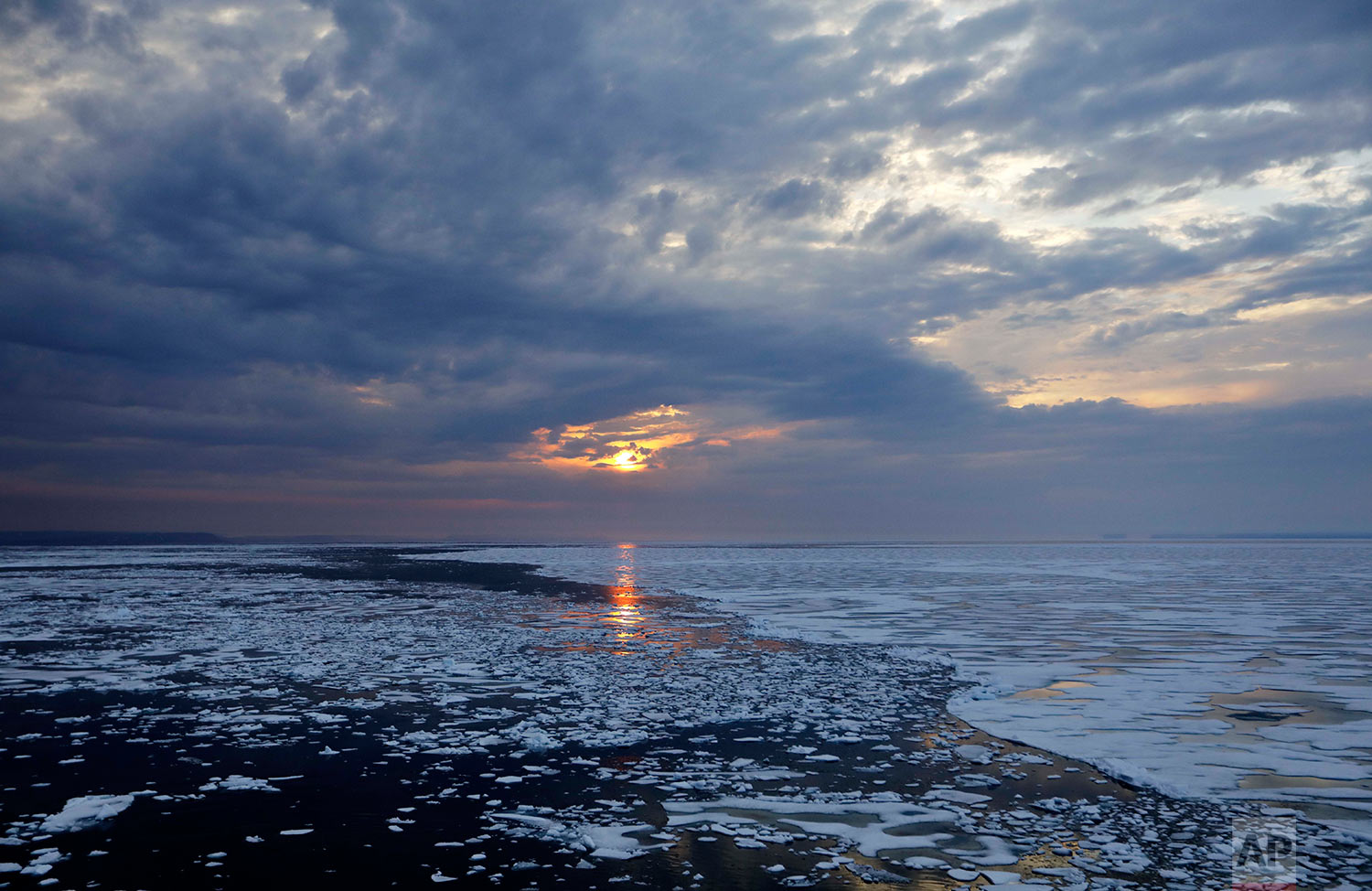
The sun sets over melting sea ice on Peel Sound along the Northwest Passage in the Canadian Arctic Archipelago, Sunday, July 23, 2017. Because of global warming, more sea ice is being lost each summer than is being replenished in winters. Although sea ice is likely to continue forming each winter it may be restricted to even higher latitudes. Less sea ice coverage also means that less sunlight will be reflected off the surface of the ocean in a process known as the albedo effect. The oceans will absorb more heat, further fueling global warming. (AP Photo/David Goldman)
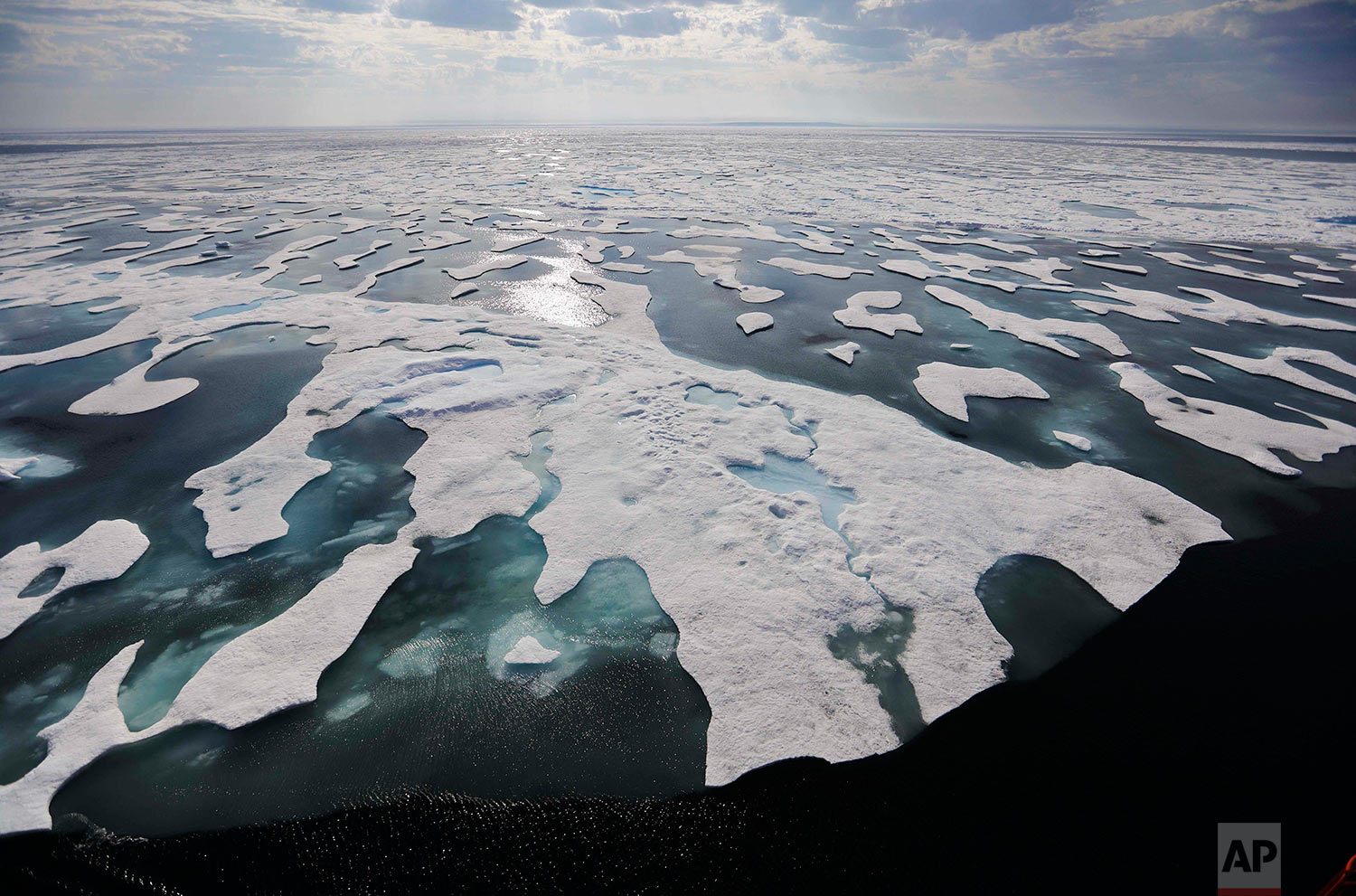
Sea ice melts on the Franklin Strait along the Northwest Passage in the Canadian Arctic Archipelago, Saturday, July 22, 2017. Because of climate change, more sea ice is being lost each summer than is being replenished in winters. Less sea ice coverage also means that less sunlight will be reflected off the surface of the ocean in a process known as the albedo effect. The oceans will absorb more heat, further fueling global warming. (AP Photo/David Goldman)
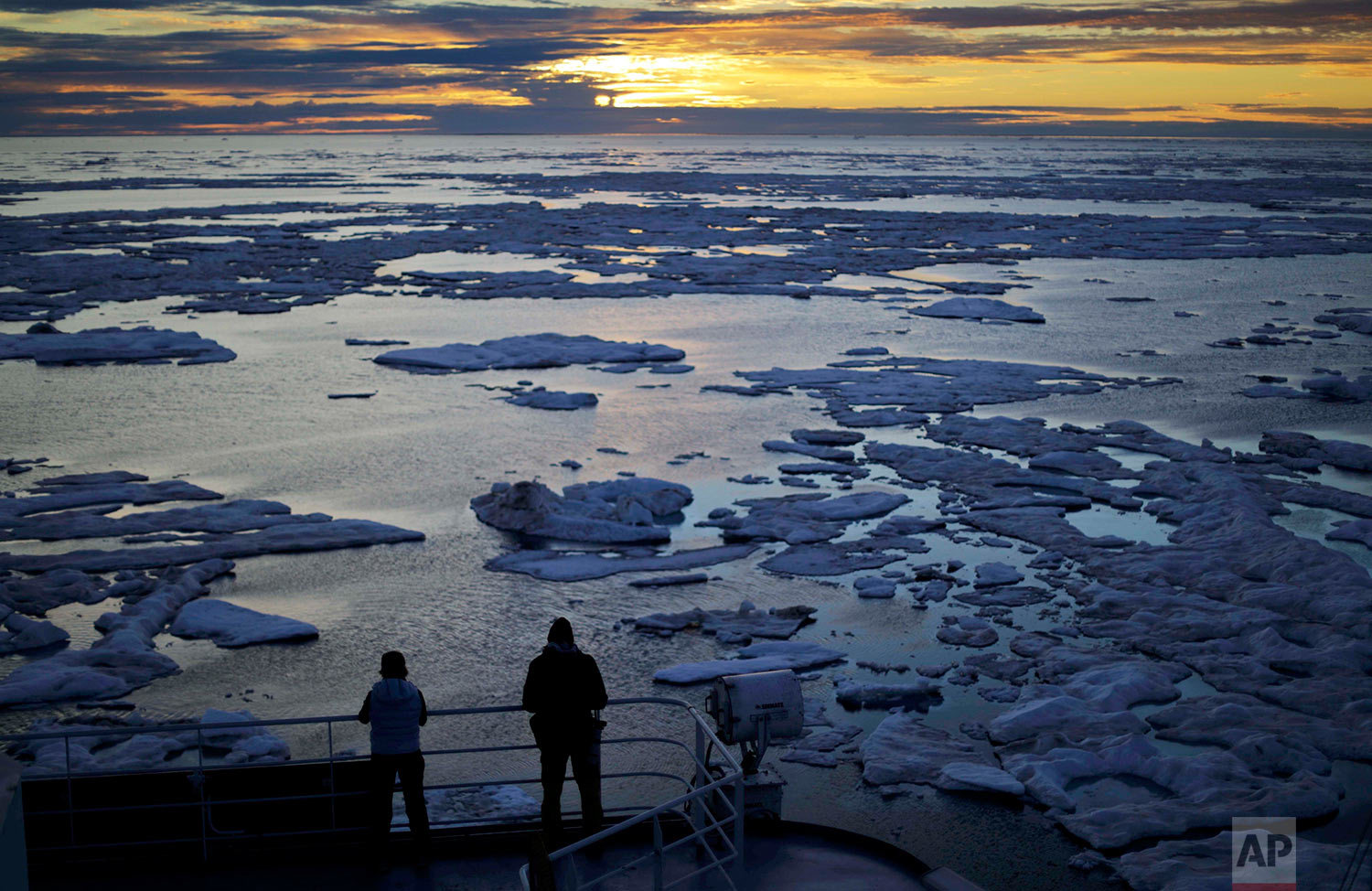
Researchers look out from the Finnish icebreaker MSV Nordica as the sun sets over sea ice floating on the Victoria Strait along the Northwest Passage in the Canadian Arctic Archipelago, Friday, July 21, 2017. Sea ice plays an important role in the global climate system by cooling the surrounding water and air. It helps maintain ocean and atmospheric currents that affect weather which is characteristic for certain parts of the world, such as the comparatively mild temperatures found in western Europe. (AP Photo/David Goldman)
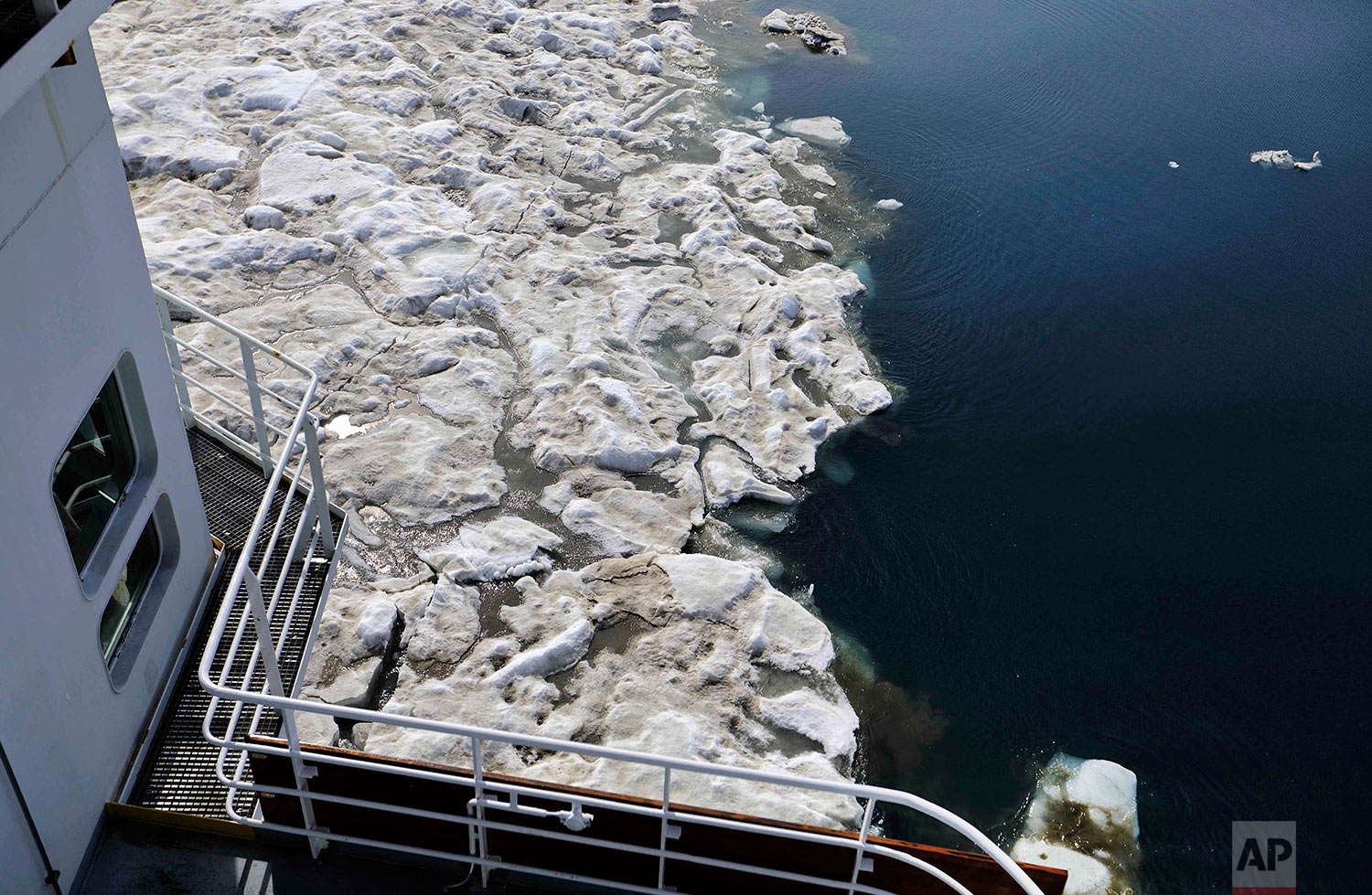
The Finnish icebreaker MSV Nordica sails through sea ice floating on the Beaufort Sea off the coast of Alaska while traversing the Arctic's Northwest Passage, Sunday, July 16, 2017. Because of global warming, more sea ice is being lost each summer than is being replenished in winters. Less sea ice coverage also means that less sunlight will be reflected off the surface of the ocean in a process known as the albedo effect. The oceans will absorb more heat, further fueling global warming. (AP Photo/David Goldman)
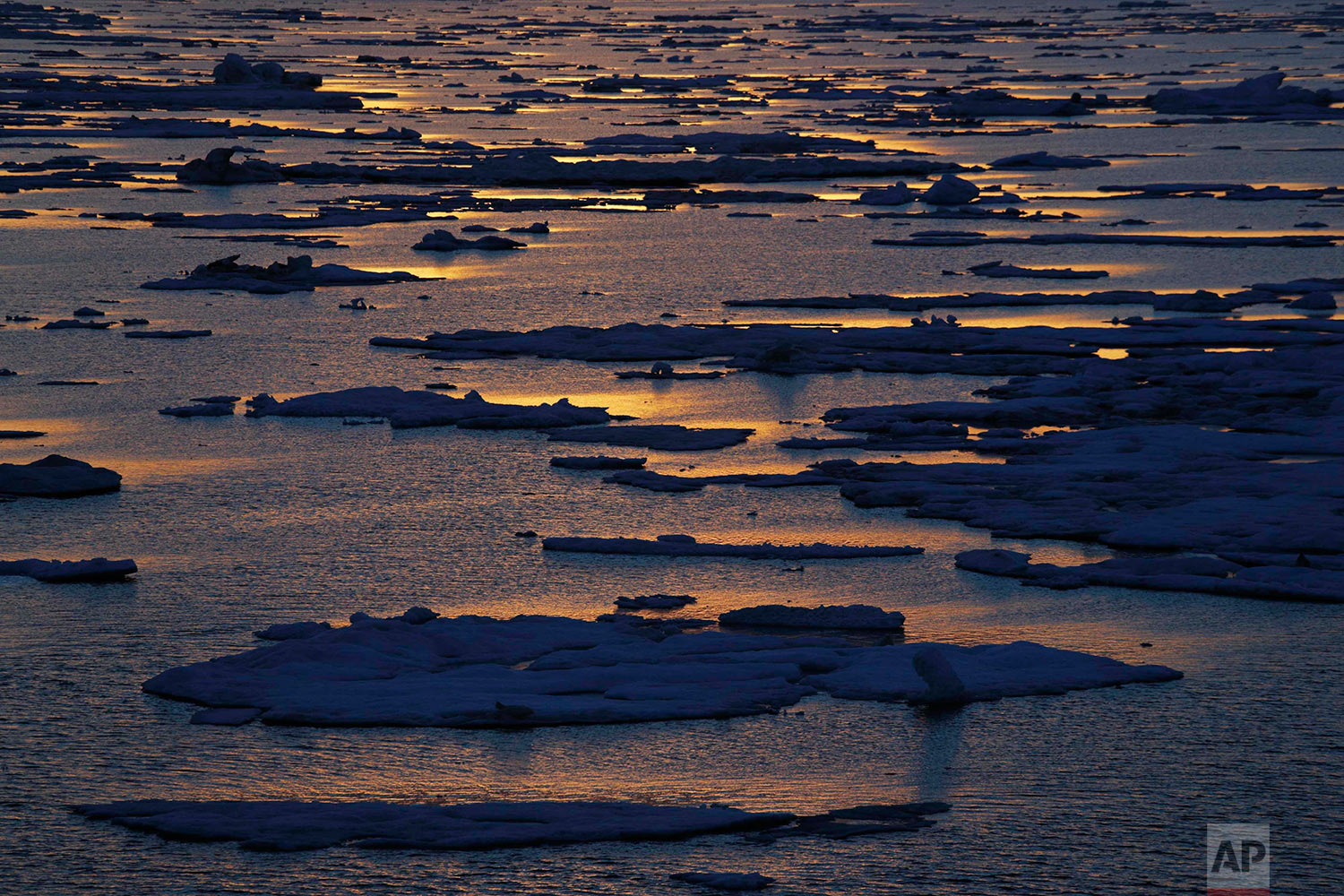
The sun sets over sea ice floating on the Victoria Strait along the Northwest Passage in the Canadian Arctic Archipelago, Friday, July 21, 2017. Sea ice forms when the top layer of water reaches freezing point, usually around the start of October. As temperatures continue to fall this first-year ice grows downward until it is several feet thick. If the ice survives the following summer melt it becomes second-year ice. Another cycle and it becomes multi-year ice _ which is the toughest kind. (AP Photo/David Goldman)
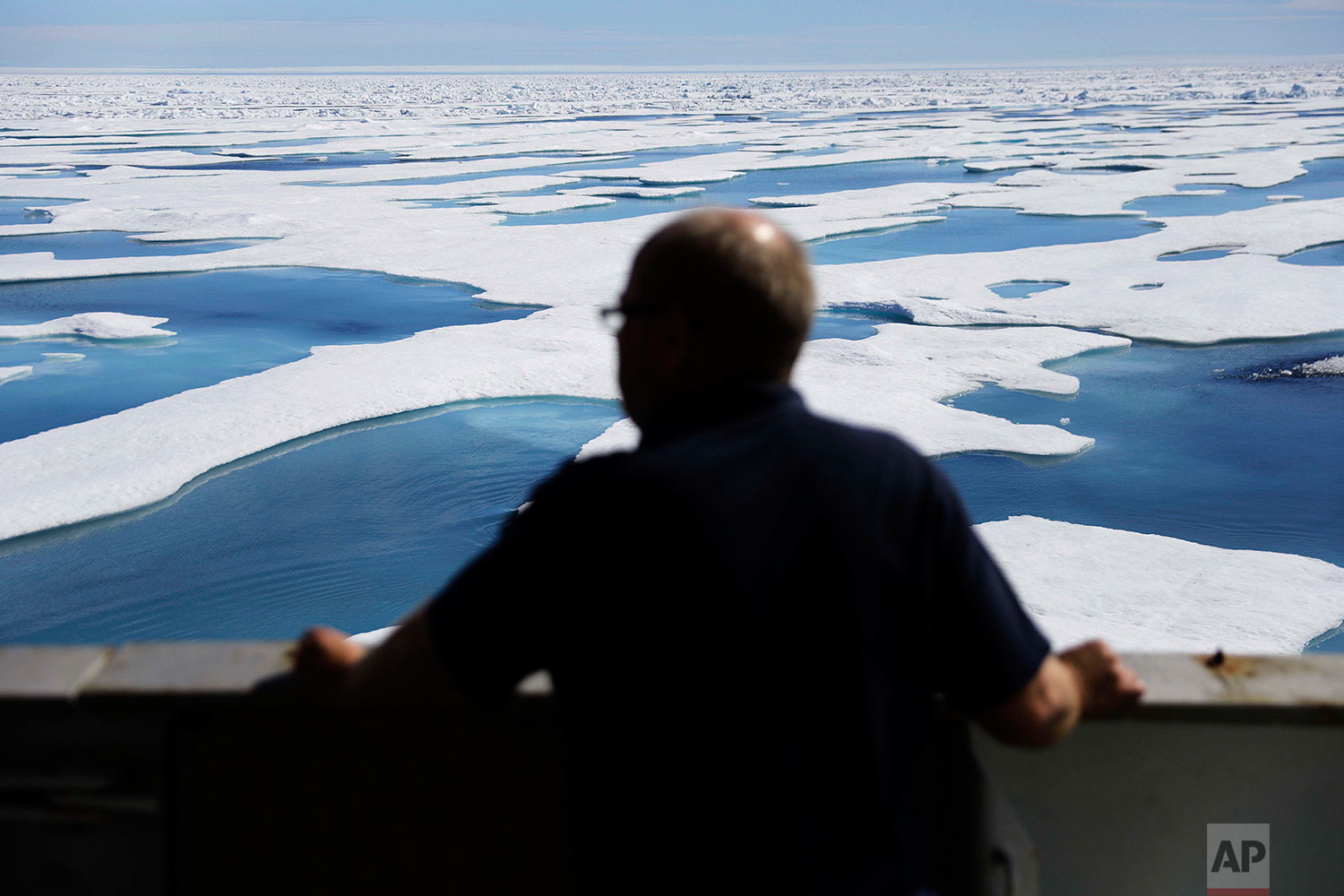
Second officer Juha Tuomi looks out from Finnish icebreaker MSV Nordica as it sails into floating sea ice on the Victoria Strait while traversing the Northwest Passage in the Canadian Arctic Archipelago, Friday, July 21, 2017. Sea ice plays an important role in the global climate system by cooling the surrounding water and air. (AP Photo/David Goldman)
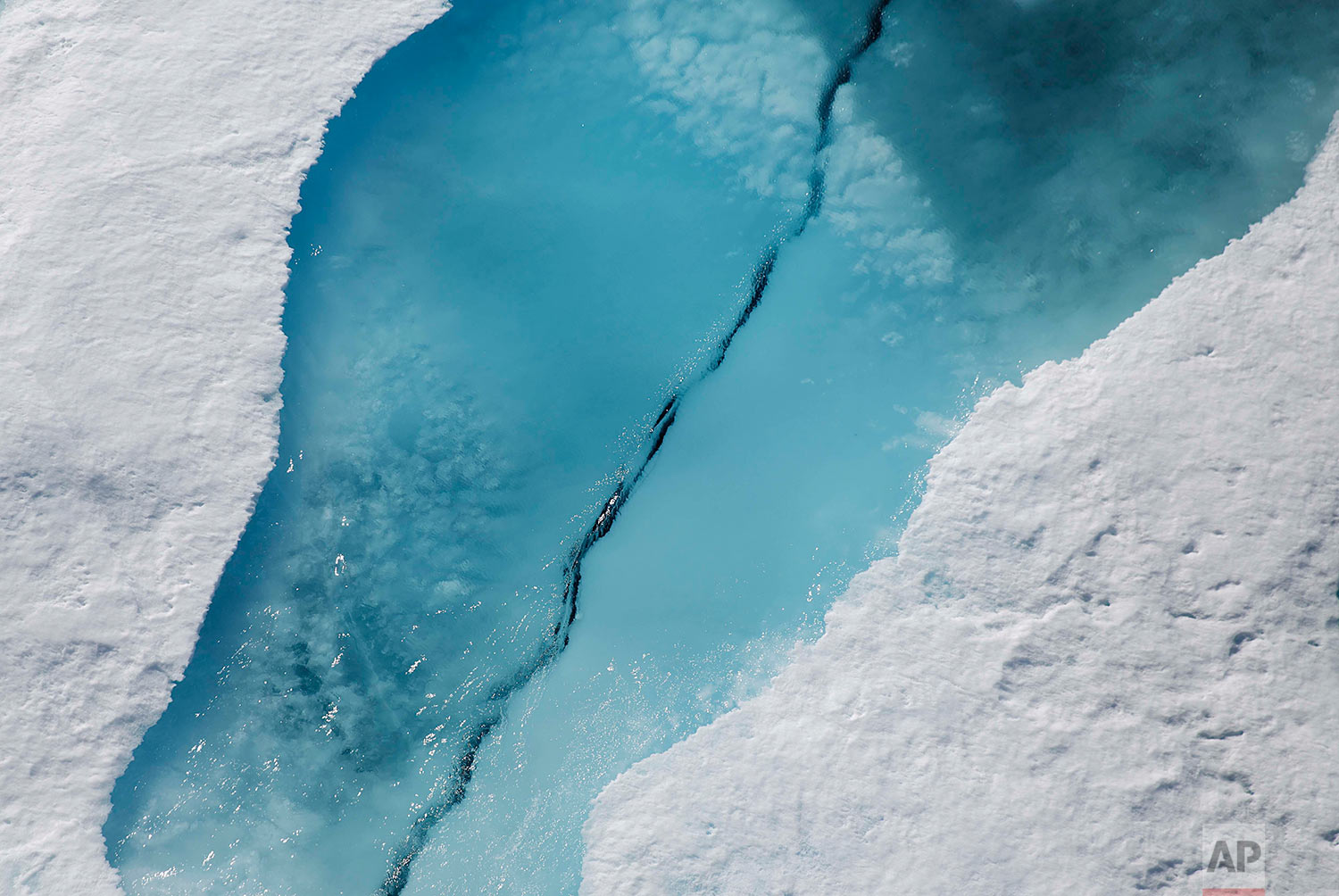
Sea ice cracks as the Finnish icebreaker MSV Nordica passes through the Victoria Strait along the Northwest Passage in the Canadian Arctic Archipelago, Friday, July 21, 2017. Sea ice helps maintain ocean and atmospheric currents that affect weather which is characteristic for certain parts of the world, such as the comparatively mild temperatures found in western Europe. (AP Photo/David Goldman)
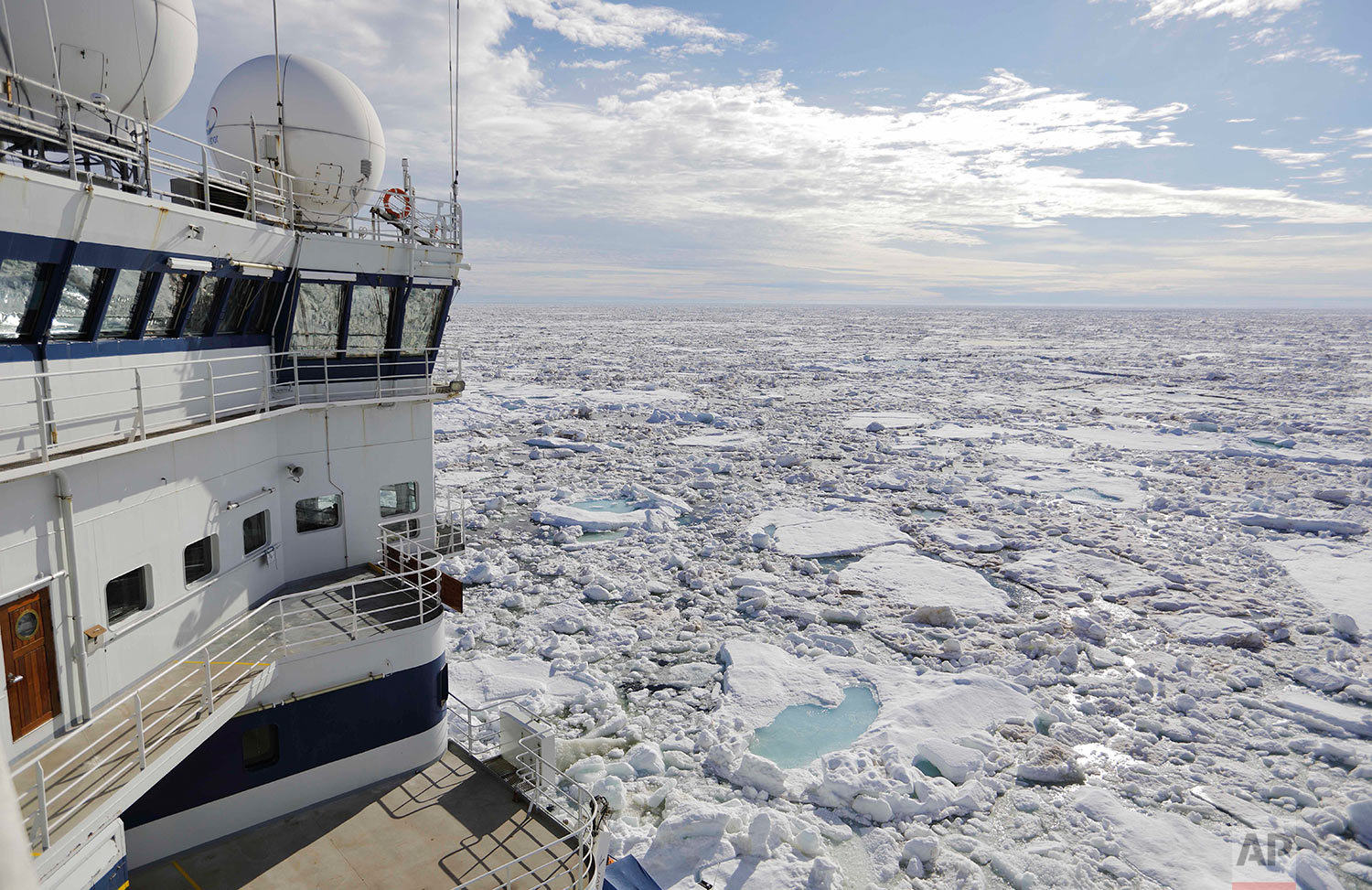
The Finnish icebreaker MSV Nordica sails through sea ice floating on the Victoria Strait while traversing the Arctic's Northwest Passage, Friday, July 21, 2017. The AP is accompanying a group of international researchers is sailing into the Arctic Sea aboard the Finnish icebreaker to traverse the Northwest Passage and record the environmental and social changes that are taking place in one of the most forbidding corners of the world. (AP Photo/David Goldman)
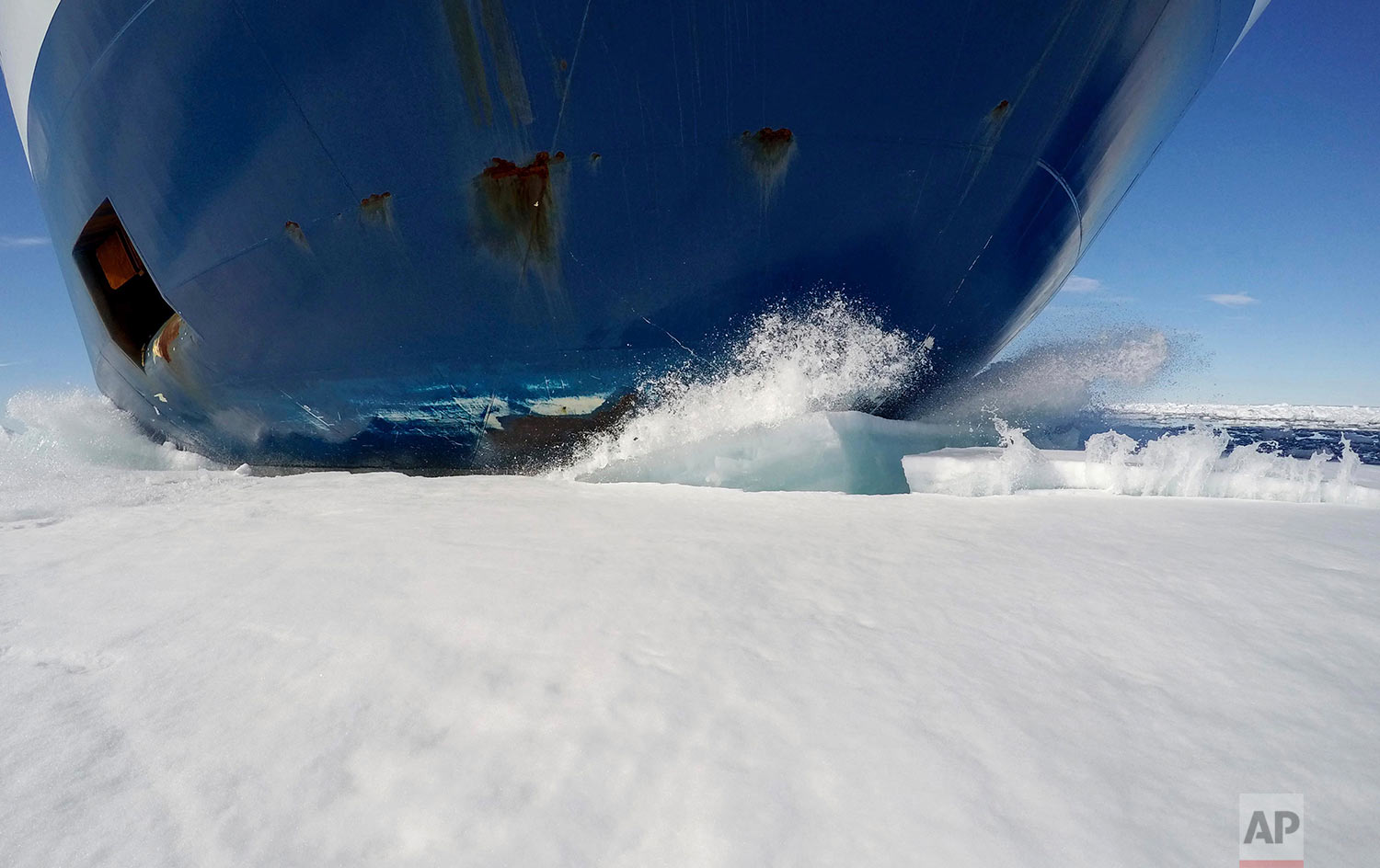
The bow of the Finnish icebreaker MSV Nordica drives through sea ice as it sails the Victoria Strait while traversing the Arctic's Northwest Passage, Friday, July 21, 2017. The MSV Nordica is equipped with several heavy-duty engines and a hardened bow and hull that allow it either to drive through thin layers of ice or to crush thicker sheets by rising onto the ice with the help of its rounded hull. The ship's massive weight breaks the ice from above. (AP Photo/David Goldman)
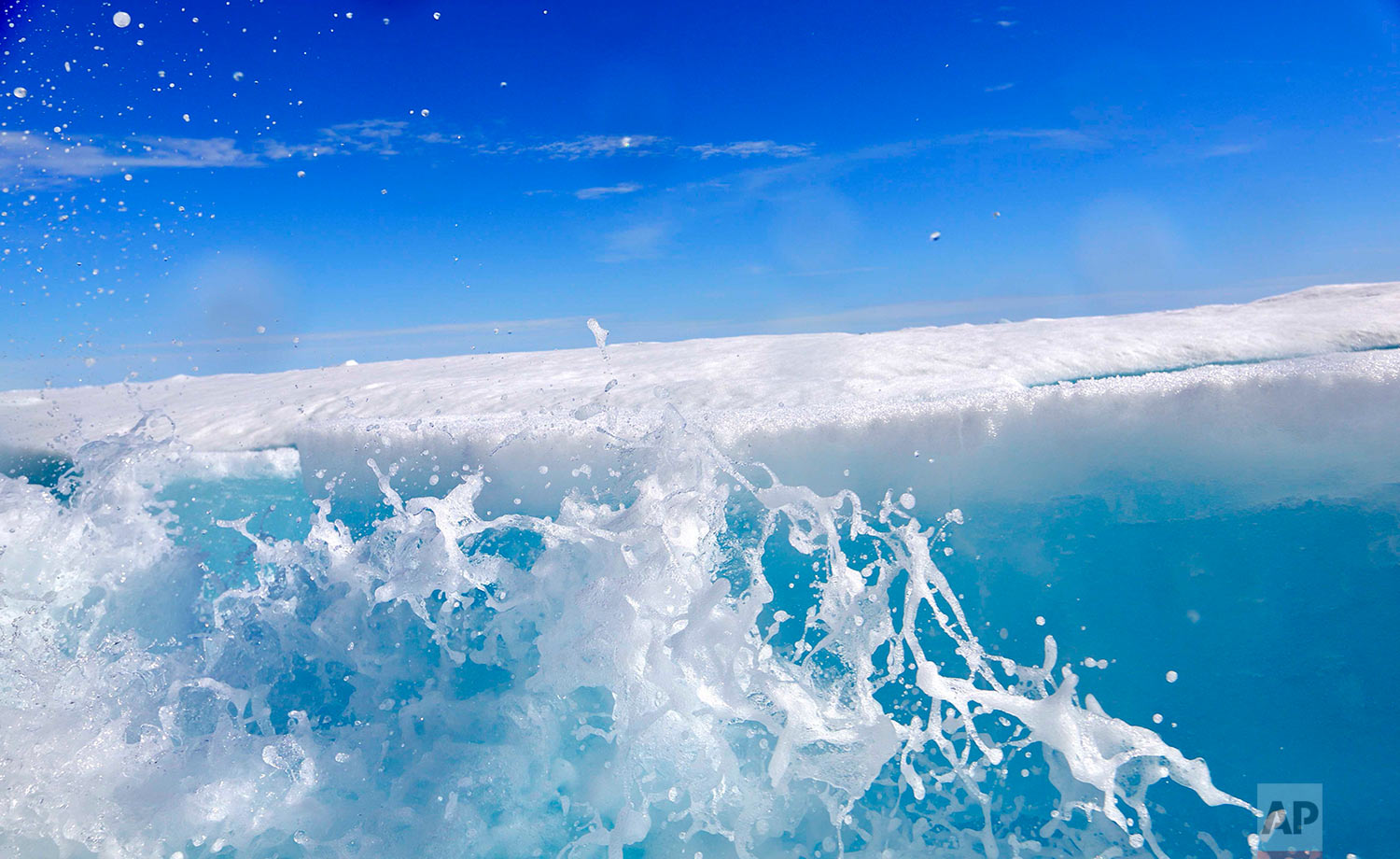
Water sprays as a block of sea ice is broken from the hull of the Finnish icebreaker MSV Nordica as it sails the Victoria Strait while traversing the Arctic's Northwest Passage, Friday, July 21, 2017. Sea ice forms when the top layer of water reaches freezing point, usually around the start of October. As temperatures continue to fall this first-year ice grows downward until it is several feet thick. If the ice survives the following summer melt it becomes second-year ice. Another cycle and it becomes multi-year ice, which is the toughest kind. (AP Photo/David Goldman)

Broken sea ice emerges from under the hull of the Finnish icebreaker MSV Nordica as it sails through the Victoria Strait while traversing the Arctic's Northwest Passage, Friday, July 21, 2017. (AP Photo/David Goldman)
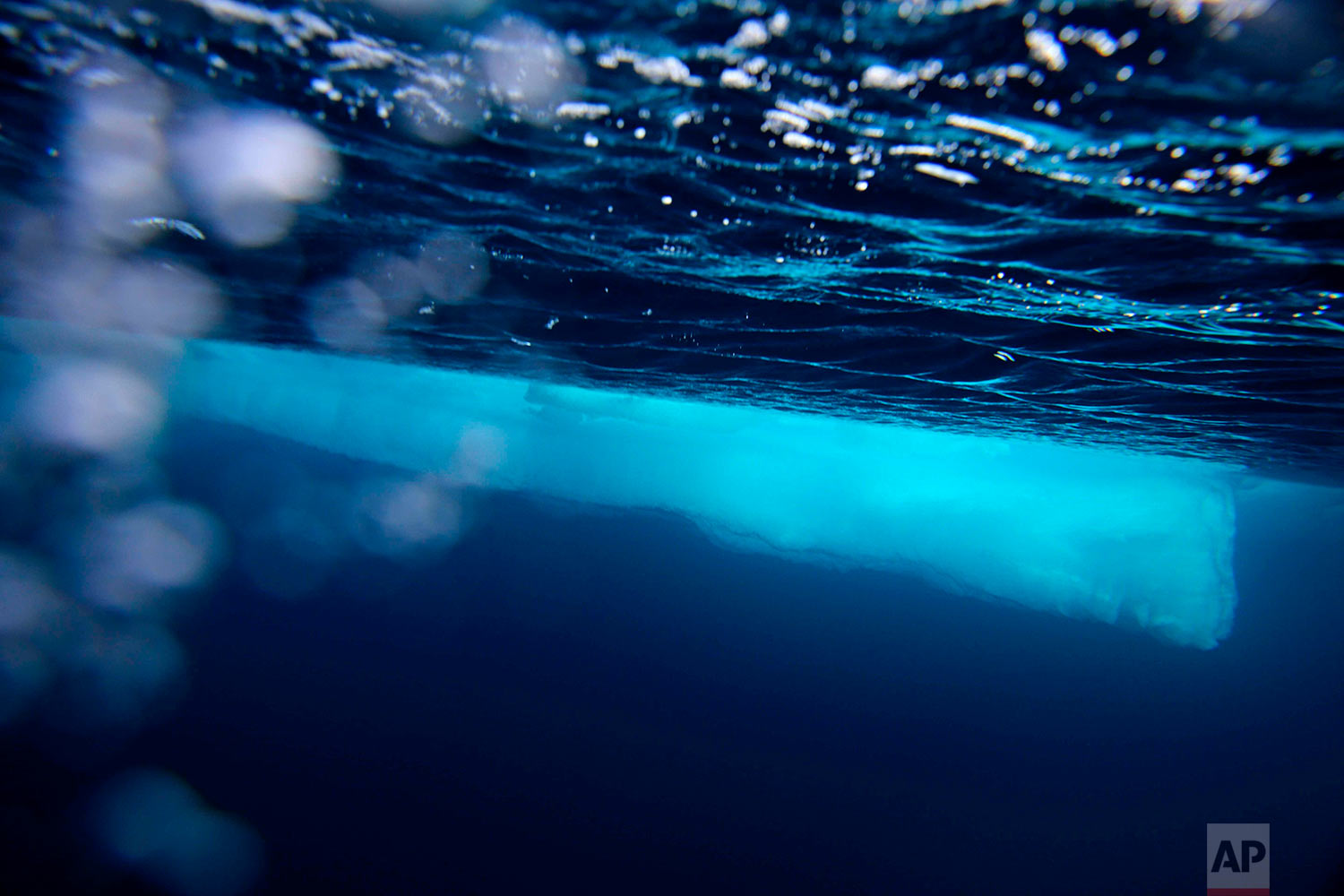
A block of sea ice floats in the Franklin Strait in the wake of the Finnish icebreaker MSV Nordica as it sails the Arctic's Northwest Passage, Saturday, July 22, 2017. Sea ice forms when the top layer of water reaches freezing point, usually around the start of October. As temperatures continue to fall this first-year ice grows downward until it is several feet thick. If the ice survives the following summer melt it becomes second-year ice. Another cycle and it becomes multi-year ice, which is the toughest kind. (AP Photo/David Goldman)
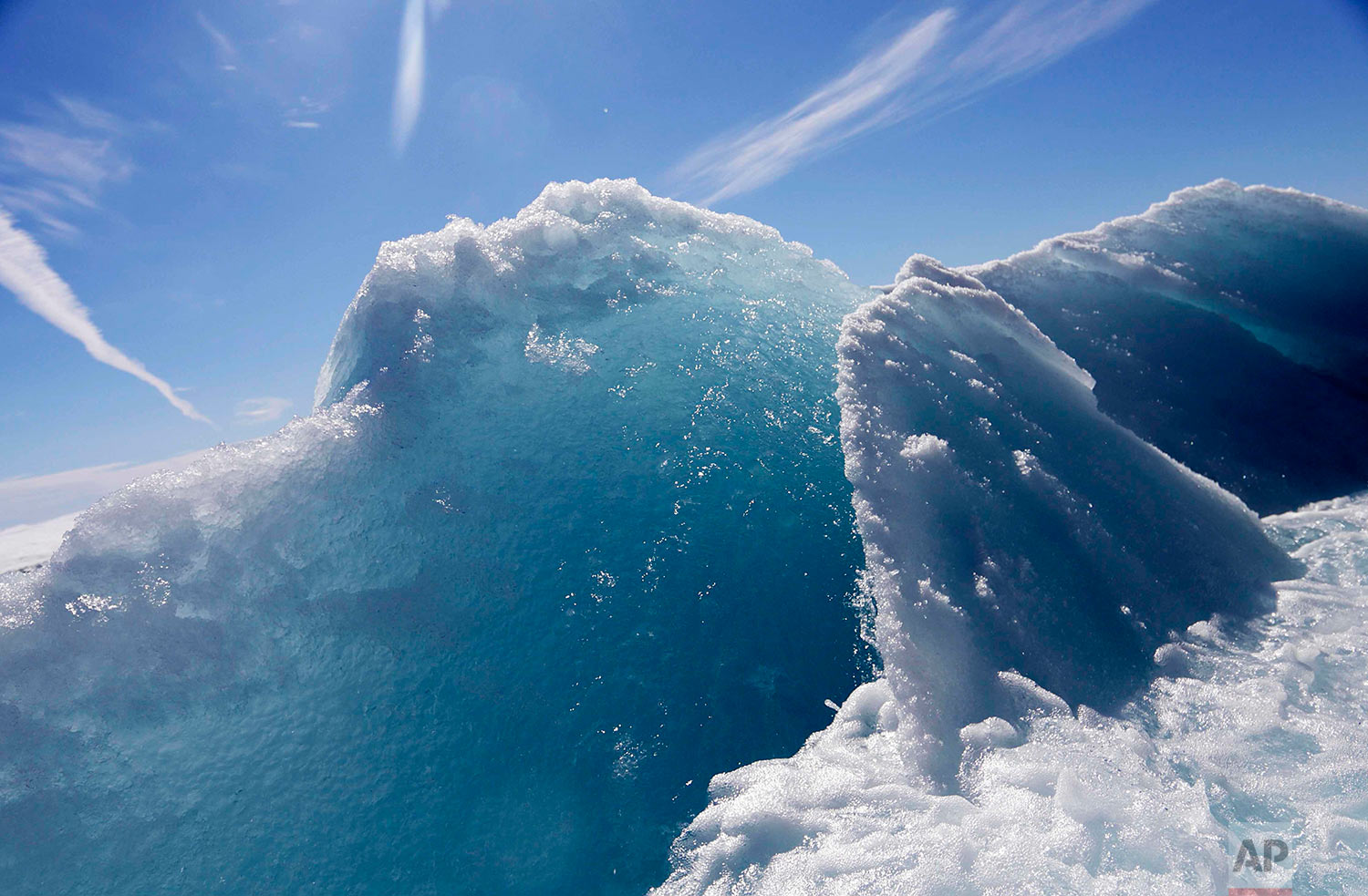
Broken sea ice emerges from under the hull of the Finnish icebreaker MSV Nordica as it sails through the Victoria Strait while traversing the Arctic's Northwest Passage, Friday, July 21, 2017. As a general rule, the older ice gets the more it turns blue and acquires mounds, so-called hummocks, on top from years of crashing into other floes. (AP Photo/David Goldman)
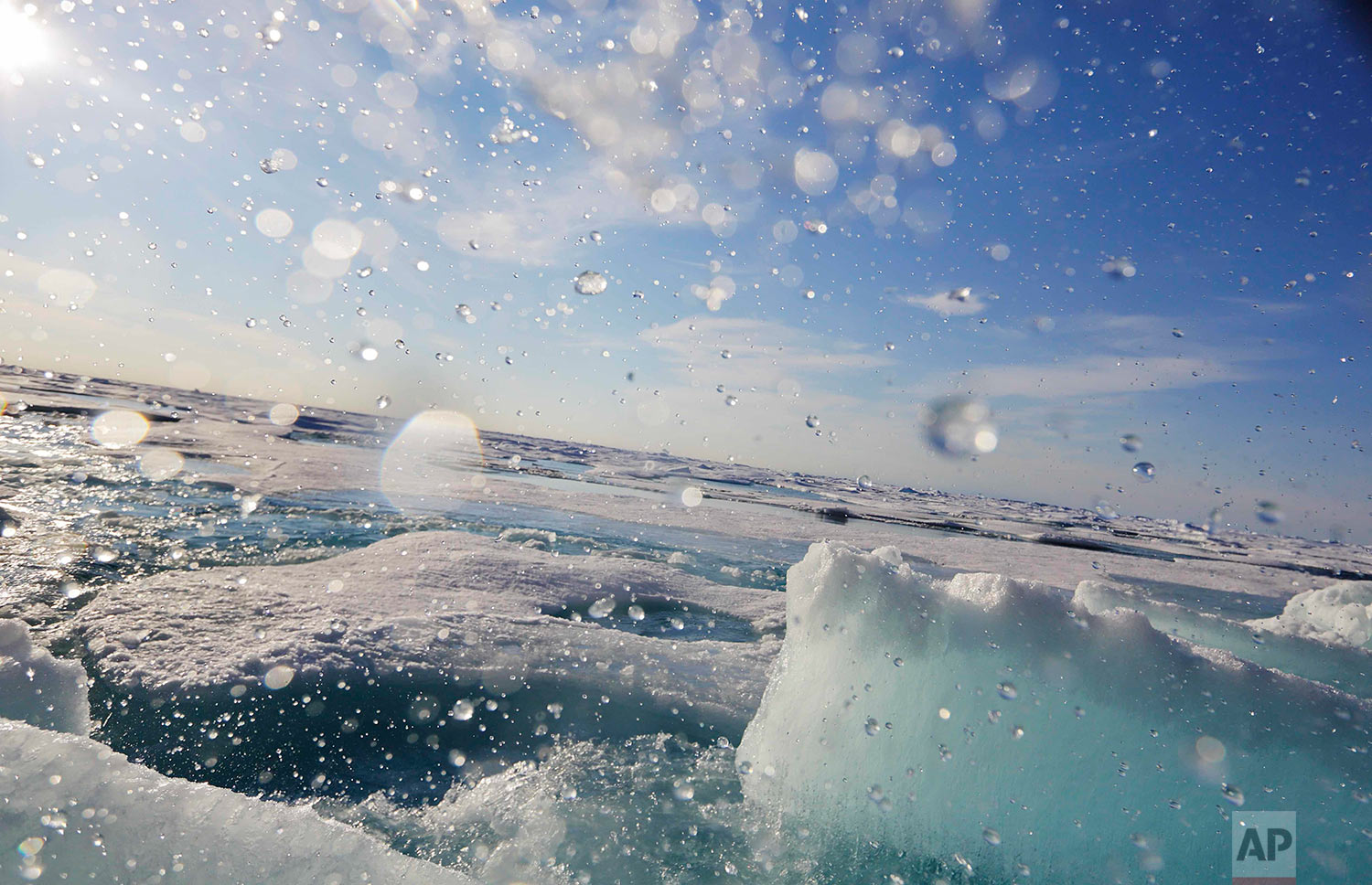
Water sprays as a block of sea ice is broken from the hull of the Finnish icebreaker MSV Nordica as it sails the Victoria Strait while traversing the Arctic's Northwest Passage, Friday, July 21, 2017. (AP Photo/David Goldman)
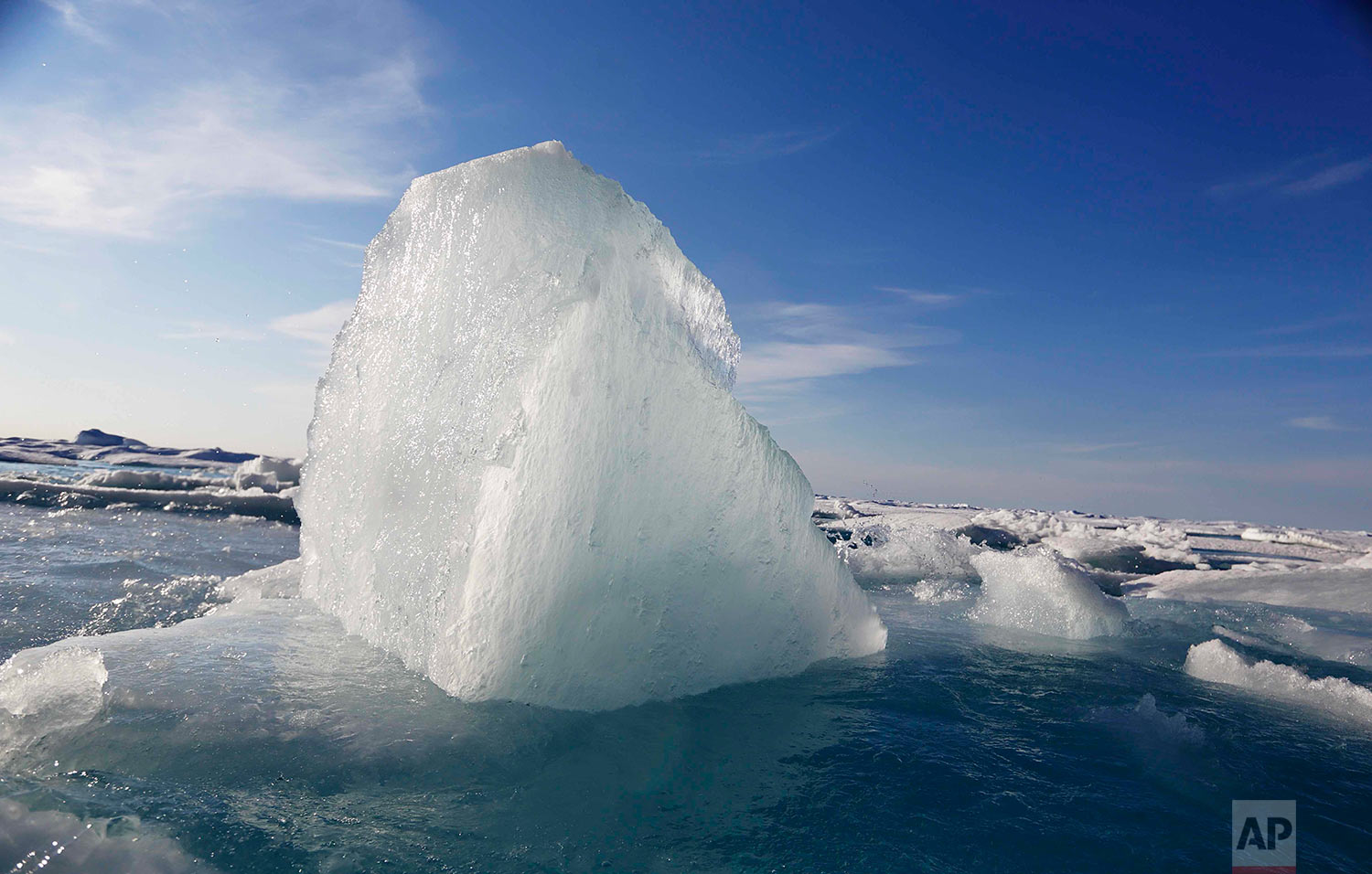
A broken clock of sea ice emerges from under the hull of the Finnish icebreaker MSV Nordica as it sails through the Victoria Strait while traversing the Arctic's Northwest Passage, Friday, July 21, 2017. Sea ice forms when the top layer of water reaches freezing point, usually around the start of October. As temperatures continue to fall this first-year ice grows downward until it is several feet thick. If the ice survives the following summer melt it becomes second-year ice. Another cycle and it becomes multi-year ice, which is the toughest kind. (AP Photo/David Goldman)
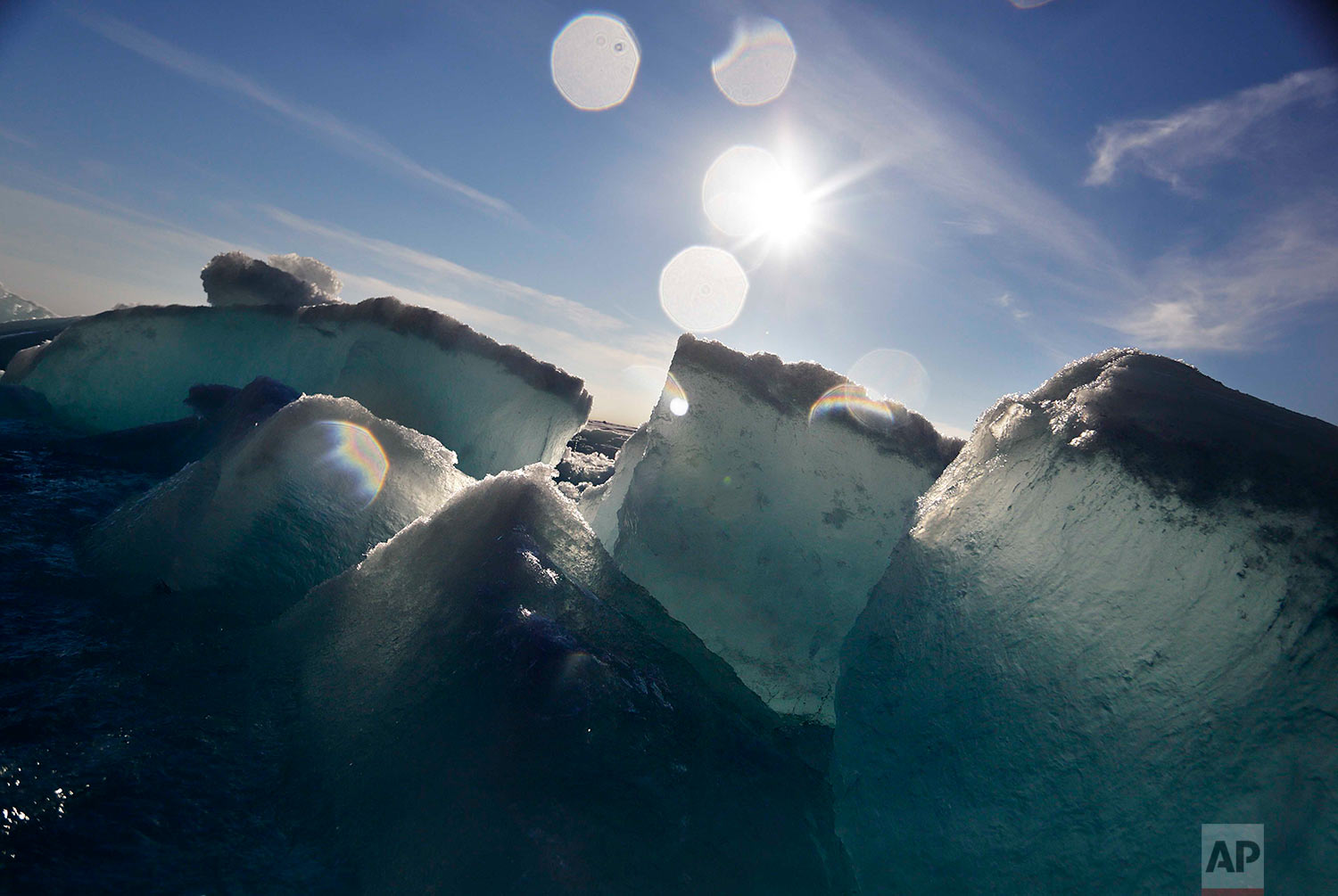
Broken blocks of sea ice emerge from under the hull of the Finnish icebreaker MSV Nordica as it sails through the Victoria Strait while traversing the Arctic's Northwest Passage, Friday, July 21, 2017. Sea ice forms when the top layer of water reaches freezing point, usually around the start of October. As temperatures continue to fall this first-year ice grows downward until it is several feet thick. If the ice survives the following summer melt it becomes second-year ice. Another cycle and it becomes multi-year ice, which is the toughest kind. (AP Photo/David Goldman)
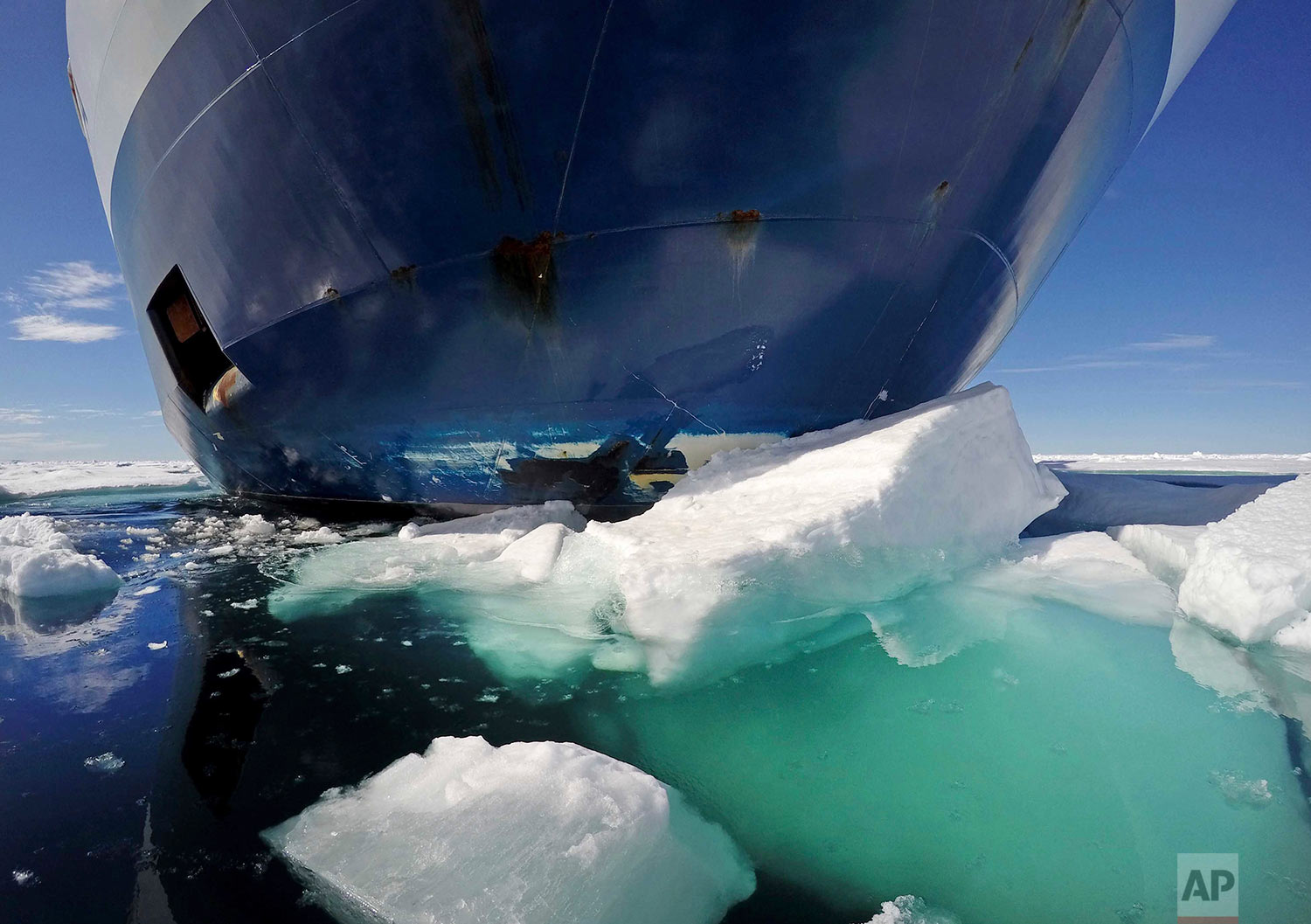
The bow of the Finnish icebreaker MSV Nordica pushes down sea ice as it sails through the Victoria Strait while traversing the Arctic's Northwest Passage, Friday, July 21, 2017. The MSV Nordica is equipped with several heavy-duty engines and a hardened bow and hull that allow it either to drive through thin layers of ice or to crush thicker sheets by rising onto the ice with the help of its rounded hull. The ship's massive weight breaks the ice from above. (AP Photo/David Goldman)
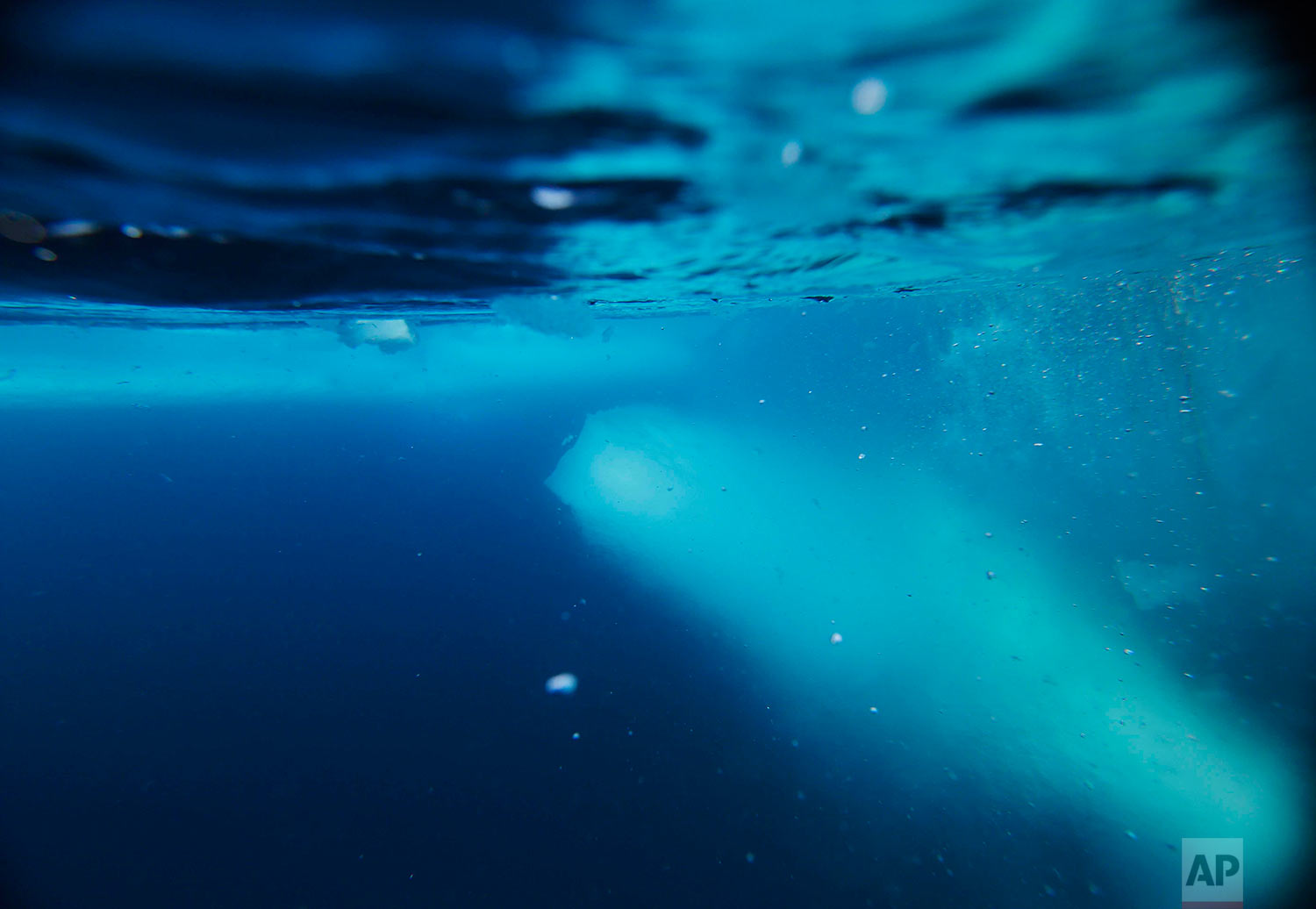
A block of sea ice is broken and pushed under water from the hull of the Finnish icebreaker MSV Nordica as it sails through Victoria Strait while traversing the Arctic's Northwest Passage, Friday, July 21, 2017. Sea ice forms when the top layer of water reaches freezing point, usually around the start of October. As temperatures continue to fall this first-year ice grows downward until it is several feet thick. If the ice survives the following summer melt it becomes second-year ice. Another cycle and it becomes multi-year ice, which is the toughest kind. (AP Photo/David Goldman)
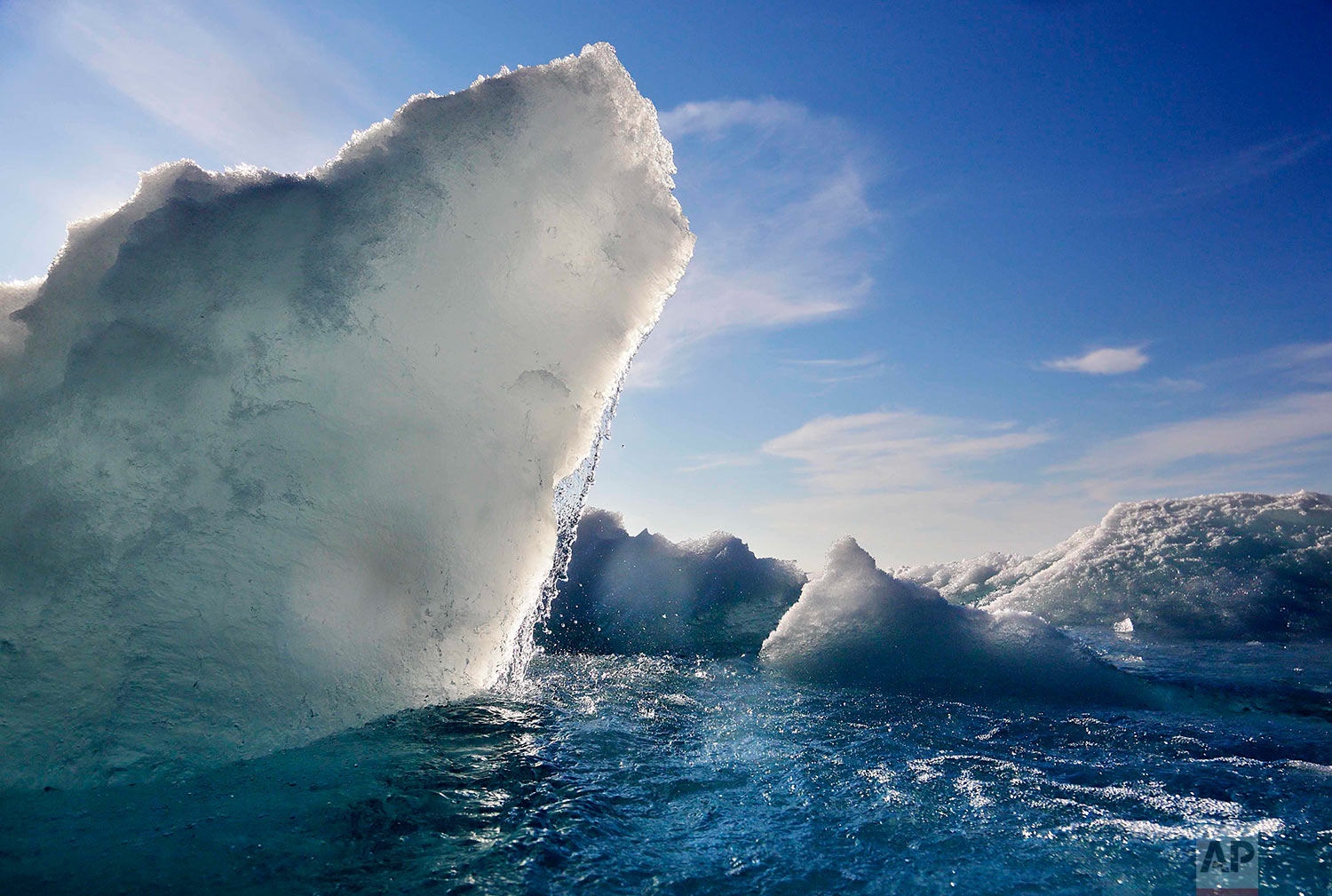
Broken sea ice emerges from under the hull of the Finnish icebreaker MSV Nordica as it sails through the Victoria Strait while traversing the Arctic's Northwest Passage, Friday, July 21, 2017. (AP Photo/David Goldman)
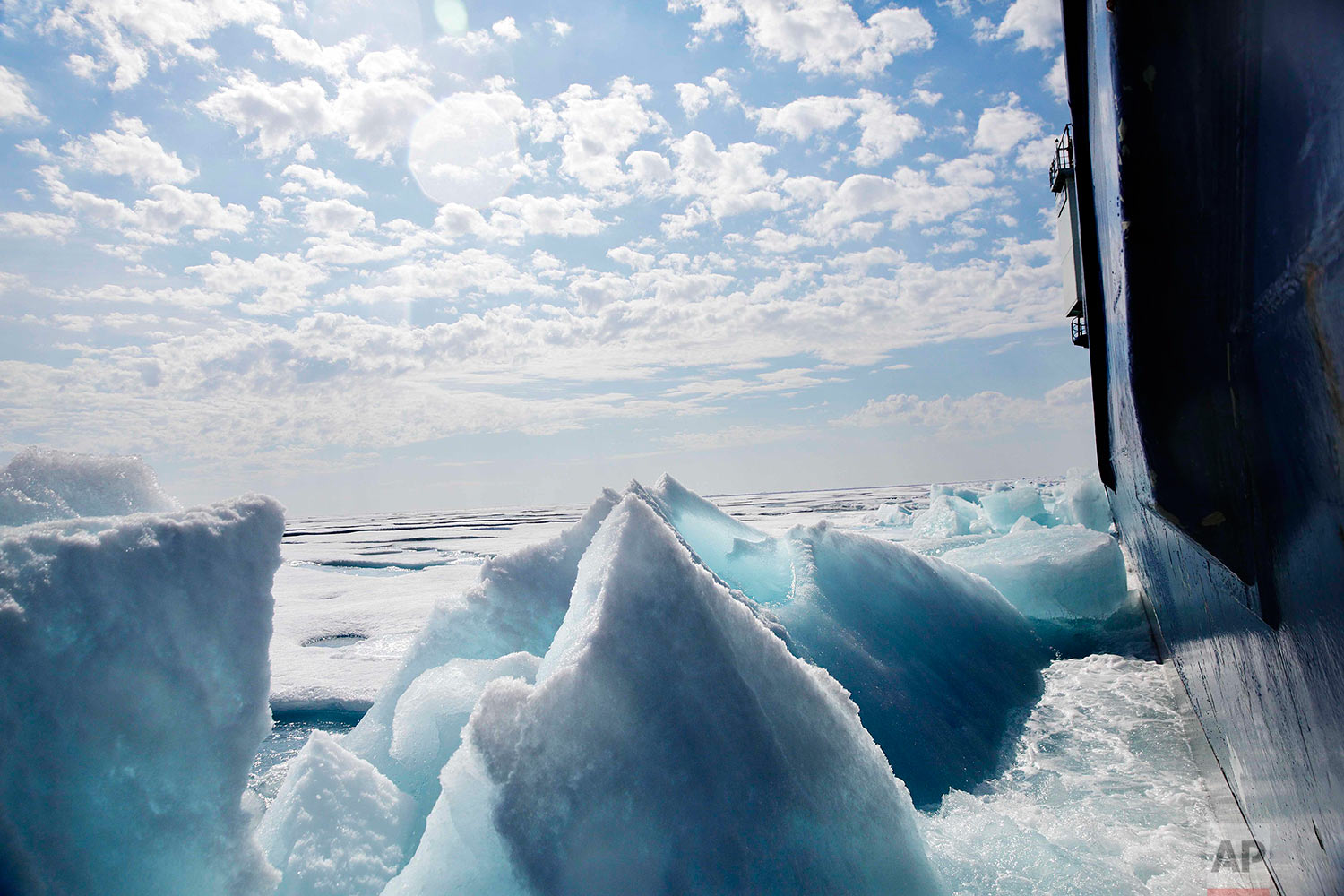
Broken sea ice emerges from under the hull of the Finnish icebreaker MSV Nordica as it sails through the Franklin Strait while traversing the Arctic's Northwest Passage, Saturday, July 22, 2017. Sea ice forms when the top layer of water reaches freezing point, usually around the start of October. As temperatures continue to fall this first-year ice grows downward until it is several feet thick. If the ice survives the following summer melt it becomes second-year ice. Another cycle and it becomes multi-year ice, which is the toughest kind. (AP Photo/David Goldman)
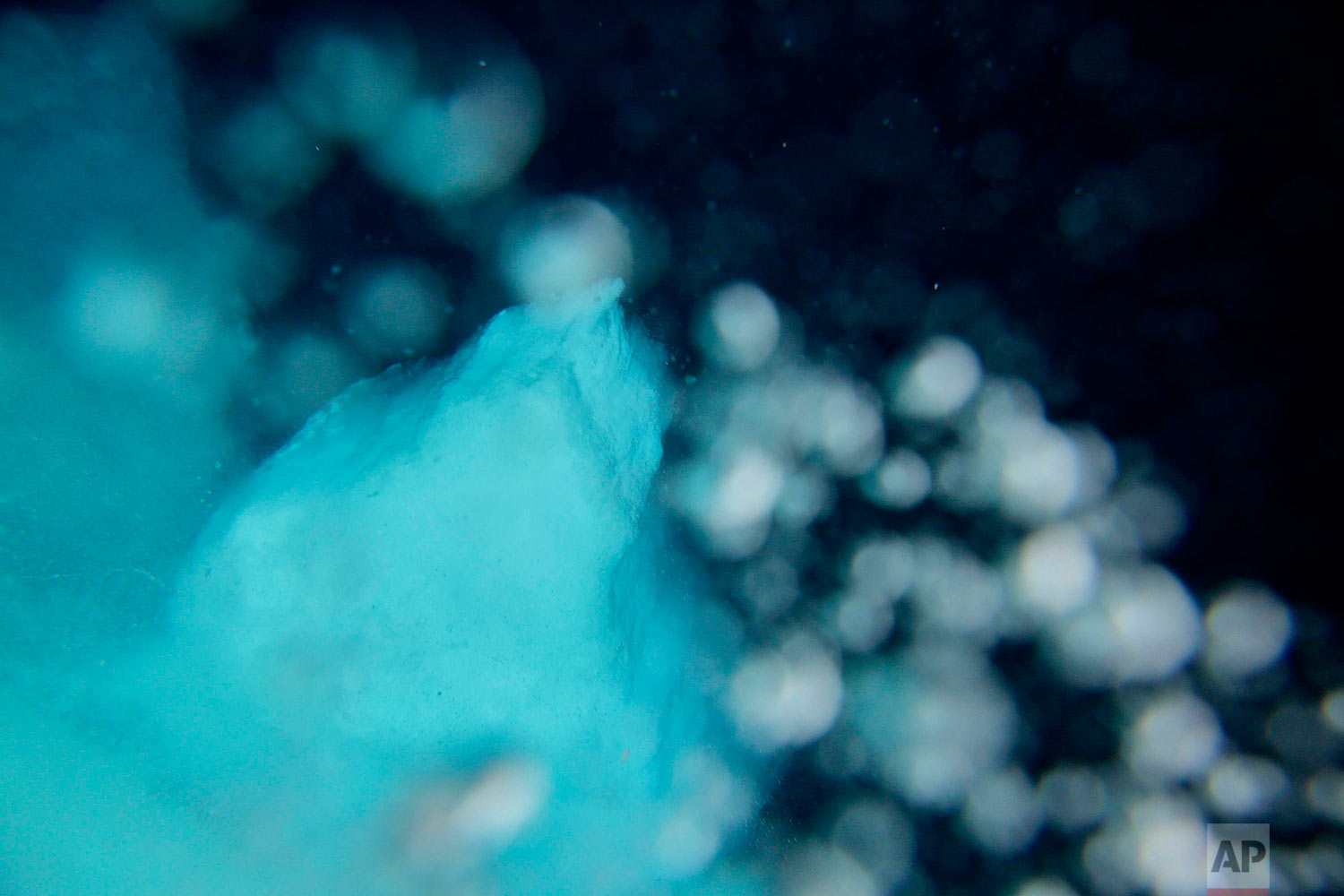
Broken sea ice emerges from under the hull of the Finnish icebreaker MSV Nordica as it sails through the Franklin Strait while traversing the Arctic's Northwest Passage, Saturday, July 22, 2017. (AP Photo/David Goldman)
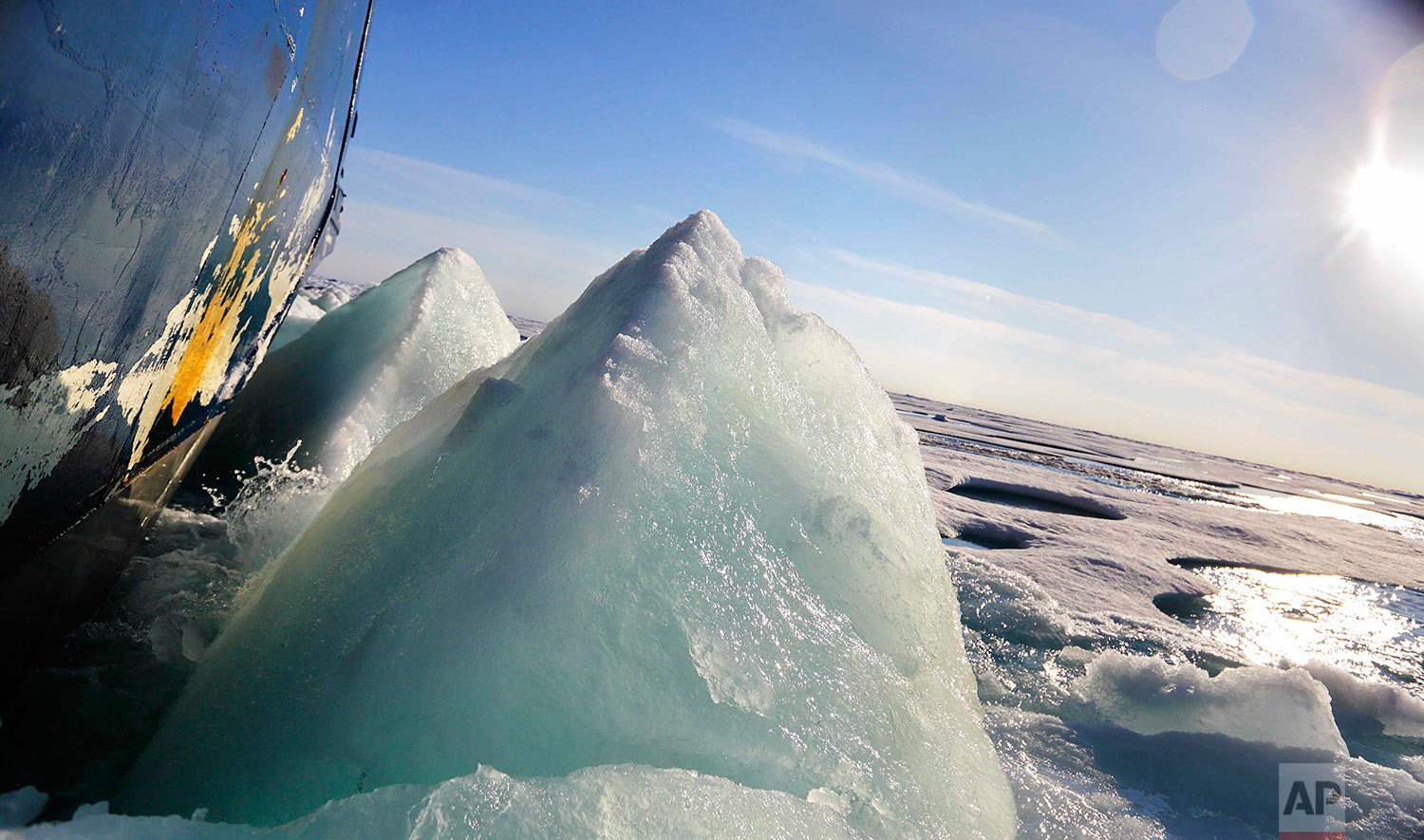
Broken sea ice emerges from under the hull of the Finnish icebreaker MSV Nordica as it sails through the Victoria Strait while traversing the Arctic's Northwest Passage, Friday, July 21, 2017. Sea ice forms when the top layer of water reaches freezing point, usually around the start of October. As temperatures continue to fall this first-year ice grows downward until it is several feet thick. If the ice survives the following summer melt it becomes second-year ice. Another cycle and it becomes multi-year ice, which is the toughest kind. (AP Photo/David Goldman)
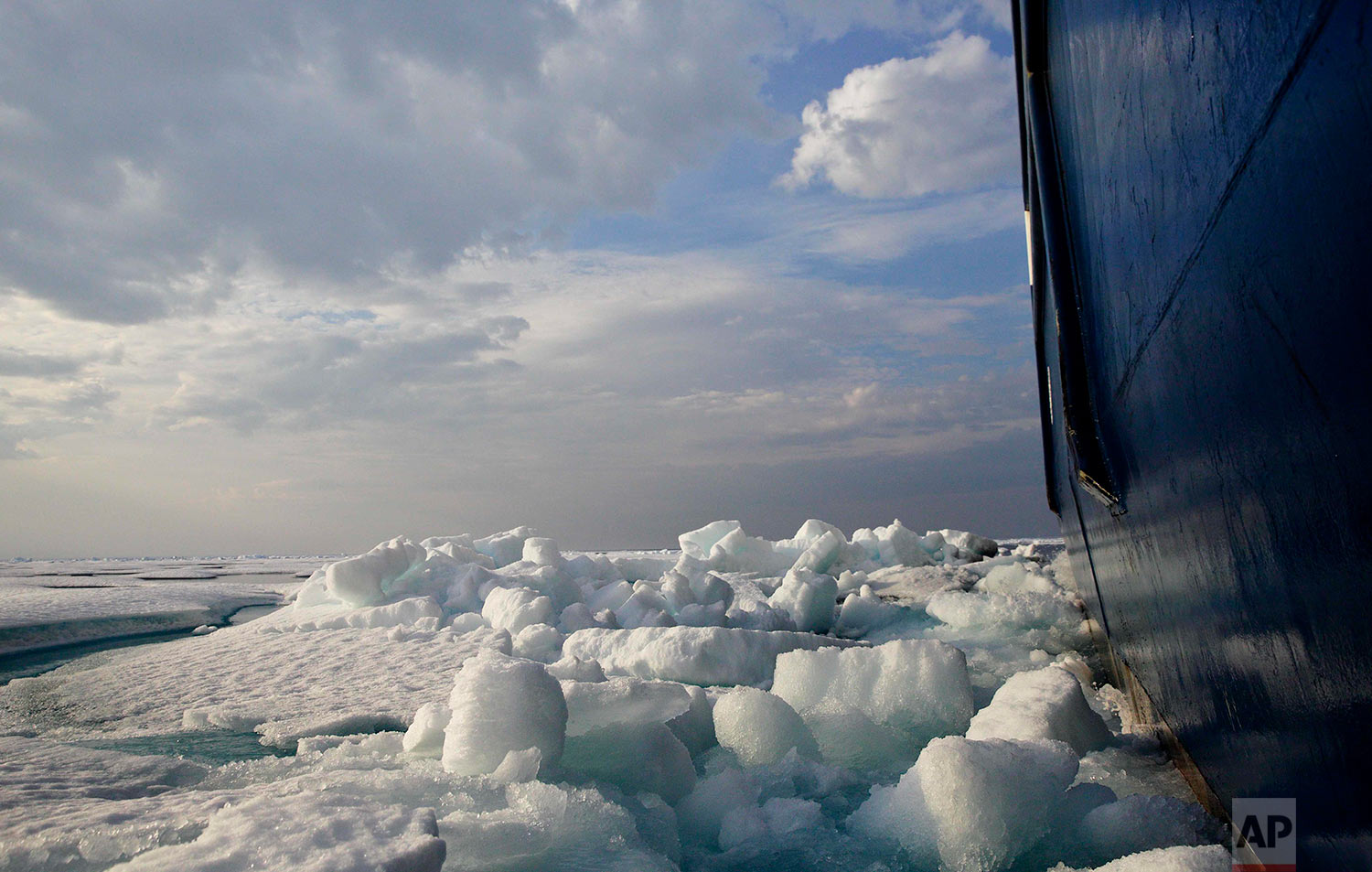
Broken sea ice is pushed aside as the Finnish icebreaker MSV Nordica sails through the Franklin Strait while traversing the Arctic's Northwest Passage, Saturday, July 22, 2017. Sea ice forms when the top layer of water reaches freezing point, usually around the start of October. As temperatures continue to fall this first-year ice grows downward until it is several feet thick. If the ice survives the following summer melt it becomes second-year ice. Another cycle and it becomes multi-year ice, which is the toughest kind. (AP Photo/David Goldman)
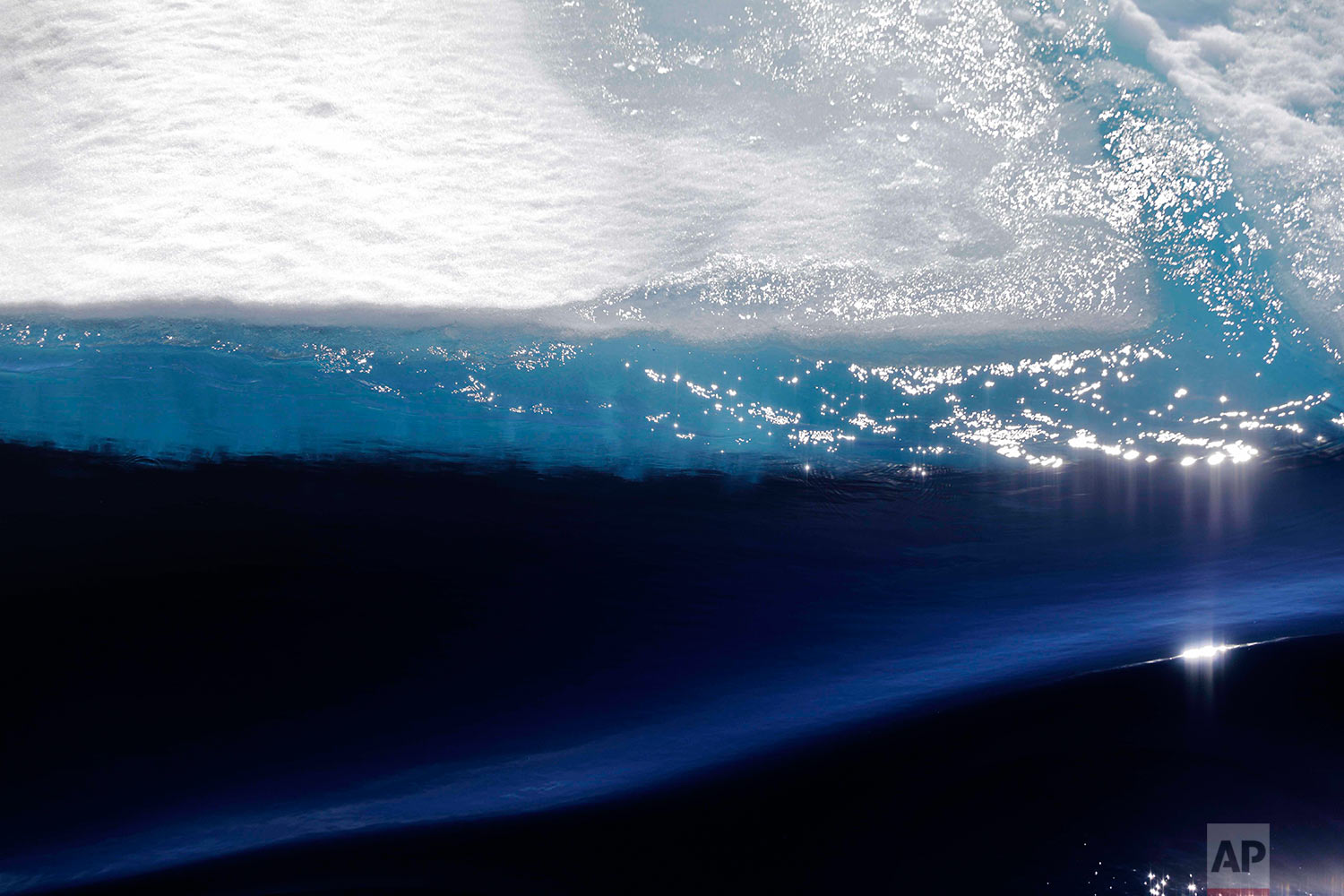
A block of sea ice floats in the wake of the Finnish icebreaker MSV Nordica as it sails through the Victoria Strait while traversing the Arctic's Northwest Passage, Friday, July 21, 2017. Sea ice forms when the top layer of water reaches freezing point, usually around the start of October. As temperatures continue to fall this first-year ice grows downward until it is several feet thick. If the ice survives the following summer melt it becomes second-year ice. Another cycle and it becomes multi-year ice, which is the toughest kind. (AP Photo/David Goldman)
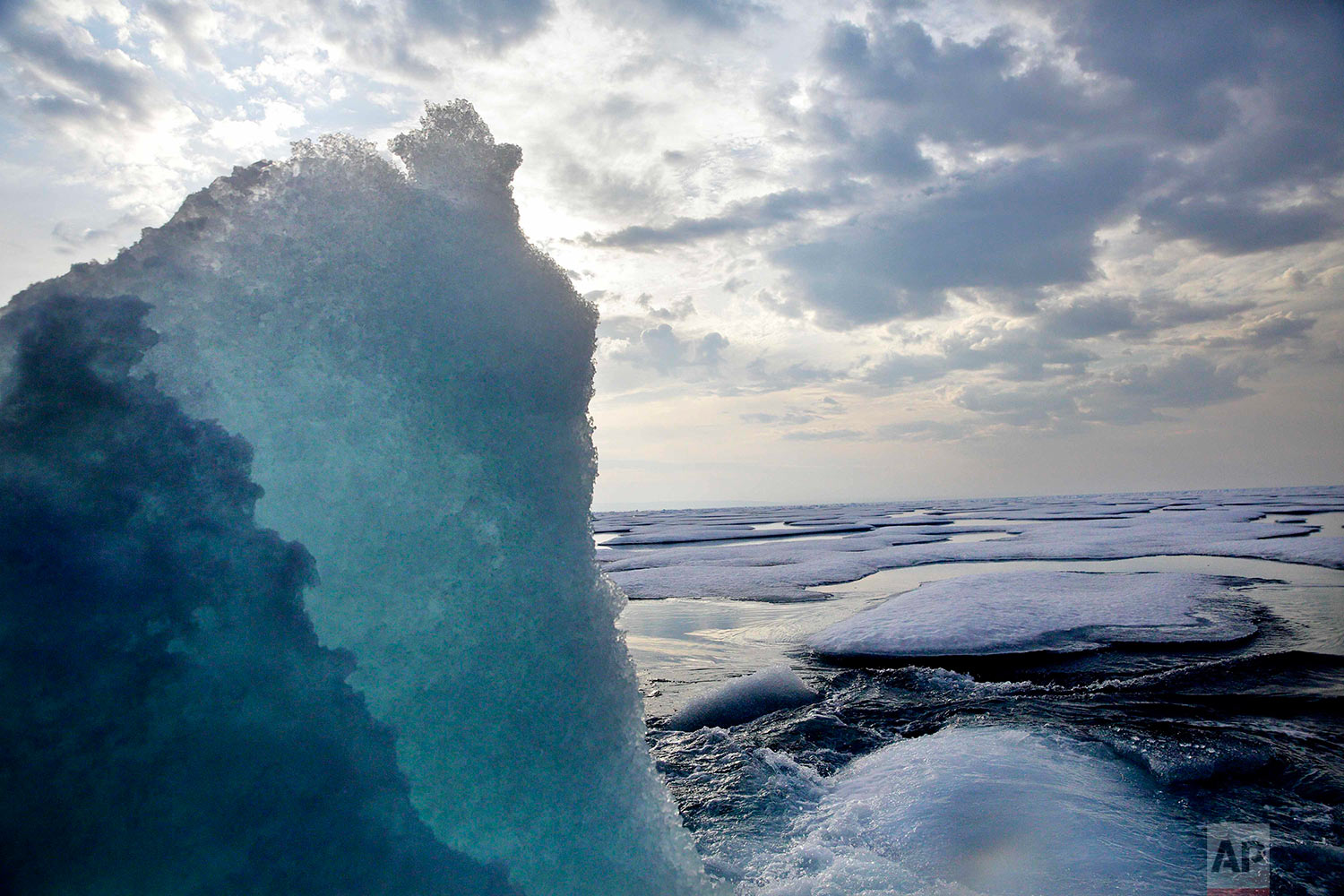
Broken sea ice emerges from under the hull of the Finnish icebreaker MSV Nordica as it sails through the Franklin Strait while traversing the Arctic's Northwest Passage, Saturday, July 22, 2017. Sea ice forms when the top layer of water reaches freezing point, usually around the start of October. As temperatures continue to fall this first-year ice grows downward until it is several feet thick. If the ice survives the following summer melt it becomes second-year ice. Another cycle and it becomes multi-year ice, which is the toughest kind. (AP Photo/David Goldman)
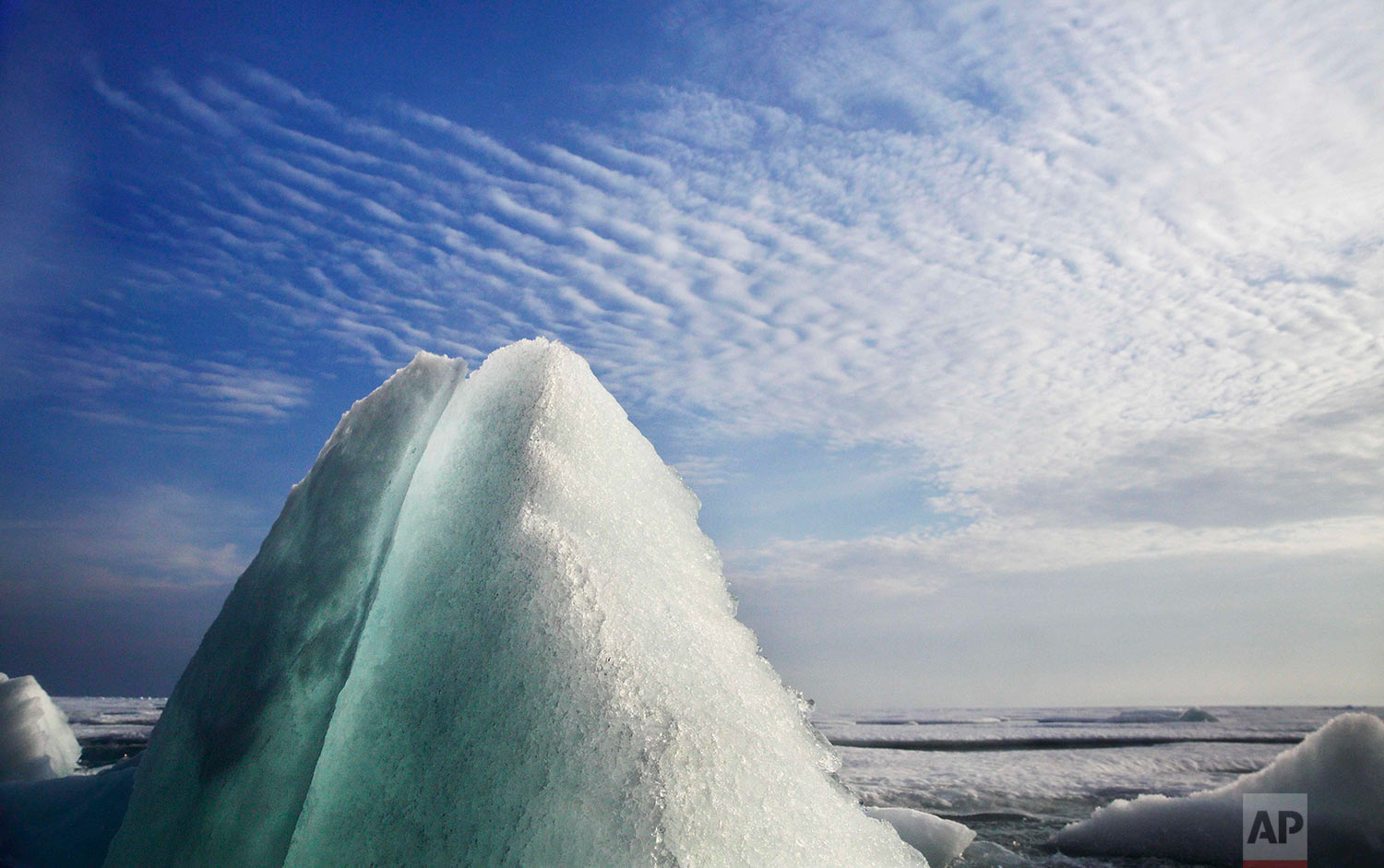
Broken sea ice emerges from under the hull of the Finnish icebreaker MSV Nordica as it sails through the Franklin Strait while traversing the Arctic's Northwest Passage, Saturday, July 22, 2017. Sea ice forms when the top layer of water reaches freezing point, usually around the start of October. As temperatures continue to fall this first-year ice grows downward until it is several feet thick. If the ice survives the following summer melt it becomes second-year ice. Another cycle and it becomes multi-year ice, which is the toughest kind. (AP Photo/David Goldman)
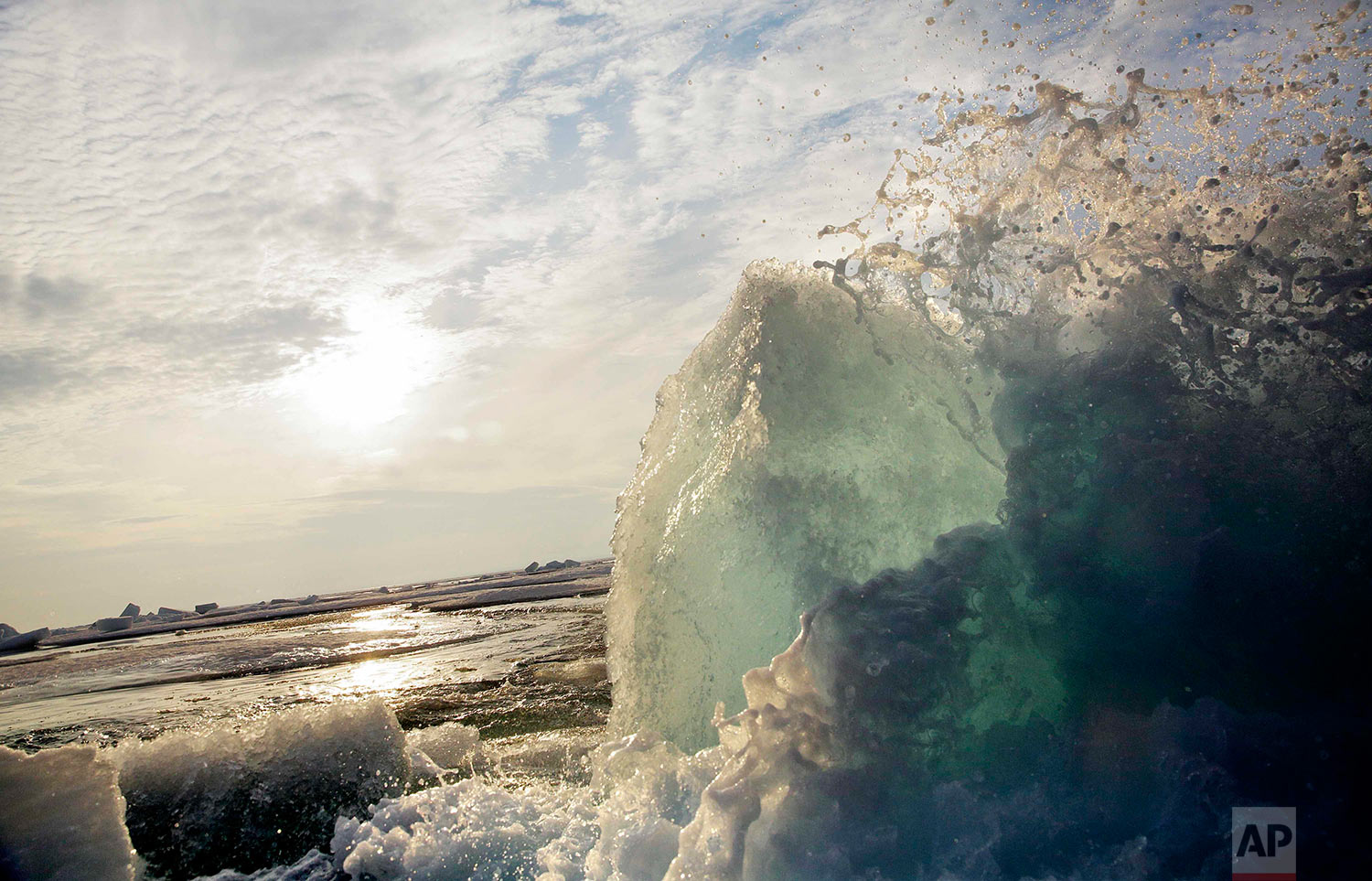
Broken sea ice emerges from under the hull of the Finnish icebreaker MSV Nordica as it sails through the Franklin Strait while traversing the Arctic's Northwest Passage, Saturday, July 22, 2017. Sea ice forms when the top layer of water reaches freezing point, usually around the start of October. As temperatures continue to fall this first-year ice grows downward until it is several feet thick. If the ice survives the following summer melt it becomes second-year ice. Another cycle and it becomes multi-year ice, which is the toughest kind. (AP Photo/David Goldman)

Broken sea ice emerges from under the hull of the Finnish icebreaker MSV Nordica as it sails through the Victoria Strait while traversing the Arctic's Northwest Passage, Friday, July 21, 2017. Sea ice forms when the top layer of water reaches freezing point, usually around the start of October. As temperatures continue to fall this first-year ice grows downward until it is several feet thick. If the ice survives the following summer melt it becomes second-year ice. Another cycle and it becomes multi-year ice, which is the toughest kind. (AP Photo/David Goldman)
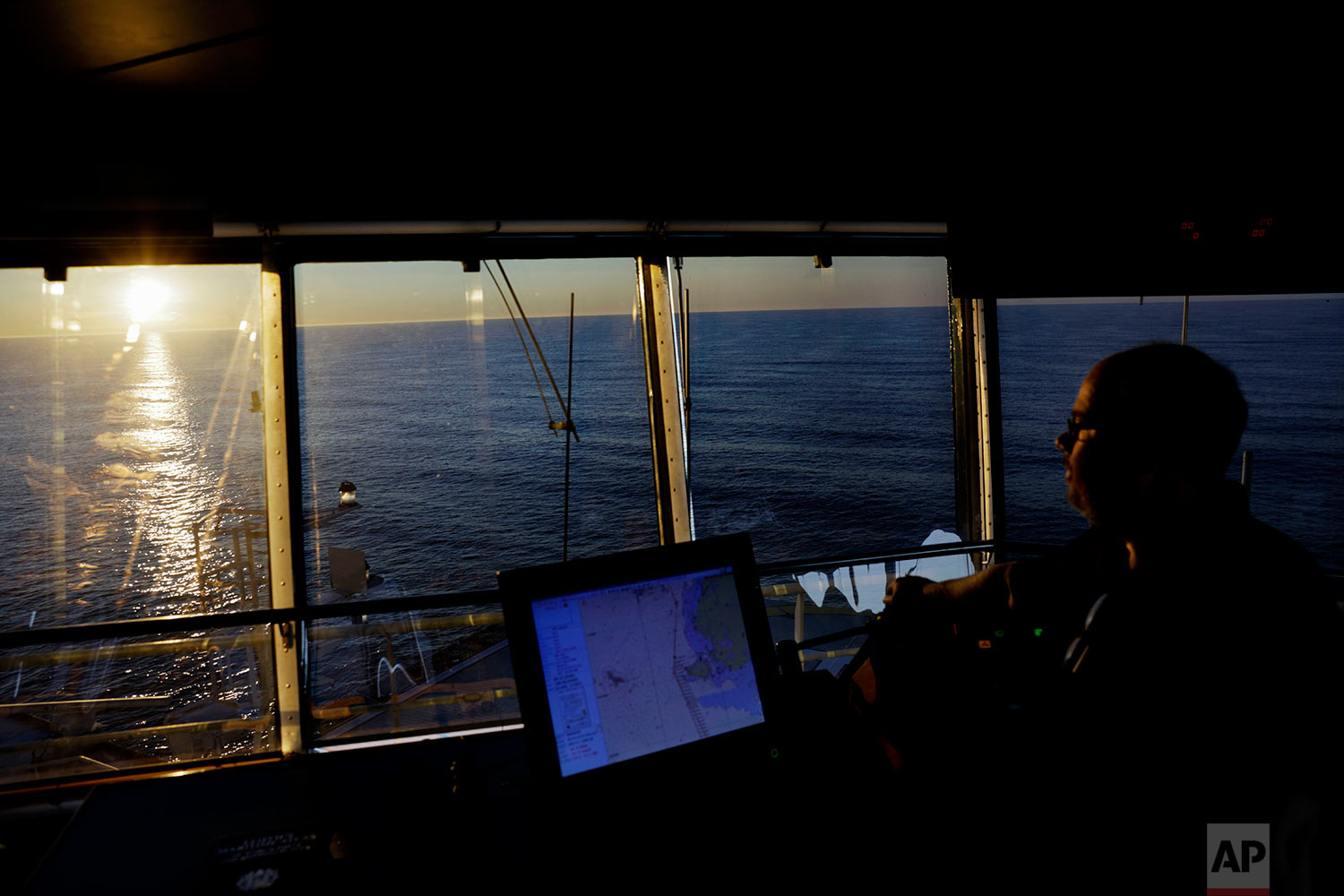
FILE - In this July 13, 2017 file photo, the sun lingers above the Bering Sea at midnight as second officer Juha Tuomi overseas the navigation of the Finnish icebreaker MSV Nordica as it sails toward the Canadian Arctic Archipelago to traverse the Northwest Passage. After 24 days at sea and a journey spanning more than 10,000 kilometers (6,214 miles), the Finnish icebreaker MSV Nordica has set a new record for the earliest transit of the fabled Northwest Passage. The once-forbidding route through the Arctic, linking the Pacific and the Atlantic oceans, has been opening up sooner and for a longer period each summer due to climate change. Sea ice that foiled famous explorers and blocked the passage to all but the hardiest ships has slowly been melting away in one of the most visible effects of man-made global warming. (AP Photo/David Goldman, File)

Personnel stand aboard the Finnish icebreaker MSV Nordica as it arrives into Nuuk, Greenland, after traversing the Northwest Passage through the Canadian Arctic Archipelago, Saturday, July 29, 2017. After 24 days at sea and a journey spanning more than 10,000 kilometers (6,214 miles), the MSV Nordica has set a new record for the earliest transit of the fabled Northwest Passage. The once-forbidding route through the Arctic, linking the Pacific and the Atlantic oceans, has been opening up sooner and for a longer period each summer due to climate change. (AP Photo/David Goldman)
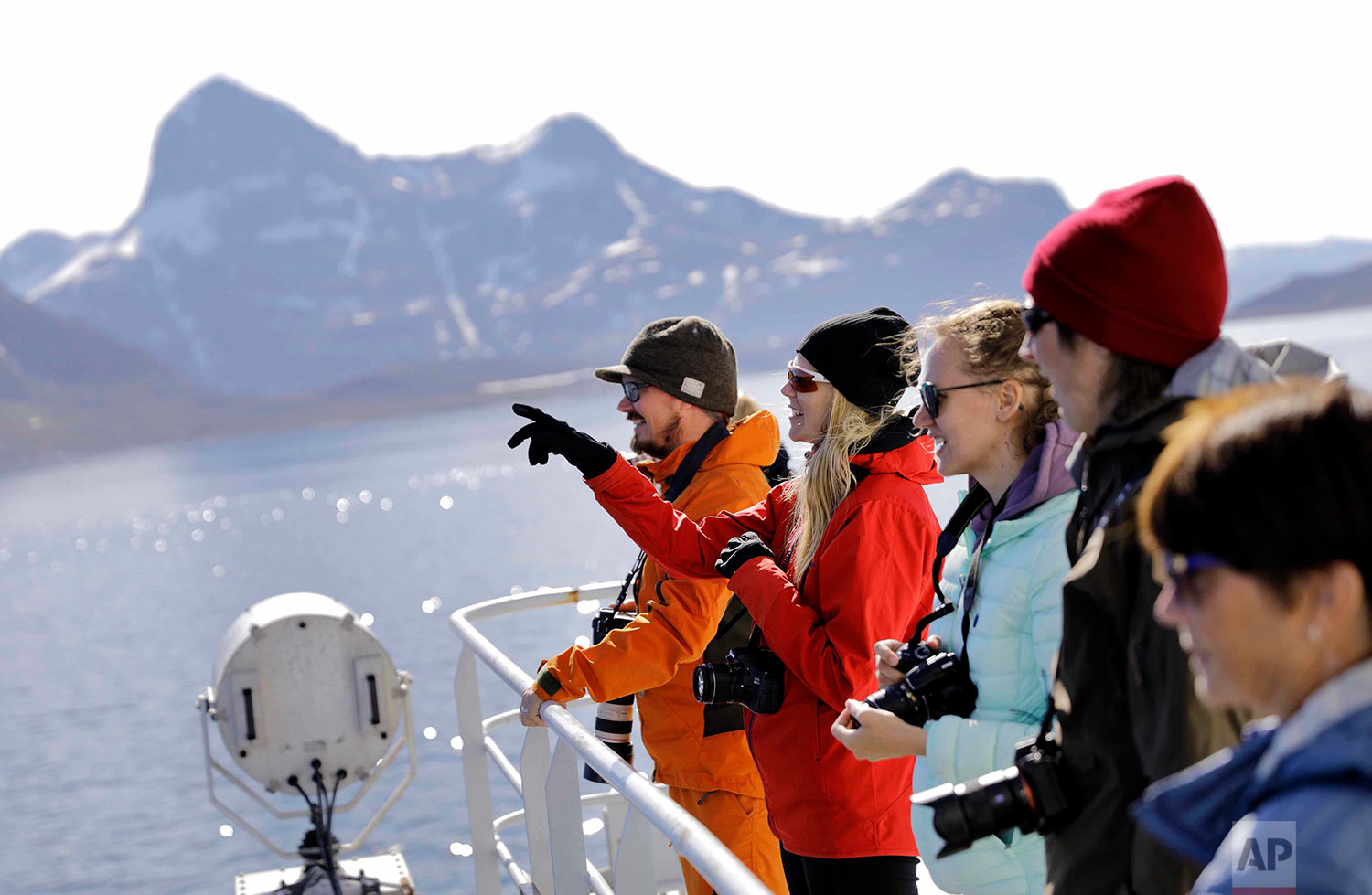
Tiina Jaaskelainen, second from left, and fellow researchers look out from the Finnish icebreaker MSV Nordica as it arrives into Nuuk, Greenland, after traversing the Northwest Passage through the Canadian Arctic Archipelago, Saturday, July 29, 2017. After 24 days at sea and a journey spanning more than 10,000 kilometers (6,214 miles), the MSV Nordica has set a new record for the earliest transit of the fabled Northwest Passage. The once-forbidding route through the Arctic, linking the Pacific and the Atlantic oceans, has been opening up sooner and for a longer period each summer due to climate change. (AP Photo/David Goldman)

The flag of Finland flies aboard the Finnish icebreaker MSV Nordica as it arrives into Nuuk, Greenland, after traversing the Northwest Passage through the Canadian Arctic Archipelago, Saturday, July 29, 2017. After 24 days at sea and a journey spanning more than 10,000 kilometers (6,214 miles), the MSV Nordica has set a new record for the earliest transit of the fabled Northwest Passage. The once-forbidding route through the Arctic, linking the Pacific and the Atlantic oceans, has been opening up sooner and for a longer period each summer due to climate change. (AP Photo/David Goldman)
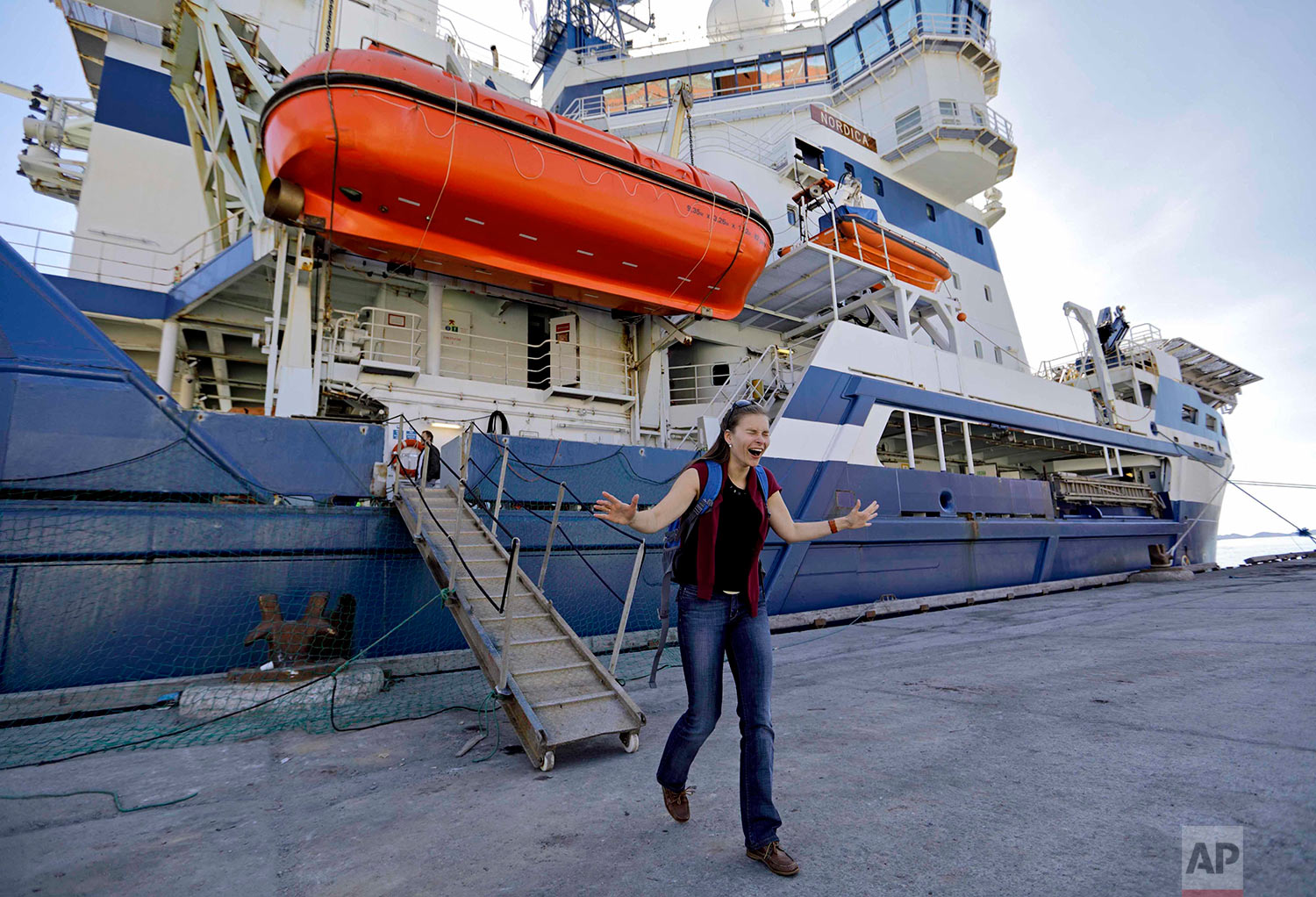
Researcher Daria Gritsenko steps onto land for the first time since setting sail aboard the Finnish icebreaker MSV Nordica as it arrives into Nuuk, Greenland, after traversing the Northwest Passage through the Canadian Arctic Archipelago, Saturday, July 29, 2017. After 24 days at sea and a journey spanning more than 10,000 kilometers (6,214 miles), the MSV Nordica has set a new record for the earliest transit of the fabled Northwest Passage. The once-forbidding route through the Arctic, linking the Pacific and the Atlantic oceans, has been opening up sooner and for a longer period each summer due to climate change. (AP Photo/David Goldman)
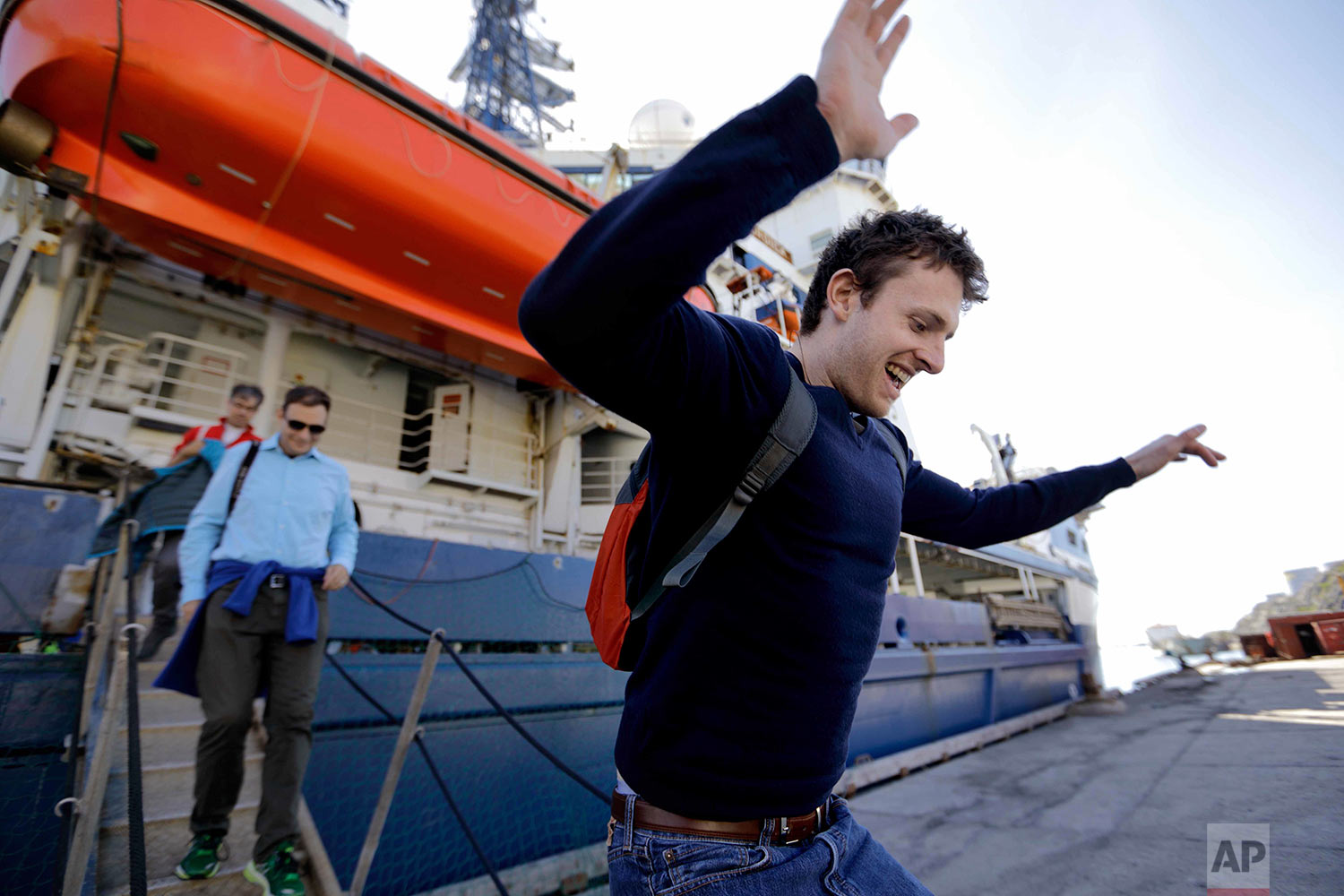
Researcher Scott Joblin jumps onto land for the first time since setting sail aboard the Finnish icebreaker MSV Nordica as it arrives into Nuuk, Greenland, after traversing the Northwest Passage through the Canadian Arctic Archipelago, Saturday, July 29, 2017. After 24 days at sea and a journey spanning more than 10,000 kilometers (6,214 miles), the MSV Nordica has set a new record for the earliest transit of the fabled Northwest Passage. The once-forbidding route through the Arctic, linking the Pacific and the Atlantic oceans, has been opening up sooner and for a longer period each summer due to climate change. (AP Photo/David Goldman)
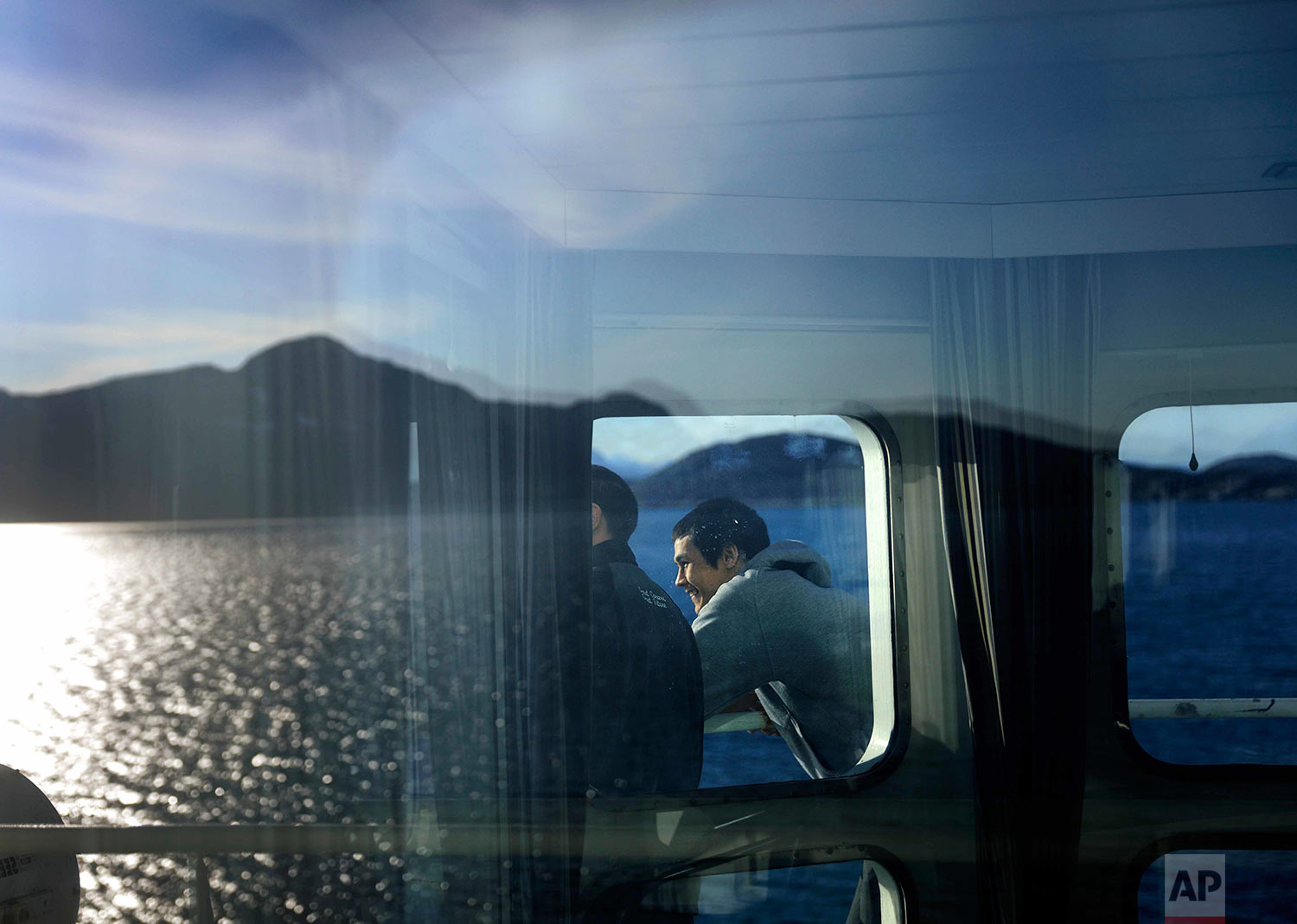
Trainee David Kullualik looks out as the Finnish icebreaker MSV Nordica arrives into Nuuk, Greenland, after traversing the Northwest Passage through the Canadian Arctic Archipelago, Saturday, July 29, 2017. After 24 days at sea and a journey spanning more than 10,000 kilometers (6,214 miles), the MSV Nordica has set a new record for the earliest transit of the fabled Northwest Passage. The once-forbidding route through the Arctic, linking the Pacific and the Atlantic oceans, has been opening up sooner and for a longer period each summer due to climate change. (AP Photo/David Goldman)
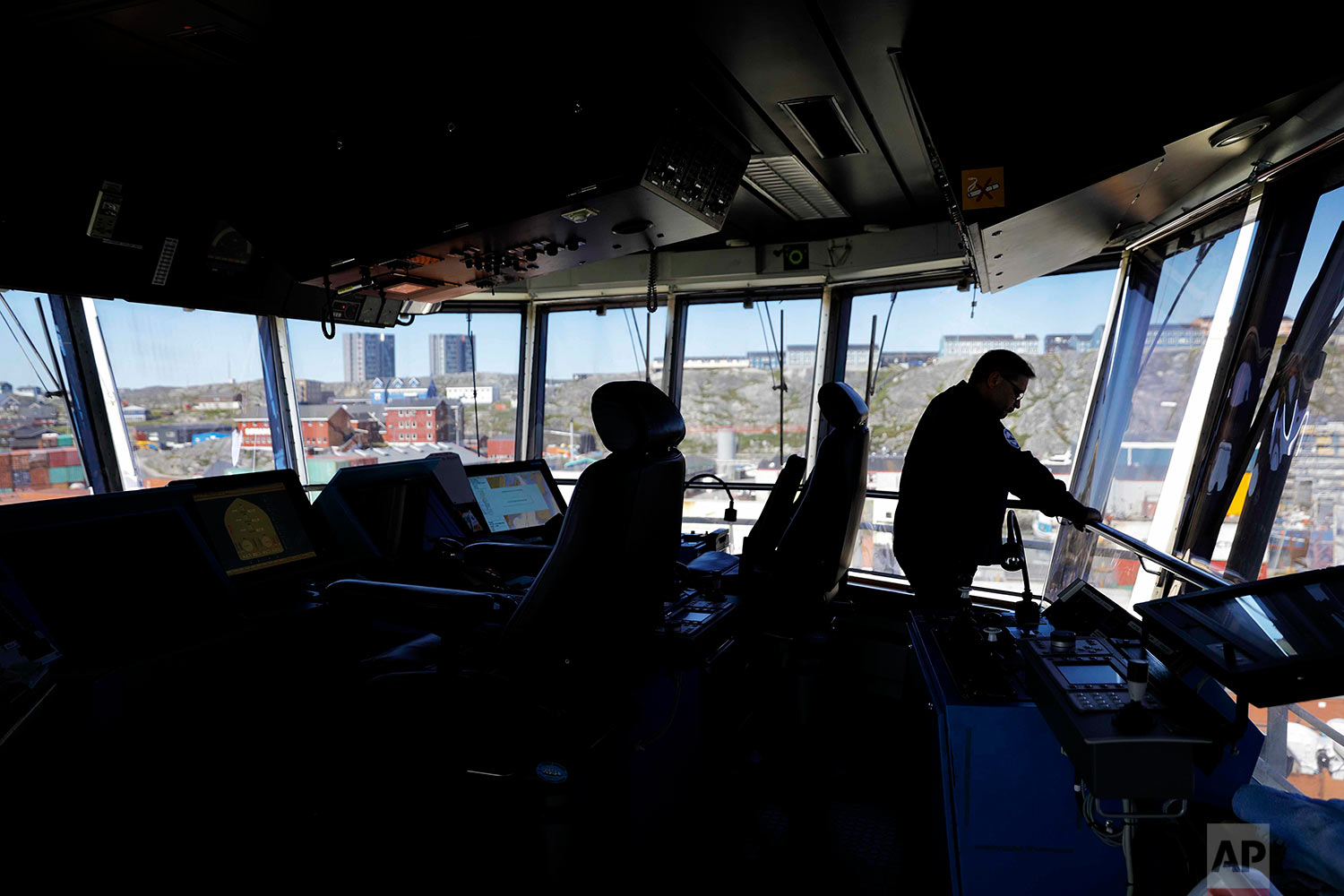
Master Mariner Jyri Viljanen, captain of the Finnish icebreaker MSV Nordica, looks out from the bridge after docking the ship in Nuuk, Greenland, as it arrives after traversing the Northwest Passage through the Canadian Arctic Archipelago, Saturday, July 29, 2017. After 24 days at sea and a journey spanning more than 10,000 kilometers (6,214 miles), the MSV Nordica has set a new record for the earliest transit of the fabled Northwest Passage. The once-forbidding route through the Arctic, linking the Pacific and the Atlantic oceans, has been opening up sooner and for a longer period each summer due to climate change. (AP Photo/David Goldman)
![]](https://images.squarespace-cdn.com/content/v1/57cf18ae6b8f5ba693497e1a/1501359993752-PV5KQGDTJWCIPDHMVVO1/AP_17210579453189.jpg)
The Finnish icebreaker MSV Nordica is docked in Nuuk, Greenland, after traversing the Northwest Passage through the Canadian Arctic Archipelago, Saturday, July 29, 2017. After 24 days at sea and a journey spanning more than 10,000 kilometers (6,214 miles), the MSV Nordica has set a new record for the earliest transit of the fabled Northwest Passage. The once-forbidding route through the Arctic, linking the Pacific and the Atlantic oceans, has been opening up sooner and for a longer period each summer due to climate change. (AP Photo/David Goldman)
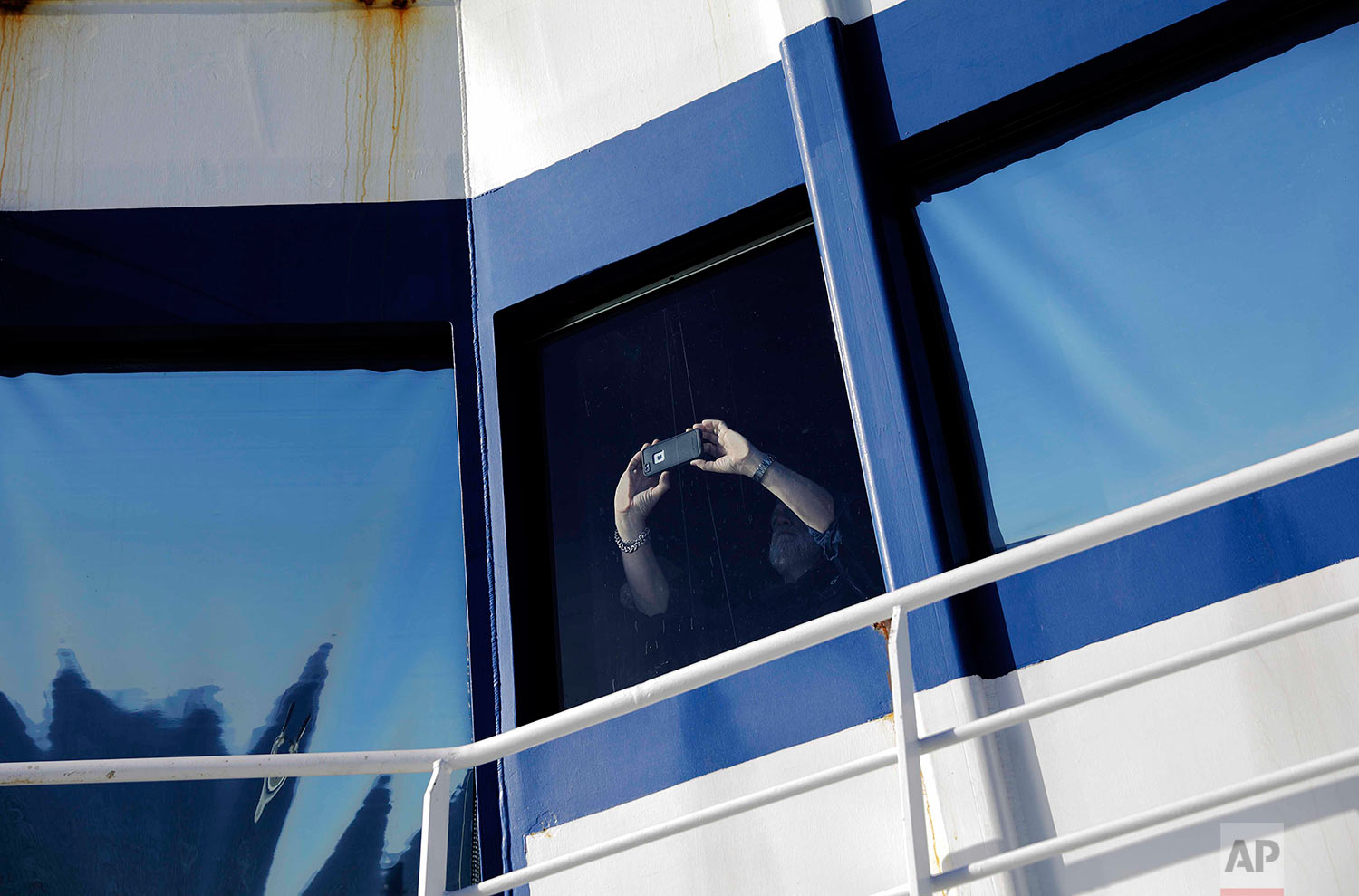
Canadian ice navigator, David "Duke" Snider takes a photo from the bridge as the Finnish icebreaker MSV Nordica arrives into Nuuk, Greenland, after traversing the Northwest Passage through the Canadian Arctic Archipelago, Saturday, July 29, 2017. After 24 days at sea and a journey spanning more than 10,000 kilometers (6,214 miles), the MSV Nordica has set a new record for the earliest transit of the fabled Northwest Passage. The once-forbidding route through the Arctic, linking the Pacific and the Atlantic oceans, has been opening up sooner and for a longer period each summer due to climate change. (AP Photo/David Goldman)





















































































![]](https://images.squarespace-cdn.com/content/v1/57cf18ae6b8f5ba693497e1a/1501359993752-PV5KQGDTJWCIPDHMVVO1/AP_17210579453189.jpg)

Video
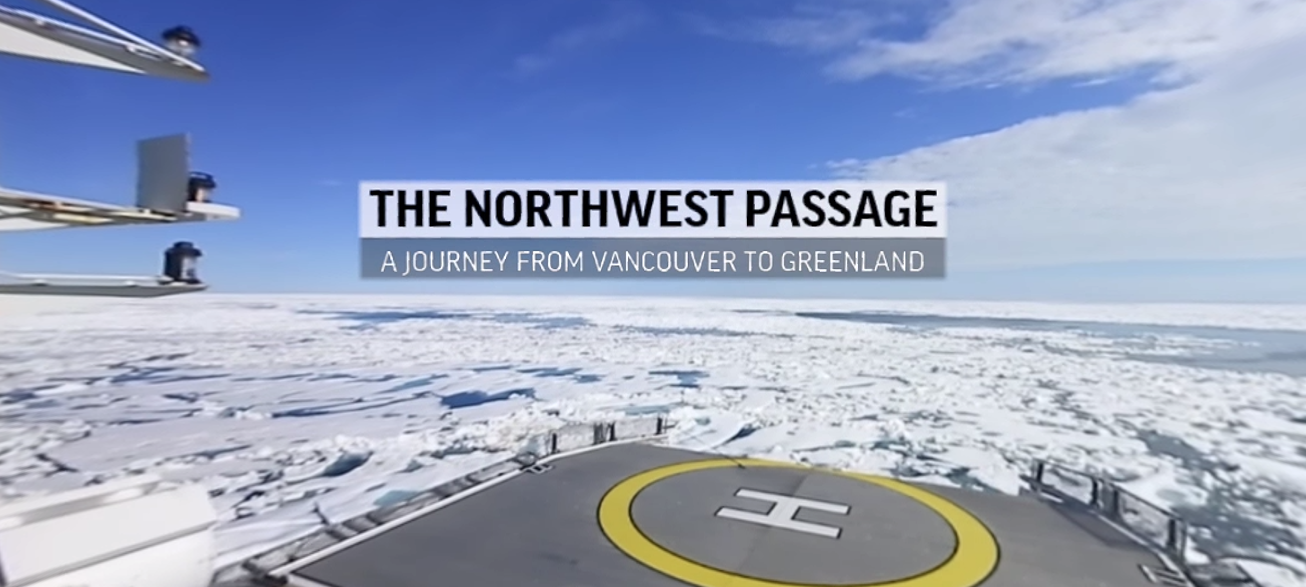
In July 2017, a team of AP journalists accompanied a group of international researchers aboard the Finnish icebreaker MSV Nordica.

Experts say Arctic sea ice is disappearing earlier in summer and returning later in the fall. An AP animation shows how sea ice coverage has dropped an average of 34,000 square miles per year. (Aug. 14)
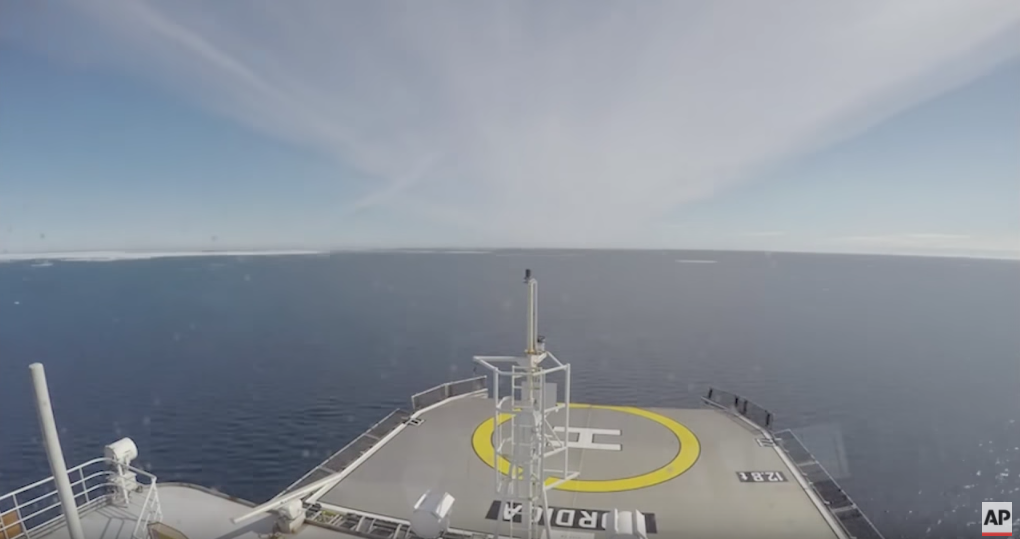



The Journey
Map shows MSV Nordica's transit through the Northwest Passage. It was updated live through the trip, using satellite tracking data.
After the voyage
Photos David Goldman | Text Frank Jordans
The email arrived in mid-June, seeking to explode any notion that global warming might turn our Arctic expedition into a summer cruise.
Photos David Goldman | Text Seth Borenstein
One of the coldest places on Earth is so hot it’s melting.
Photos by David Goldman
The Greenland ice sheet, the second largest body of ice in the world which covers roughly 80 percent of the country, has been melting and its glaciers retreating at an accelerated pace in recent years due to warmer temperatures.
Meet the team
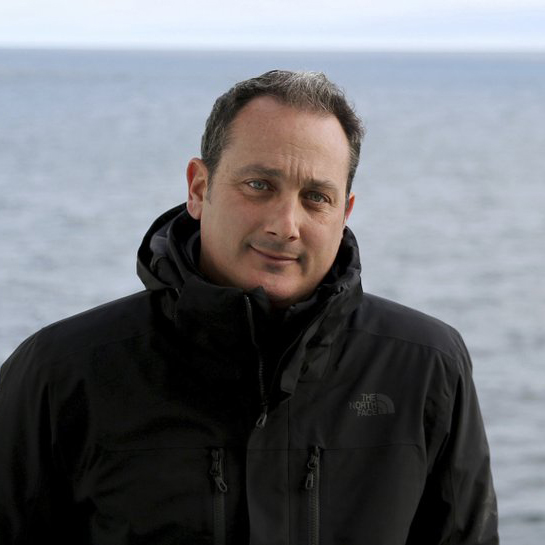
David Goldman, Photographer
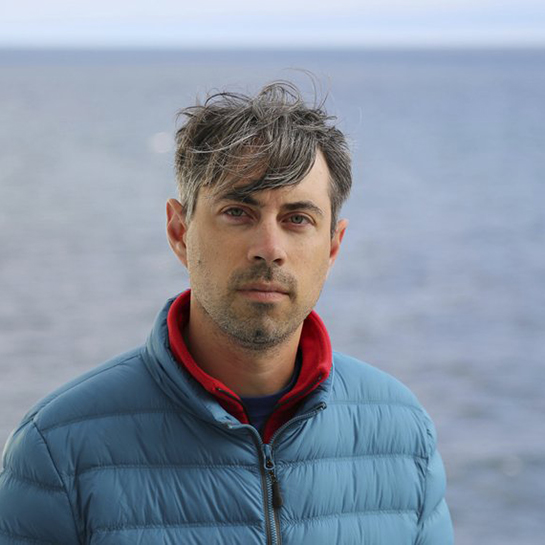
Frank Jordans, Environment Reporter

David Keyton, Video Journalist
David Goldman, a photographer based in Atlanta, Georgia, has worked for the AP since 2010. He has covered events in his career ranging from presidential campaigns to Olympic Games, from stories in Afghanistan to small counties in rural America. He most recently has been working on a project exploring the issues dividing America this past election.
Frank Jordans joined the AP as an editor in London in 2005 before moving to Geneva to cover Switzerland and the United Nations for six years. In 2012, he transferred to Berlin, where he reports on news from Germany and science across Europe, with a particular focus on climate change. He is a member of the AP Global Environment Team.
David Keyton is a video journalist based in Stockholm, Sweden and has been with the AP since 2015. While leading the Nordic & Baltic regions, he also serves on the AP’s Global Environment Team, focusing on climate change. Keyton has reported regularly from the Arctic.

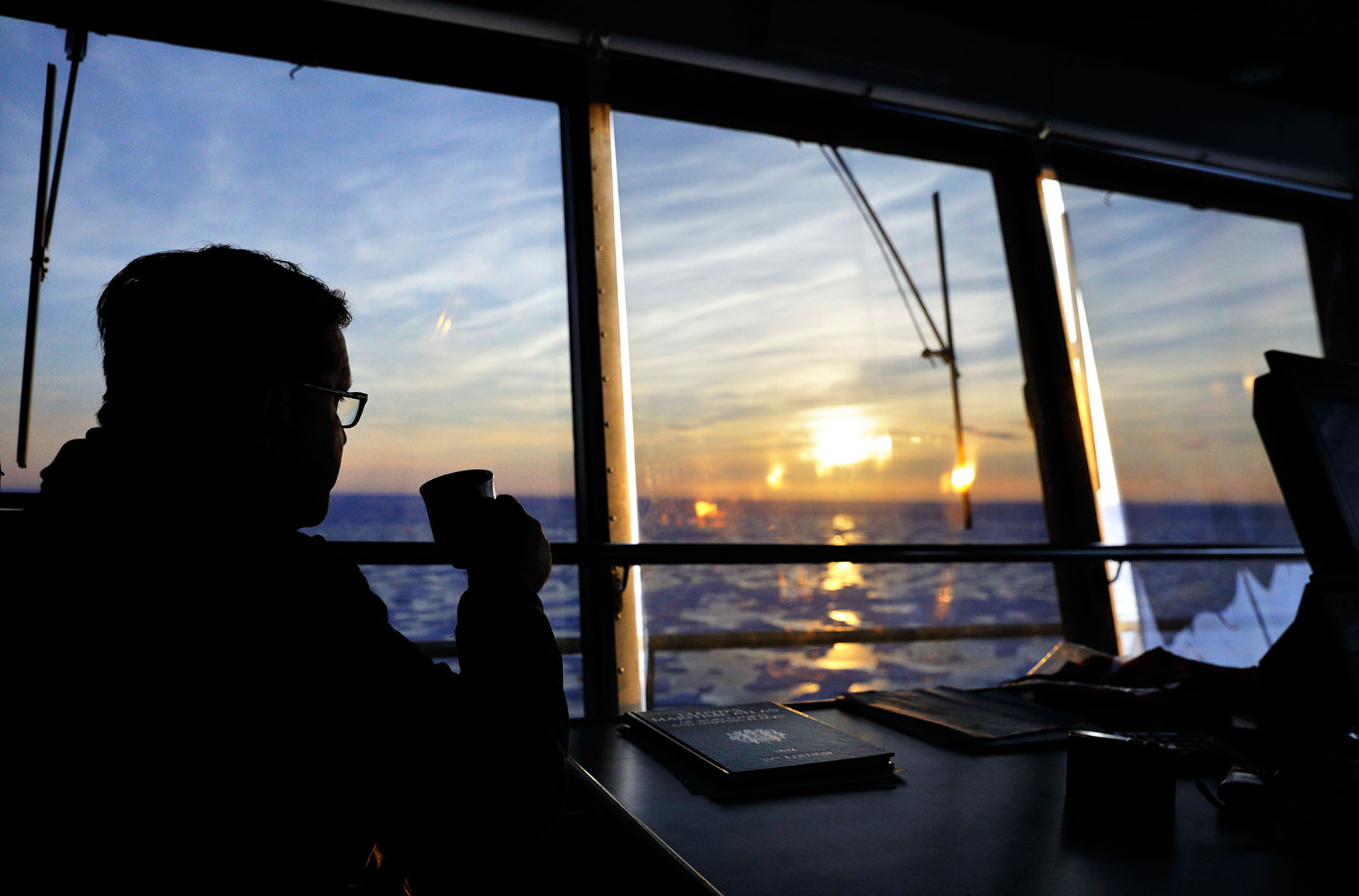

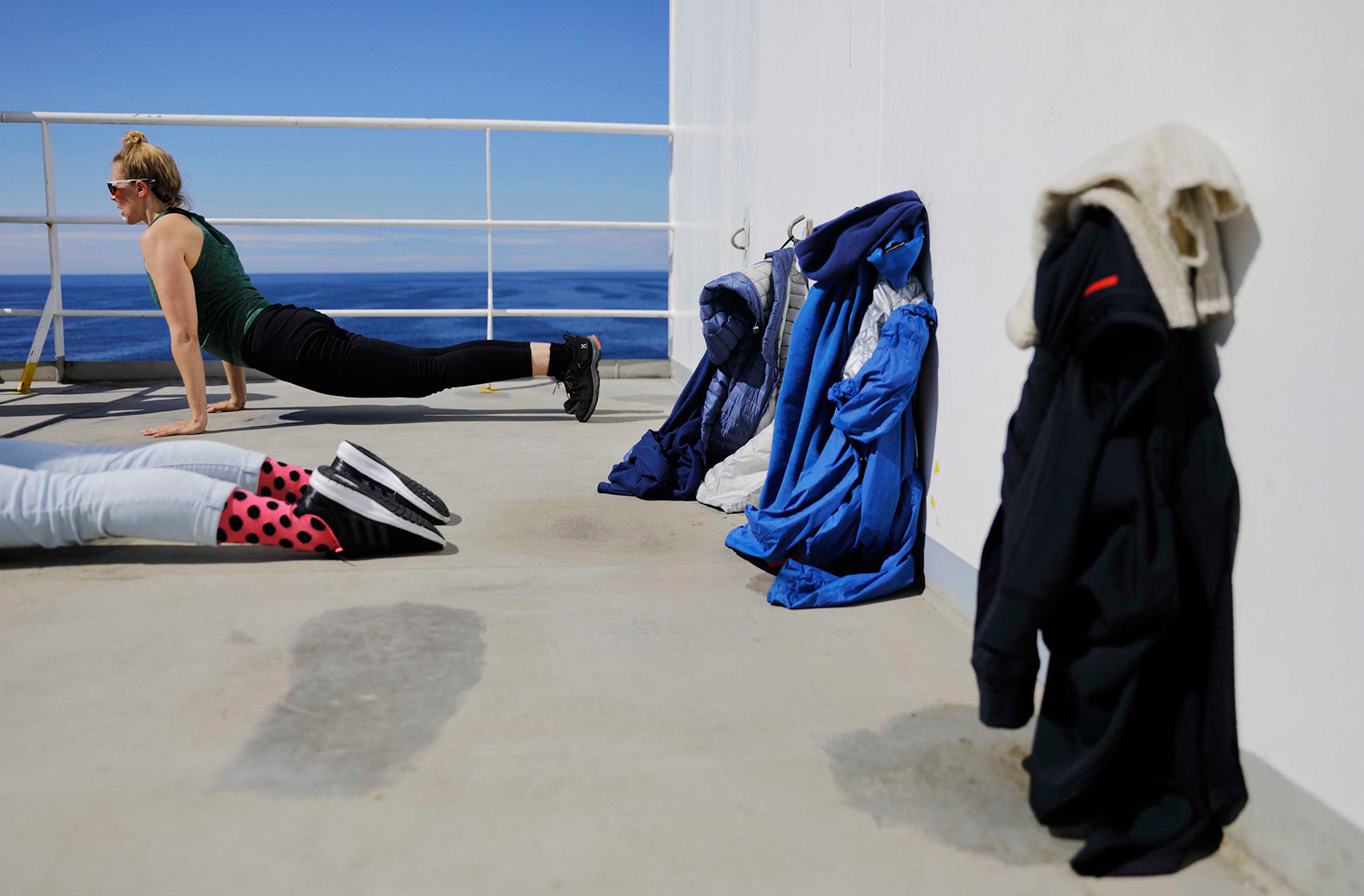
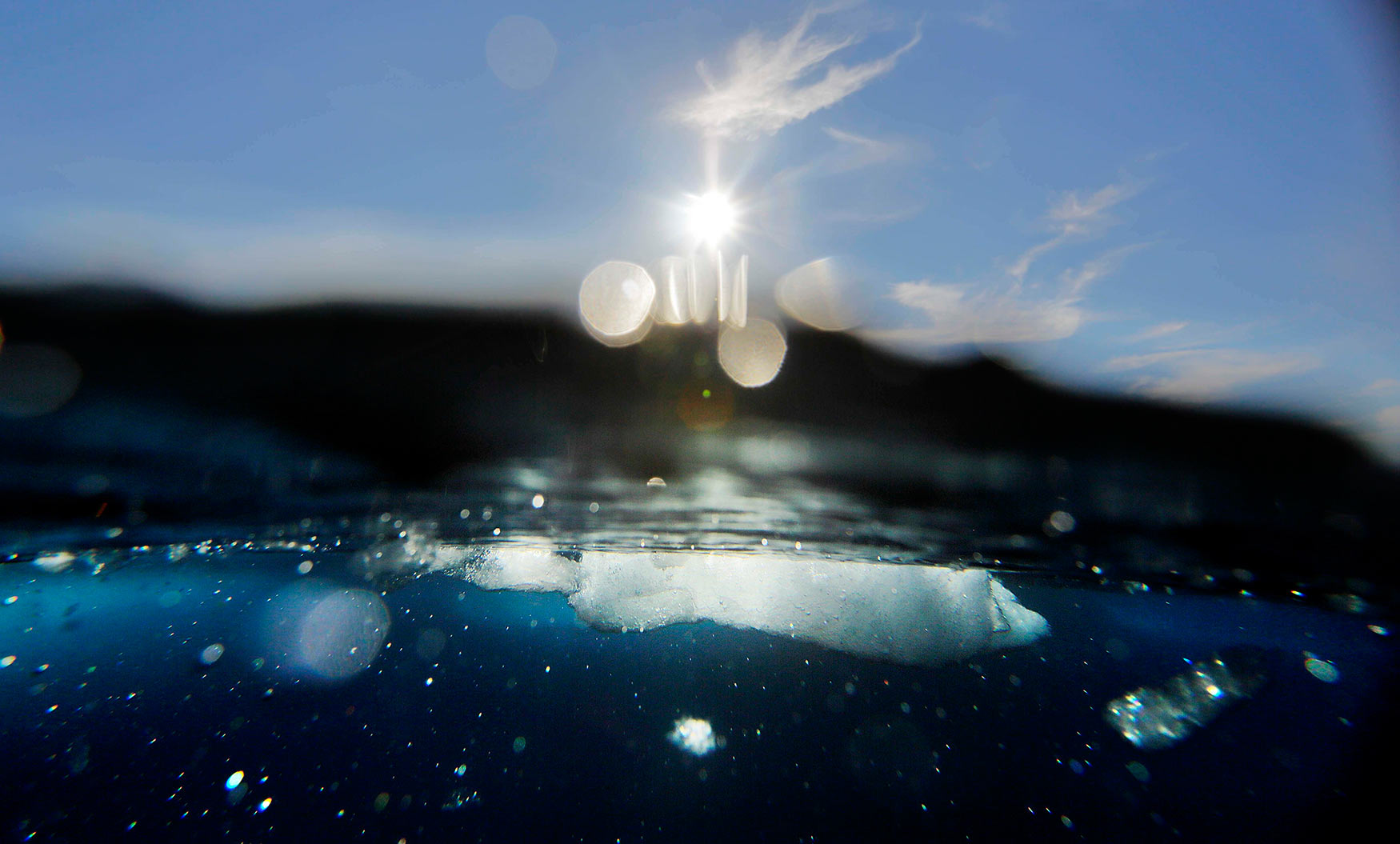
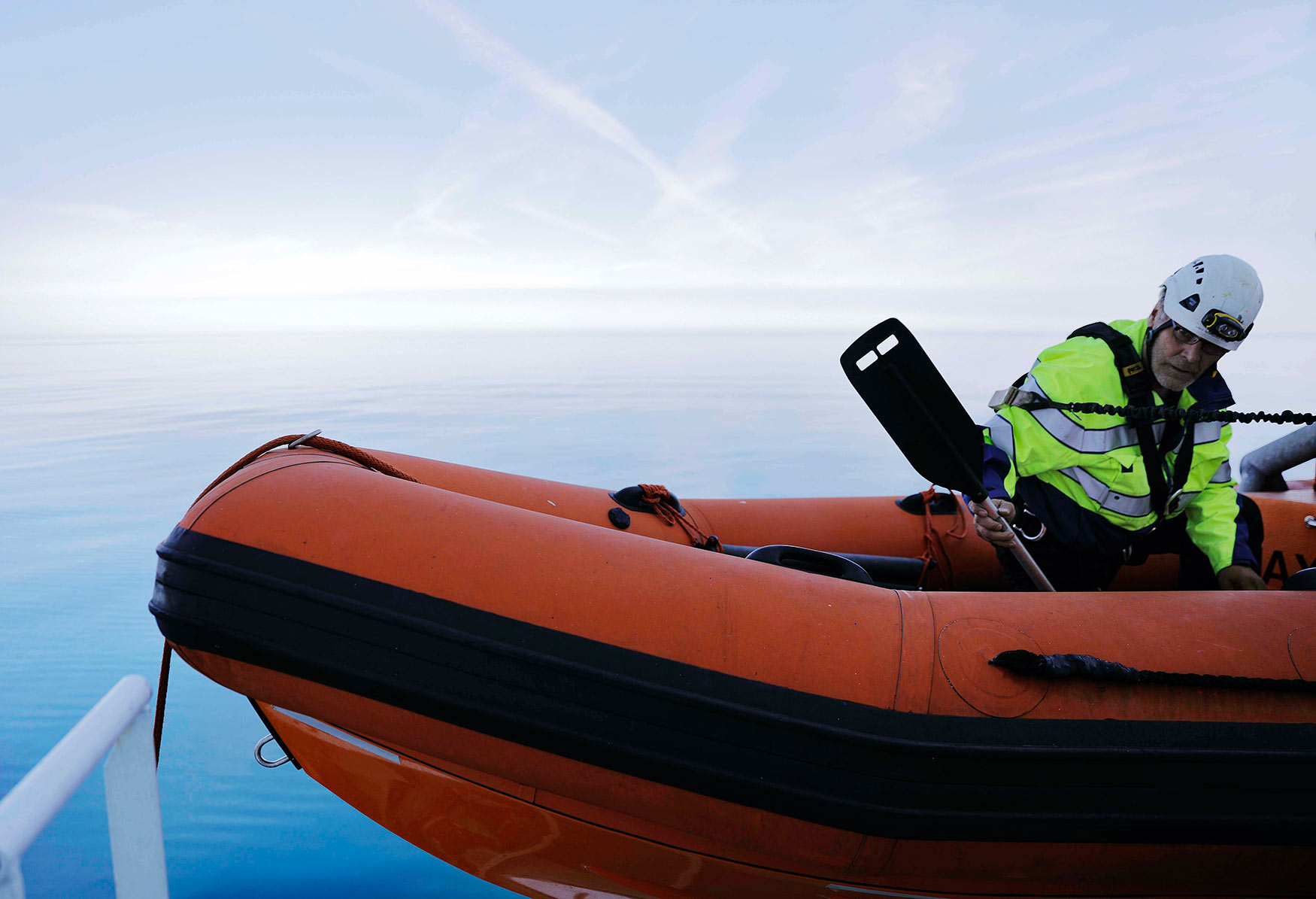
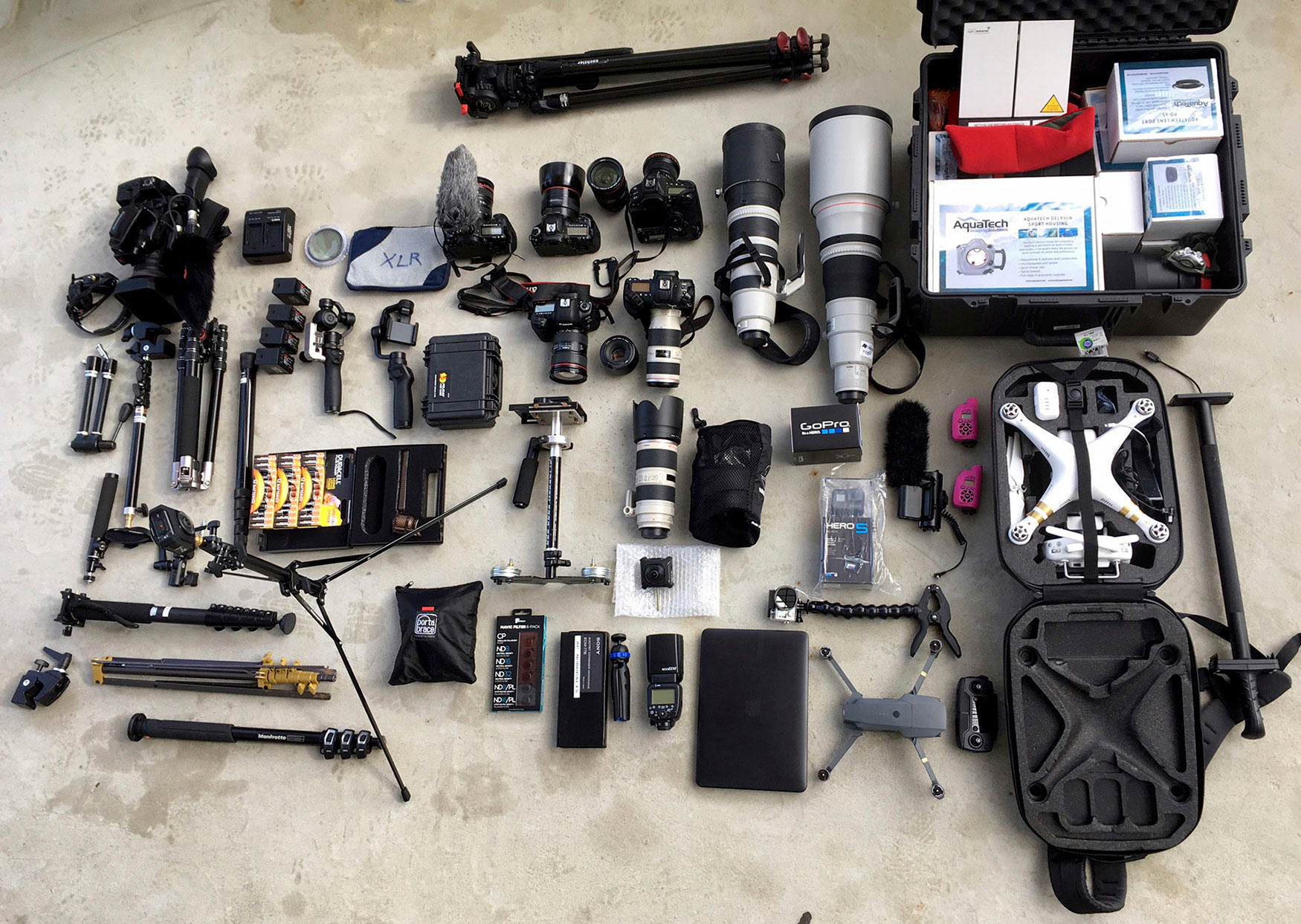
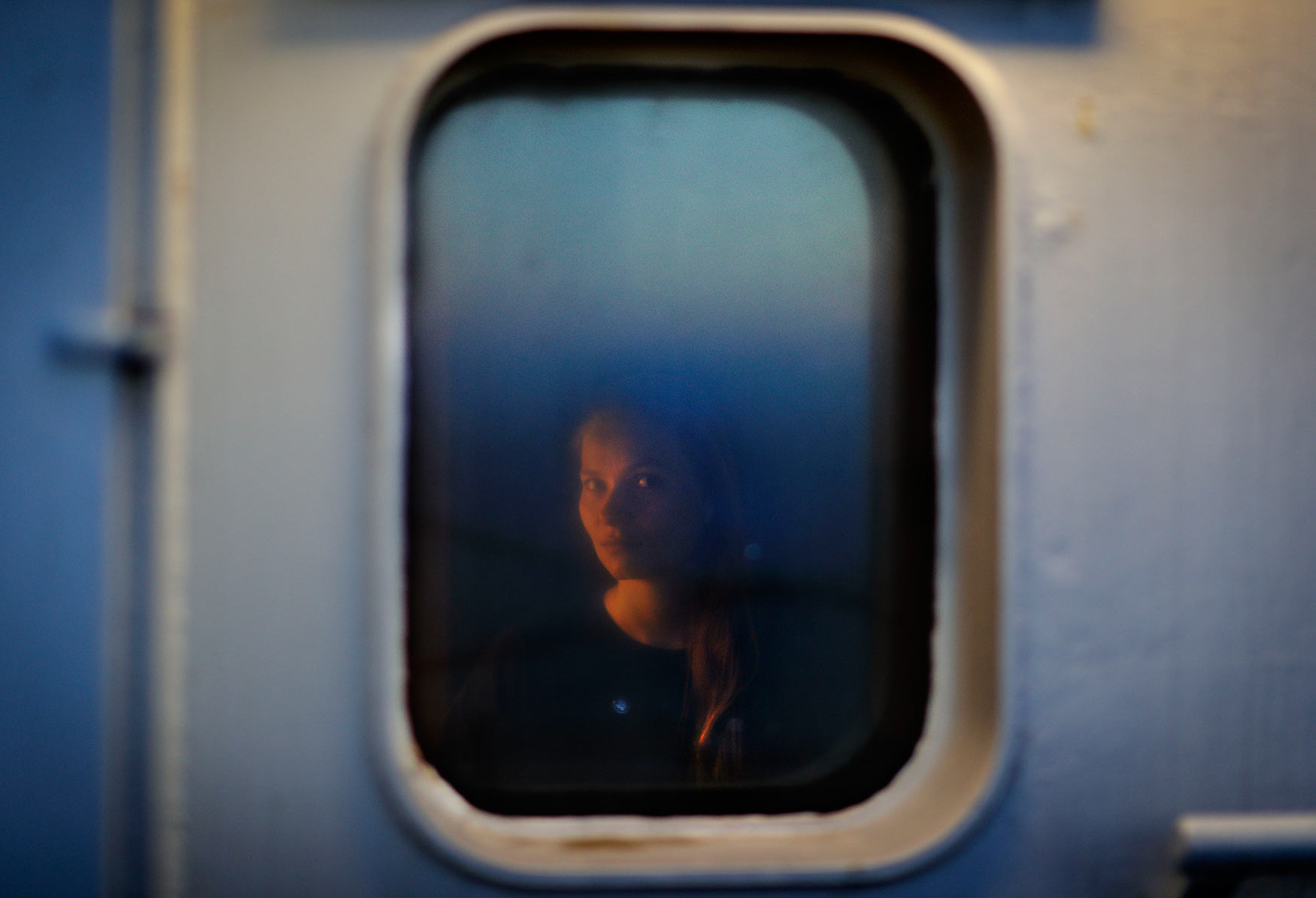





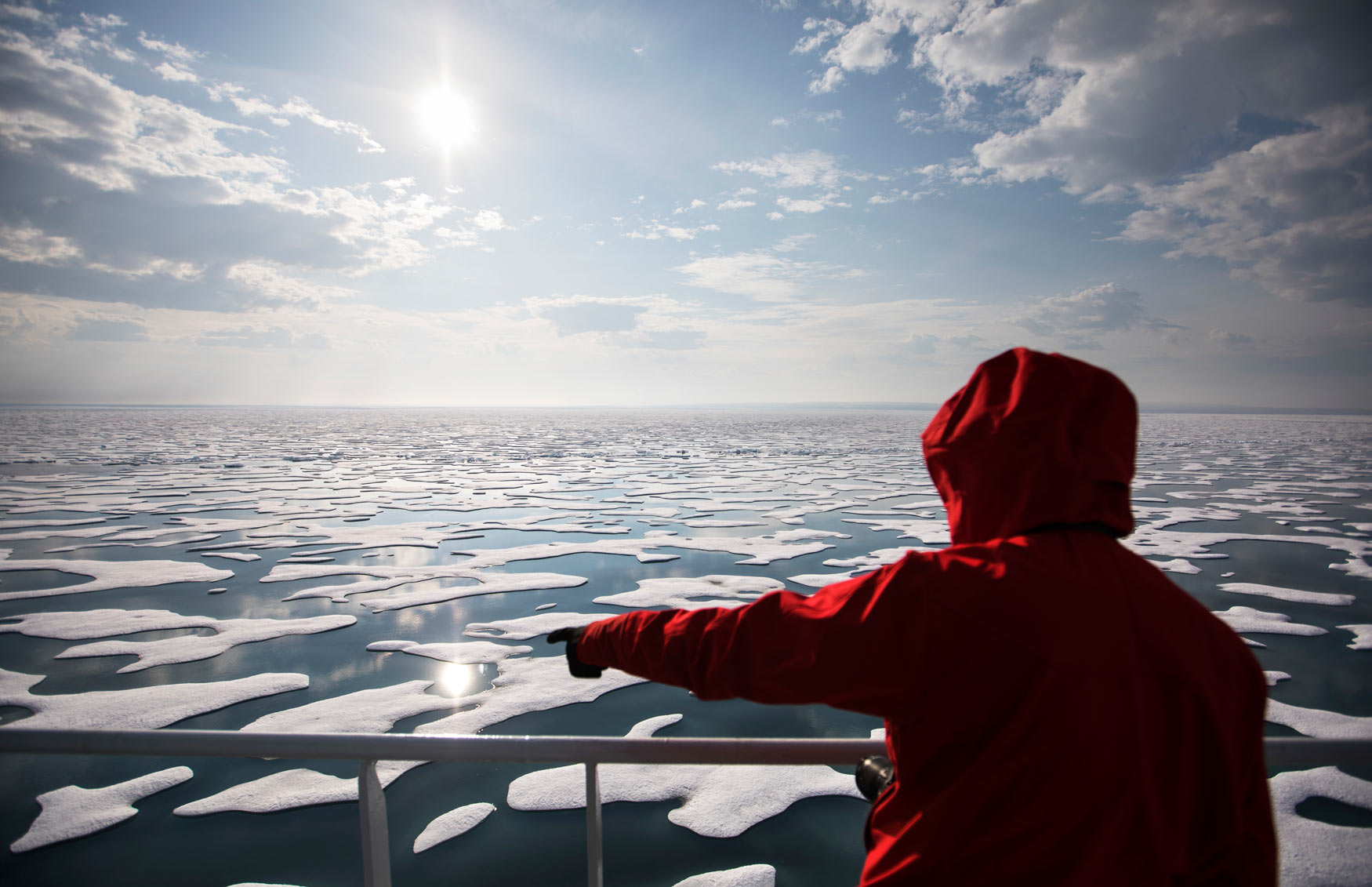

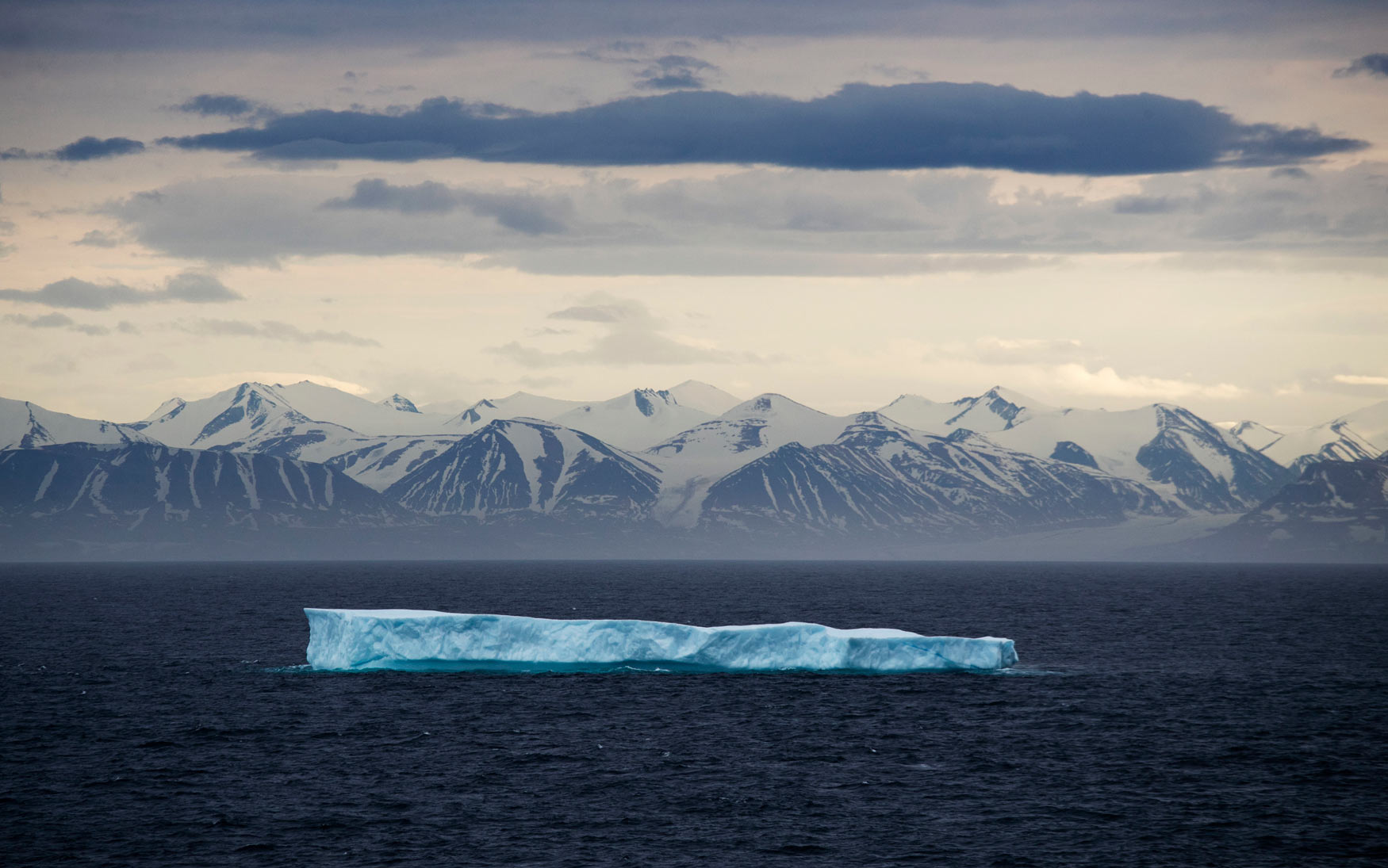
Photos David Goldman | Text Frank Jordans
After 24 days at sea and a journey spanning more than 10,000 kilometers (6,214 miles), the Finnish icebreaker MSV Nordica has set a new record for the earliest transit of the fabled Northwest Passage.